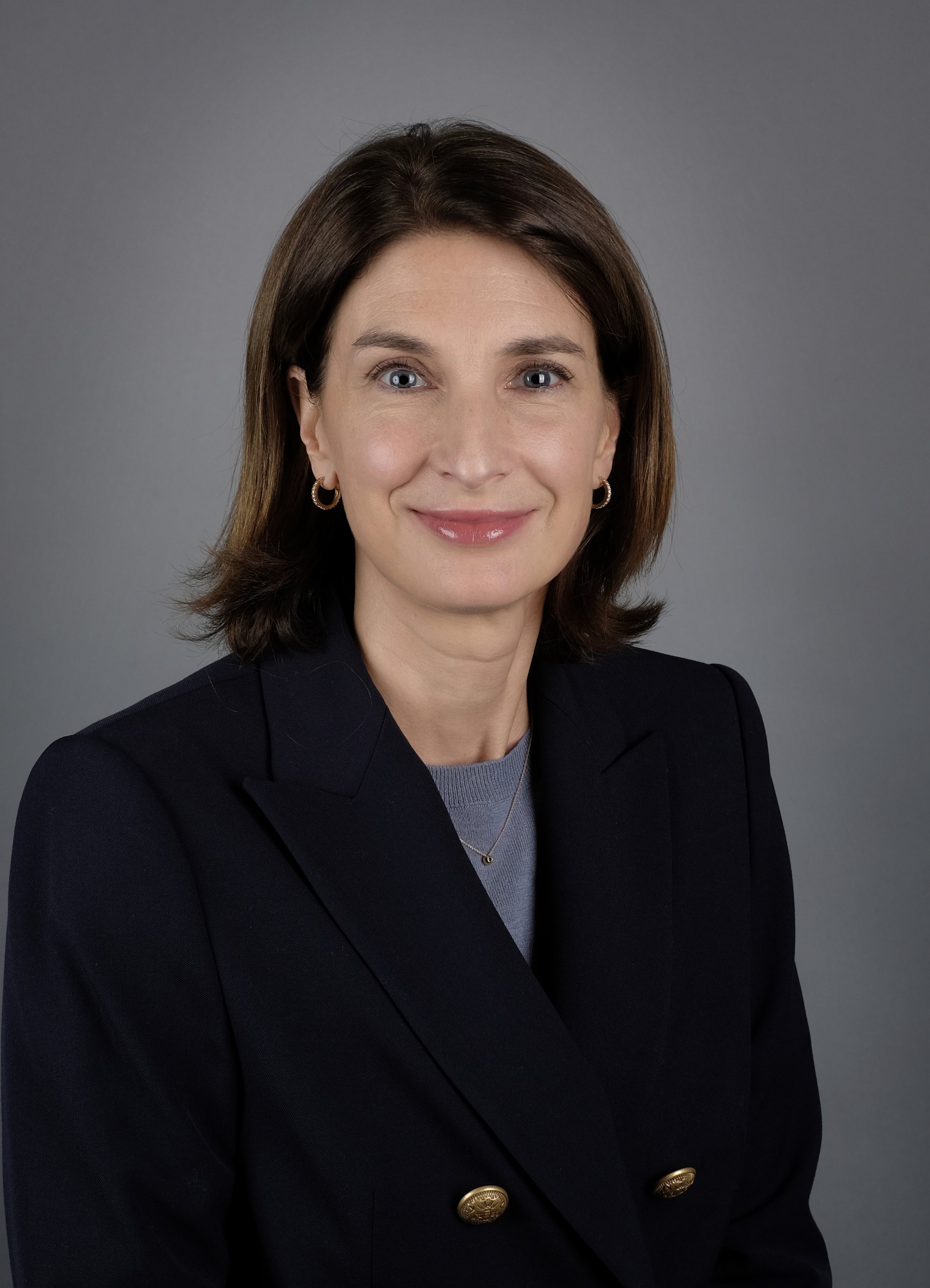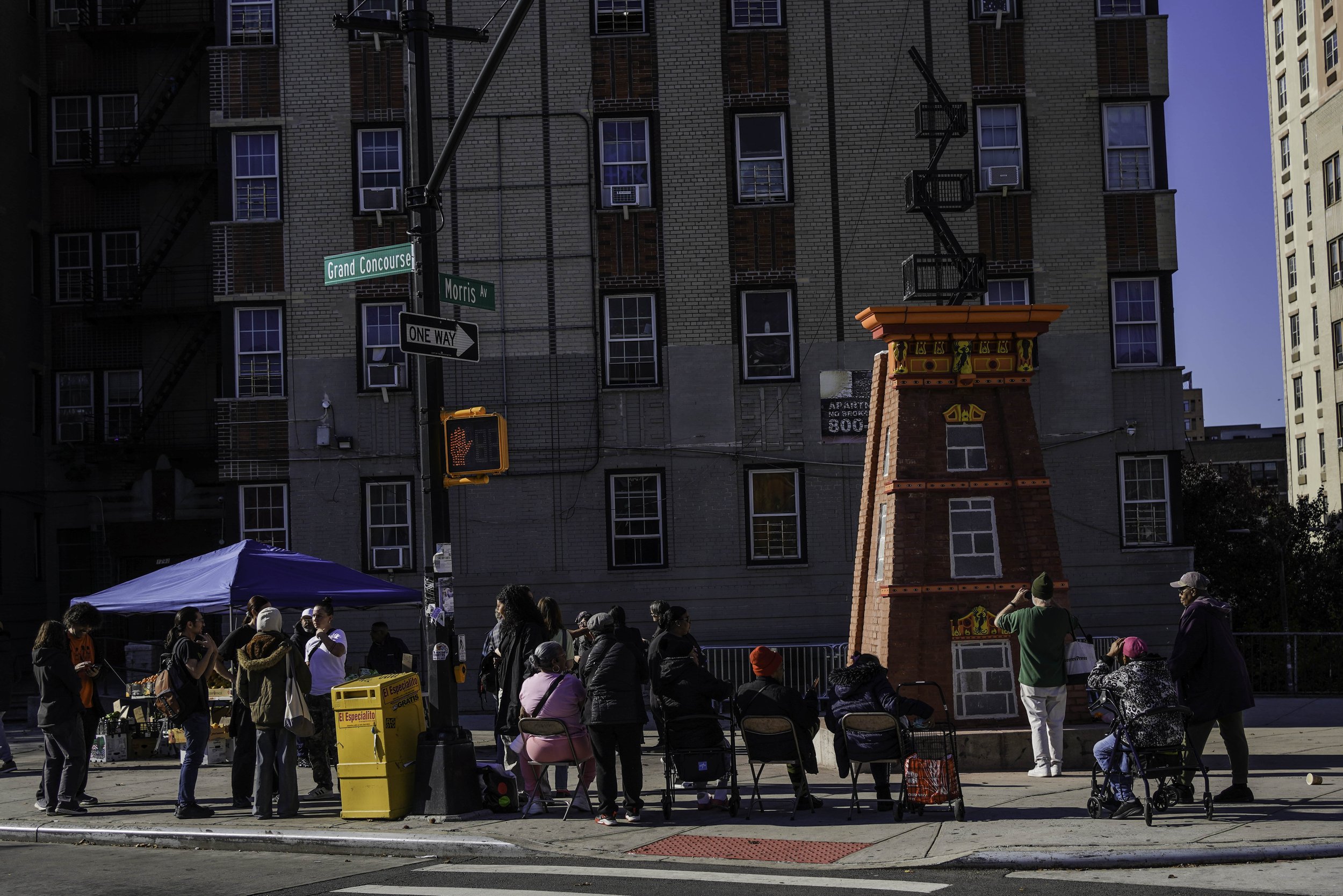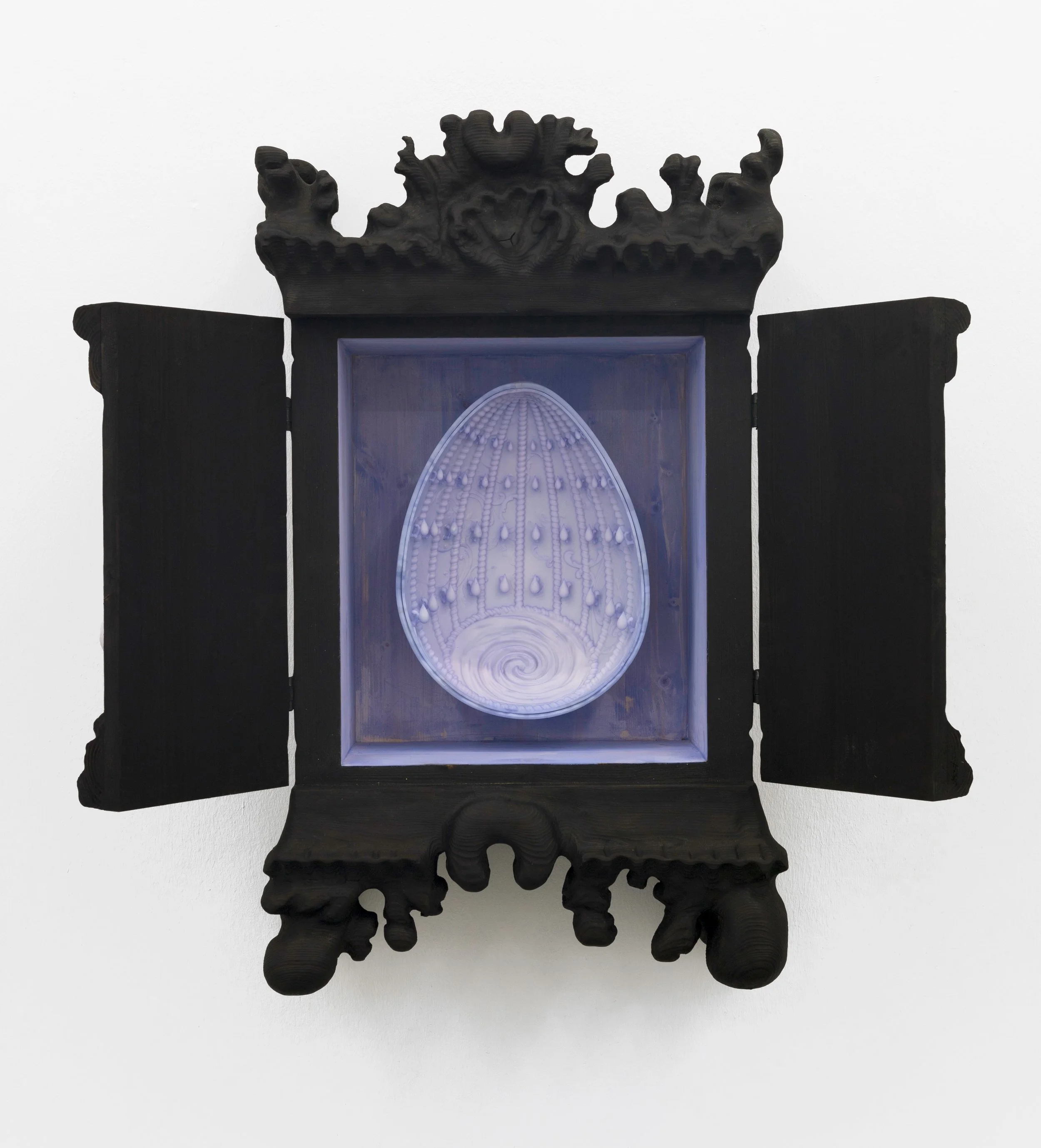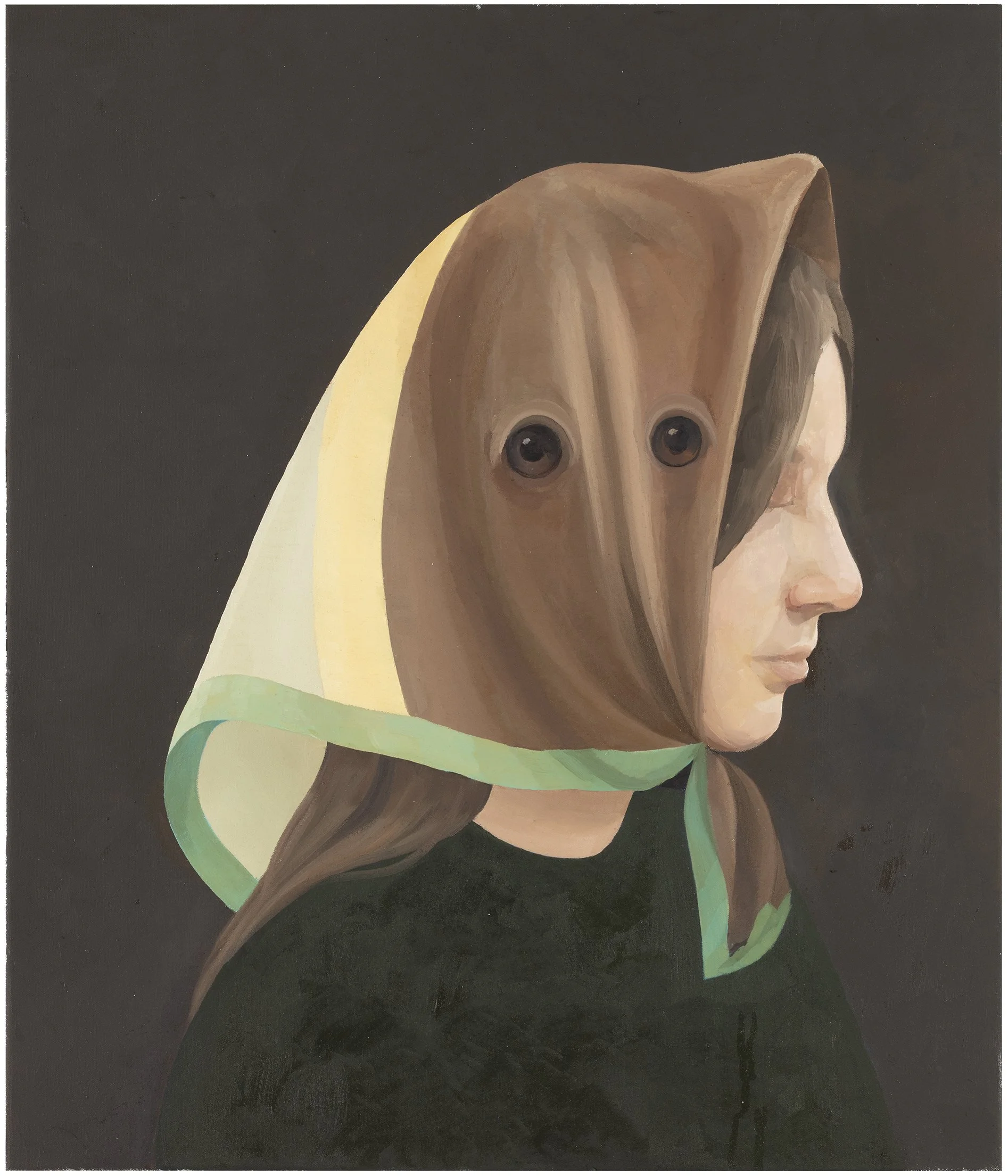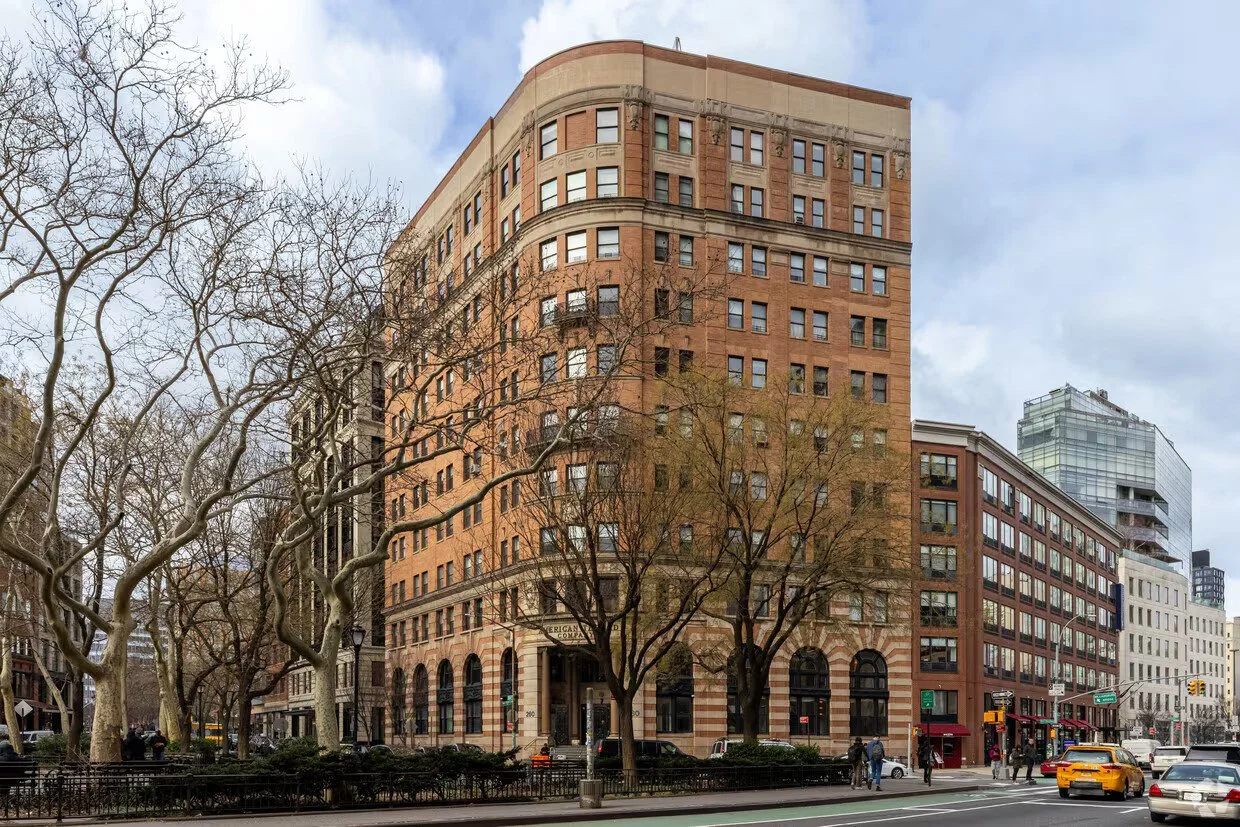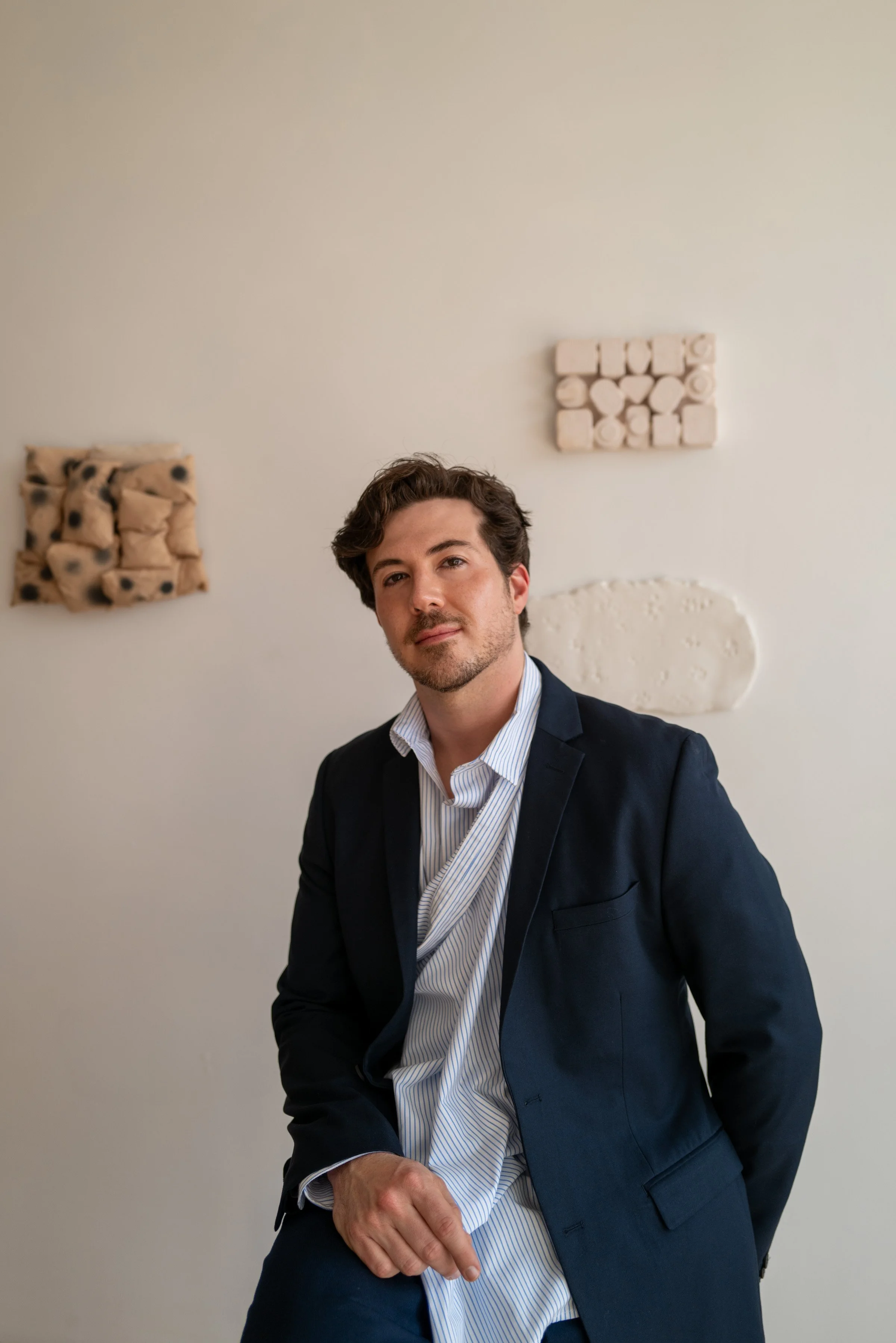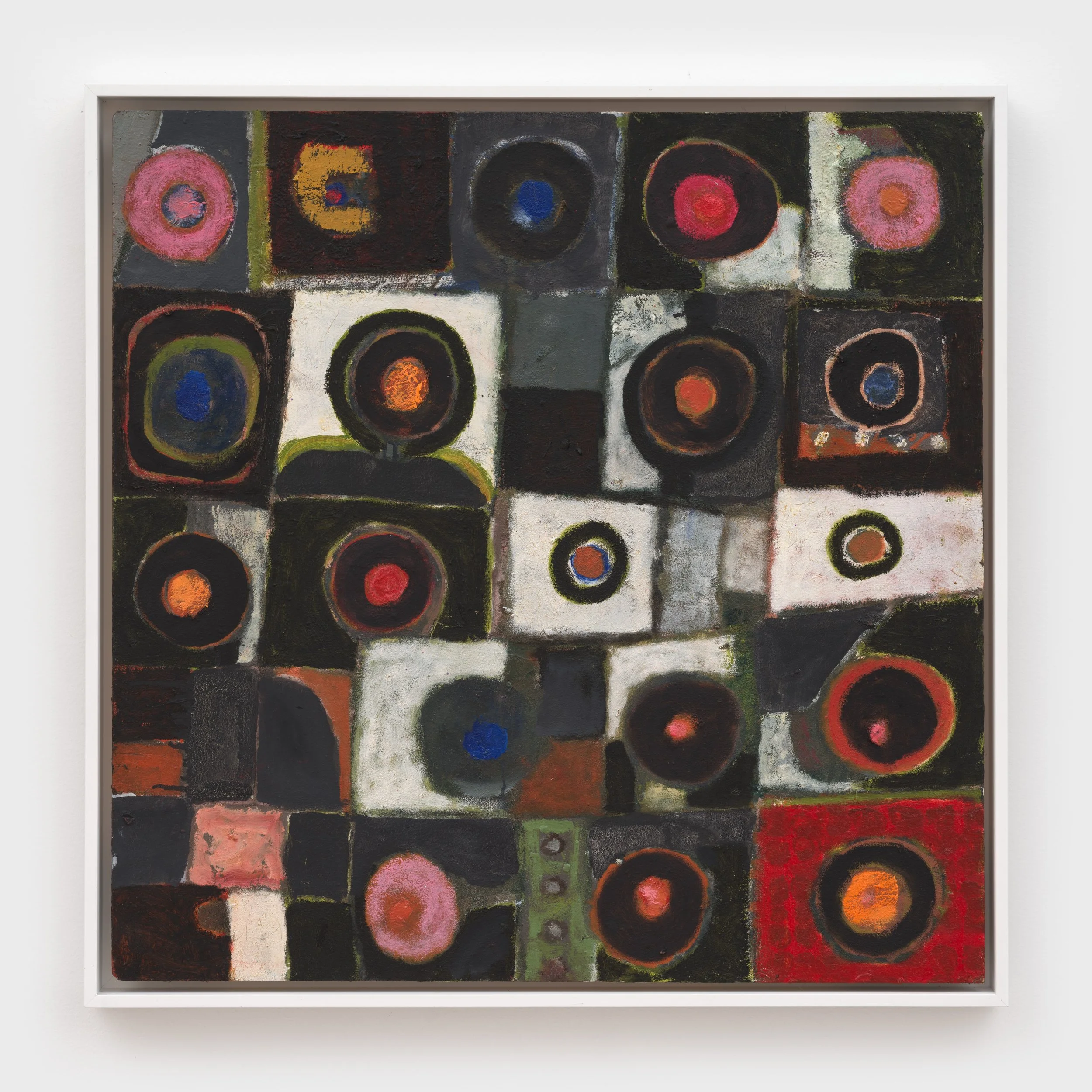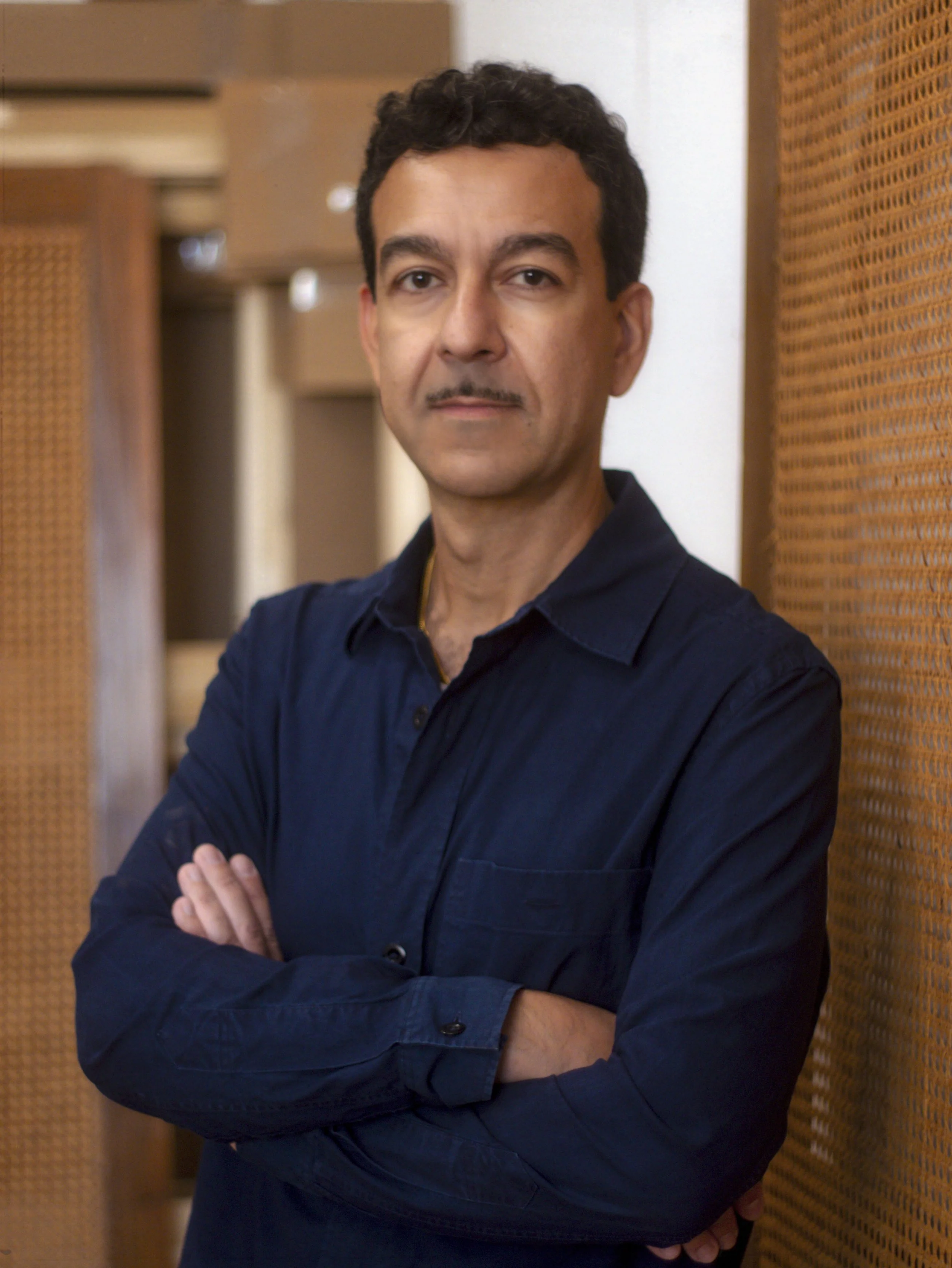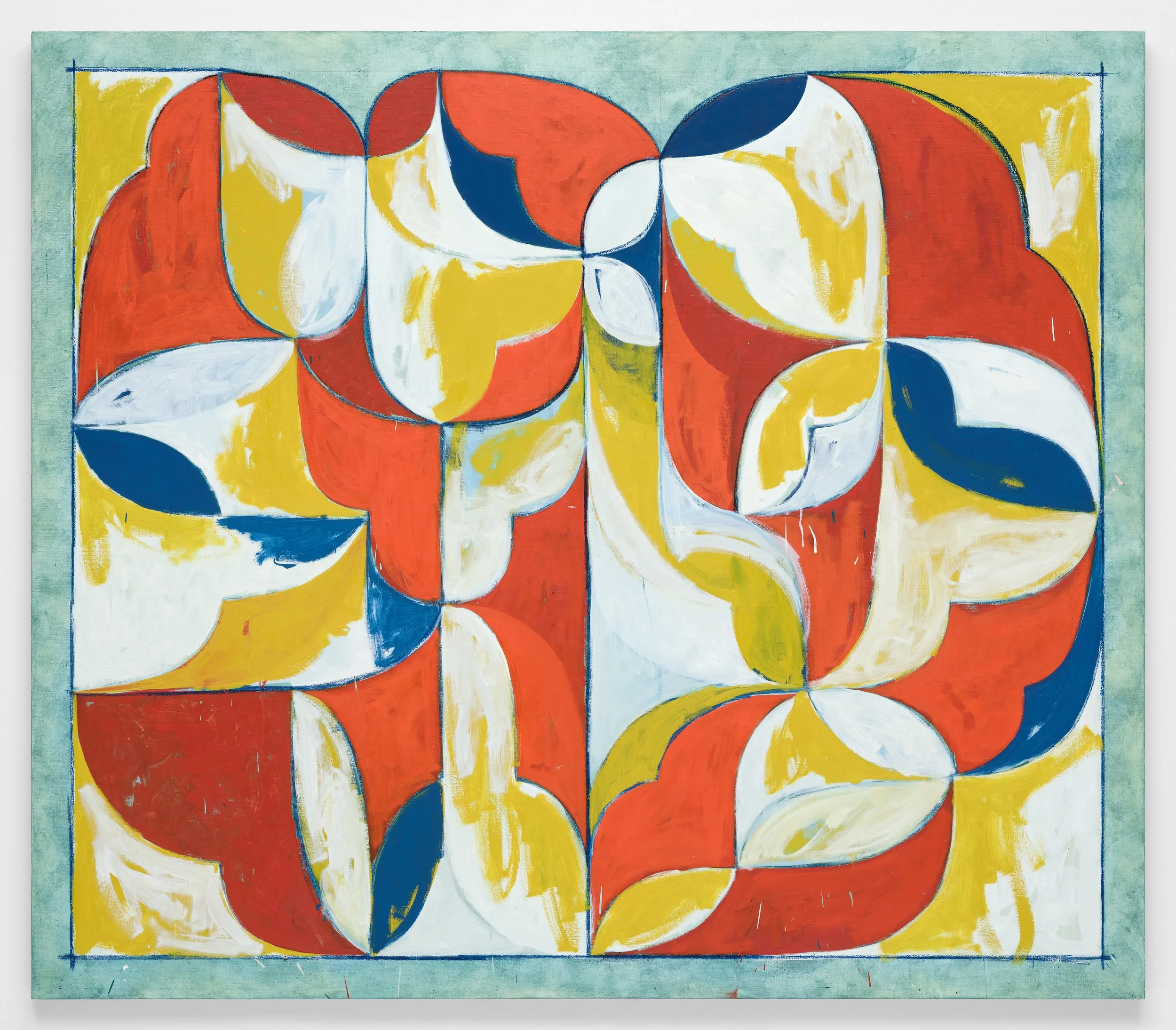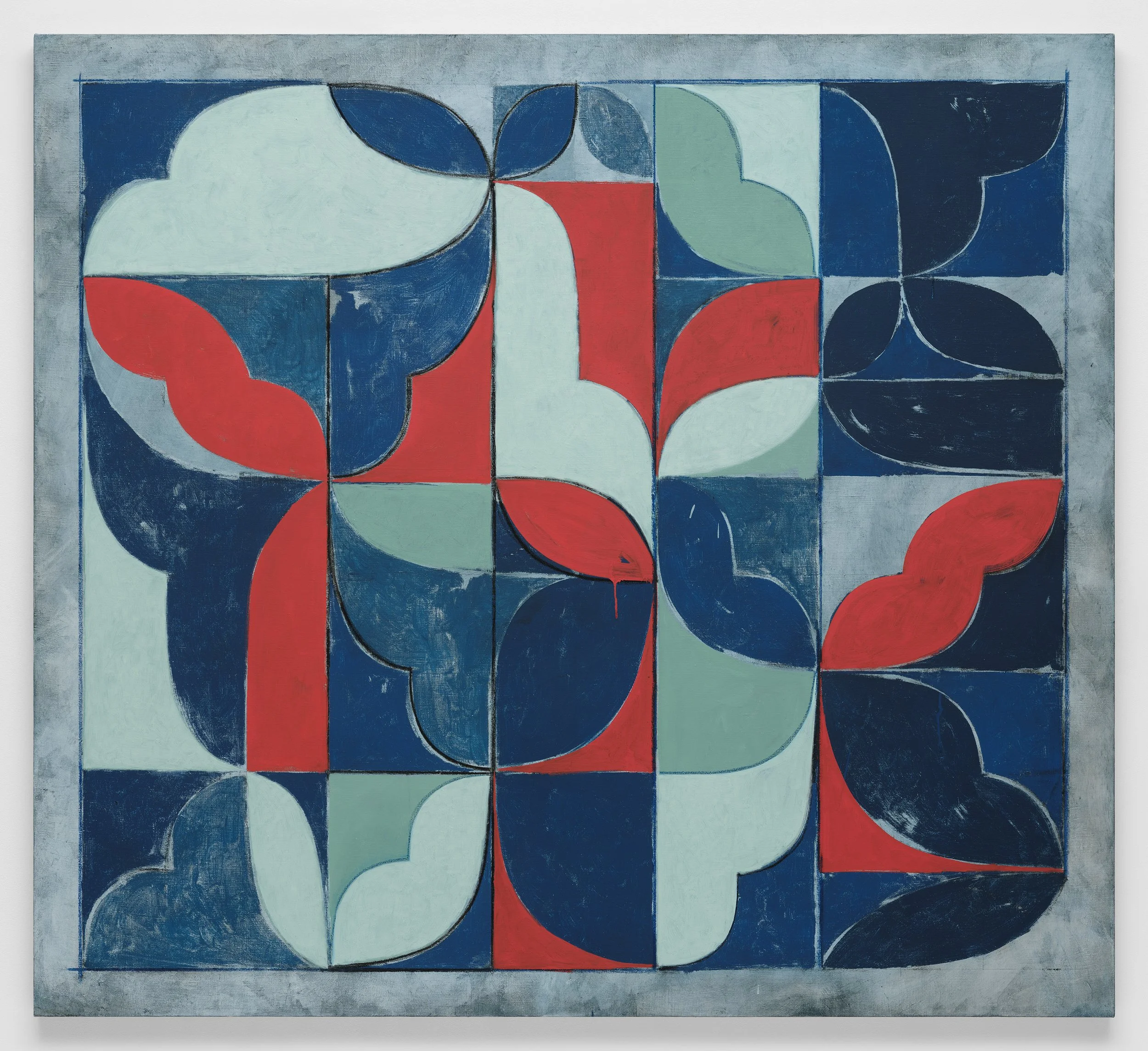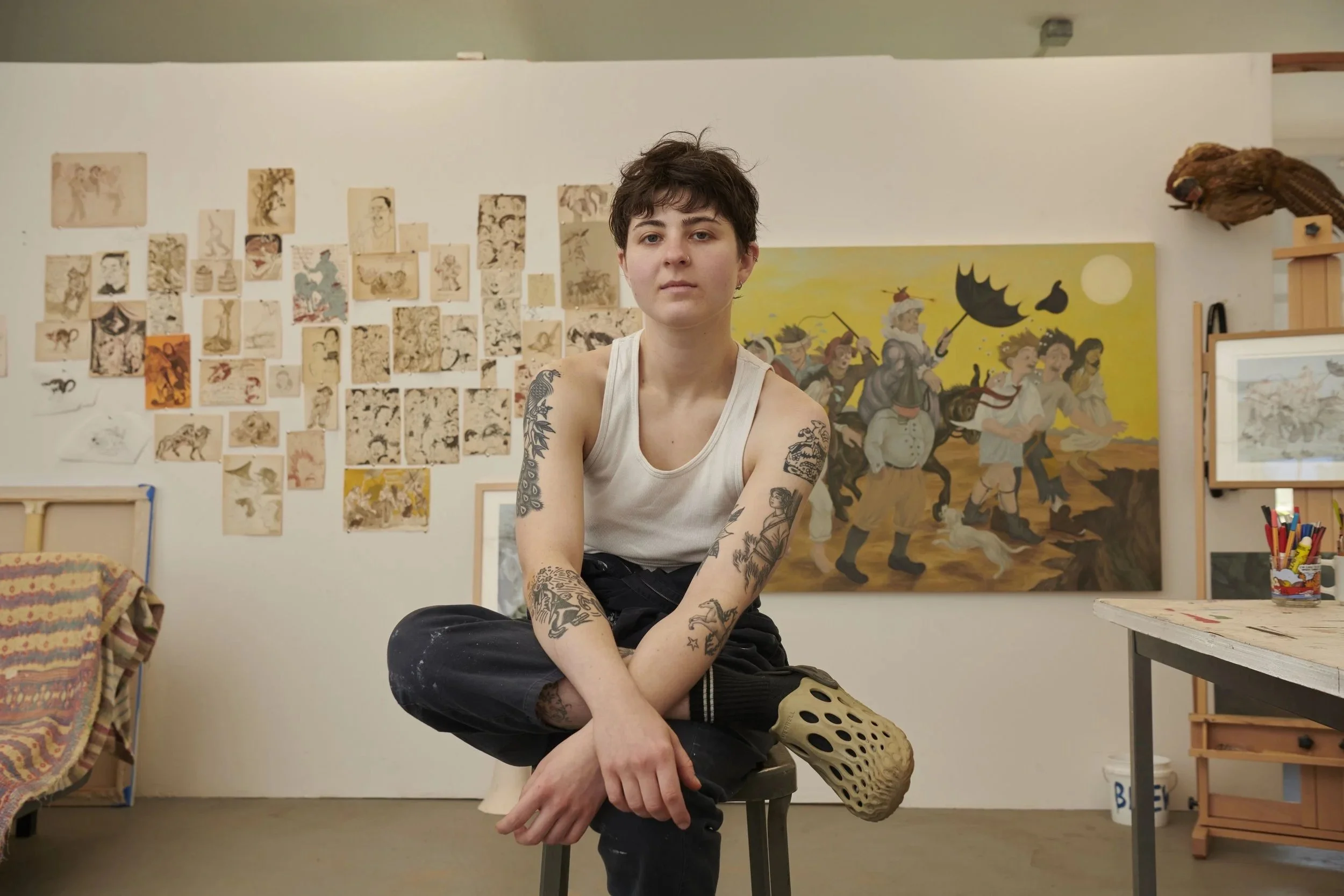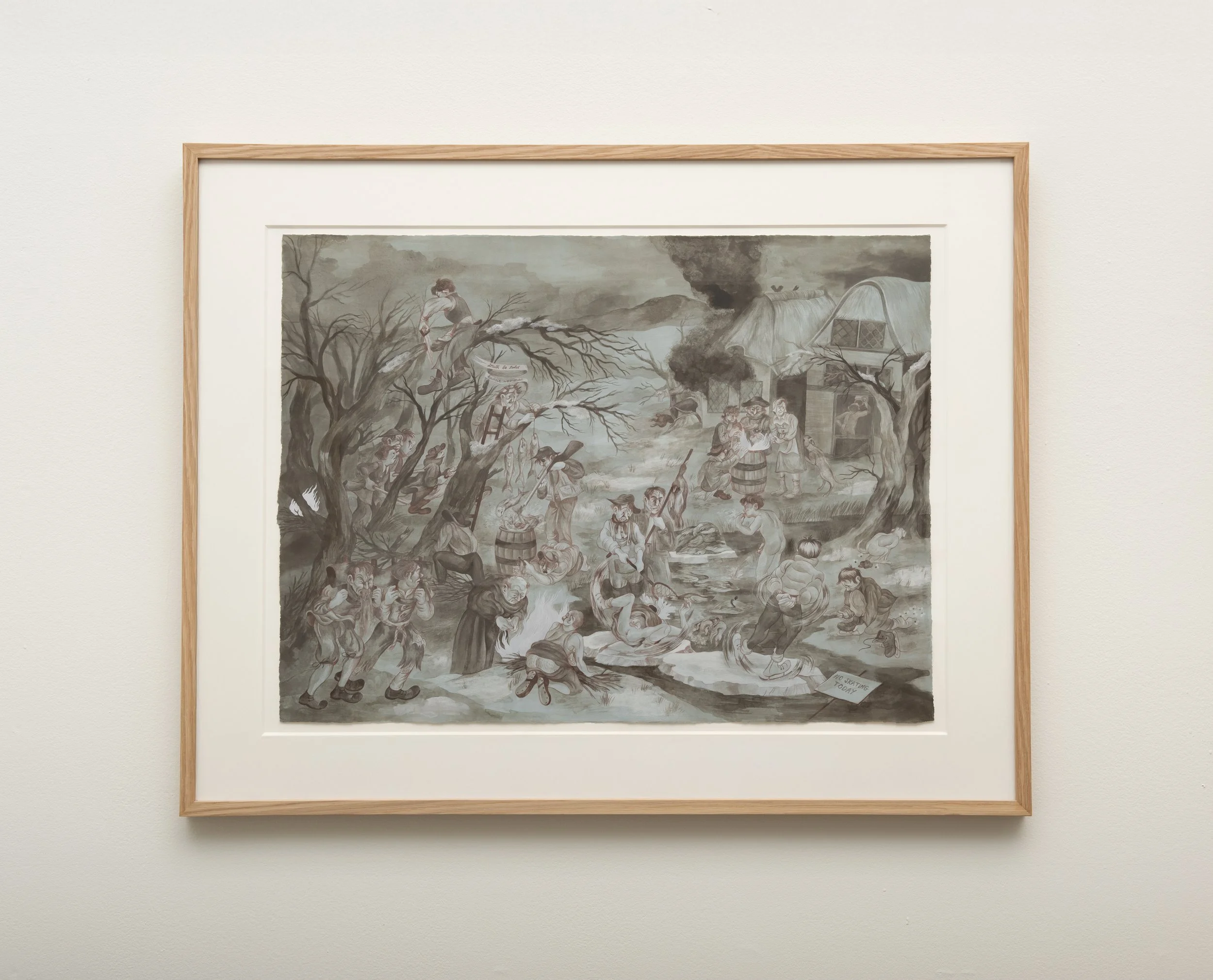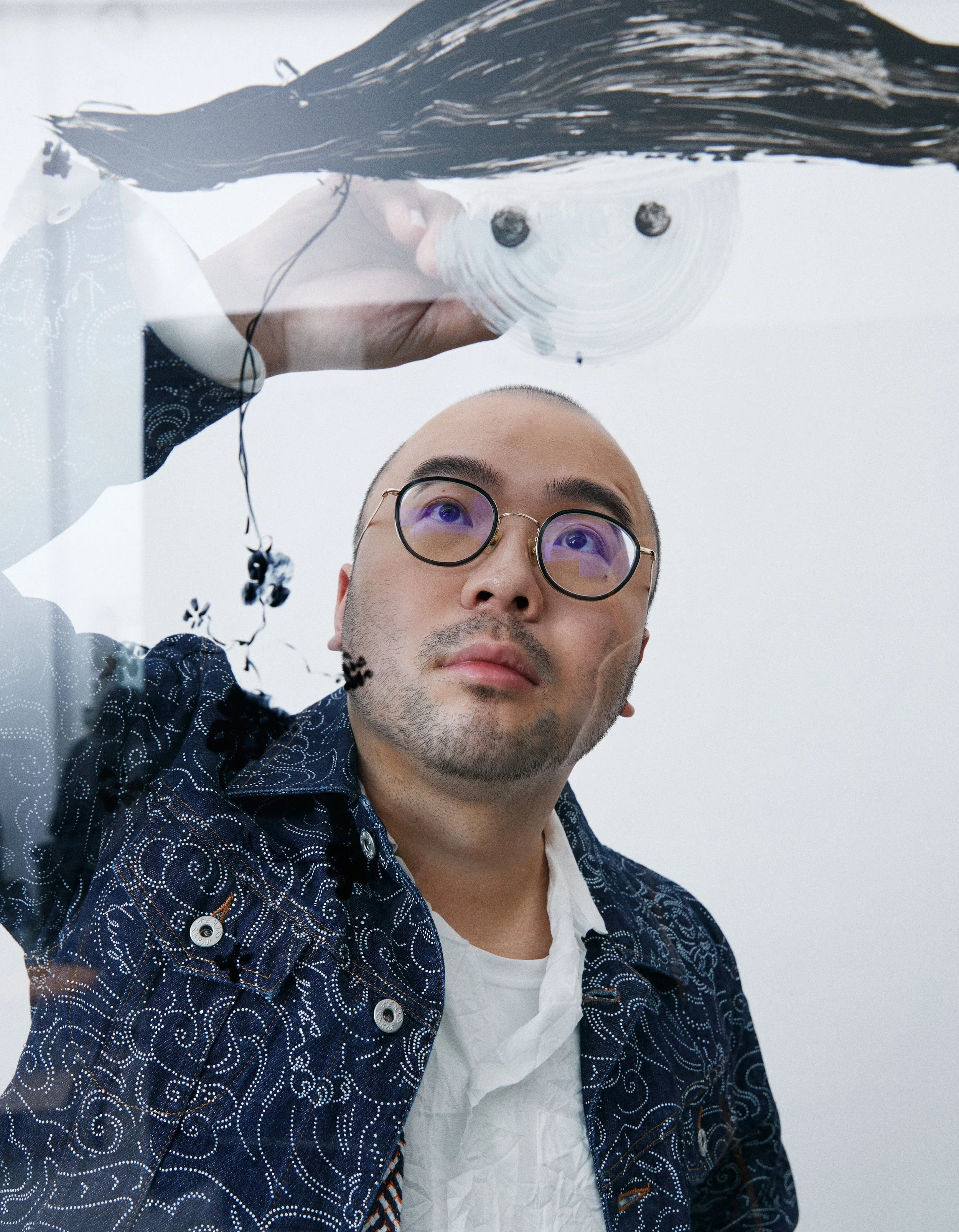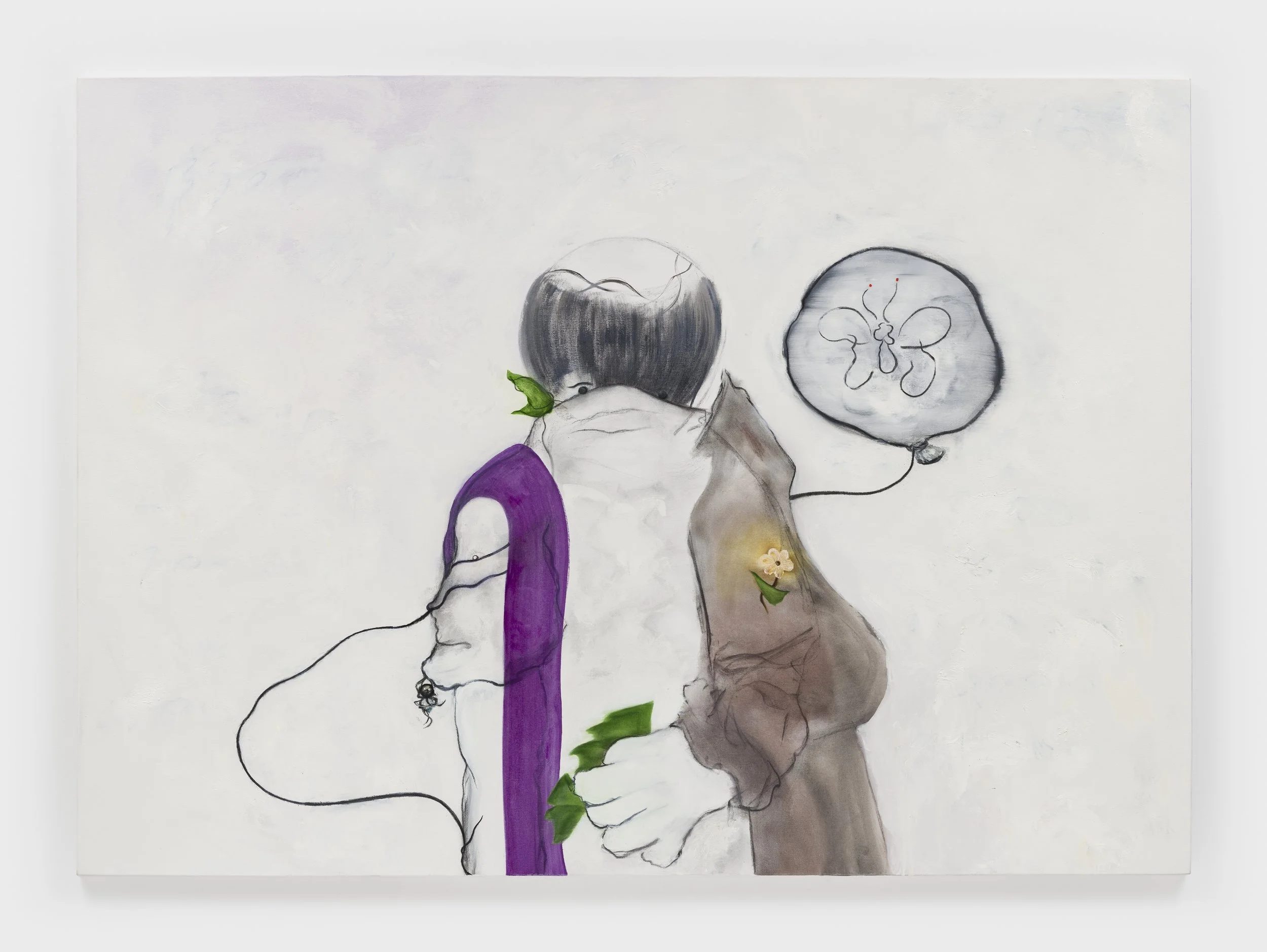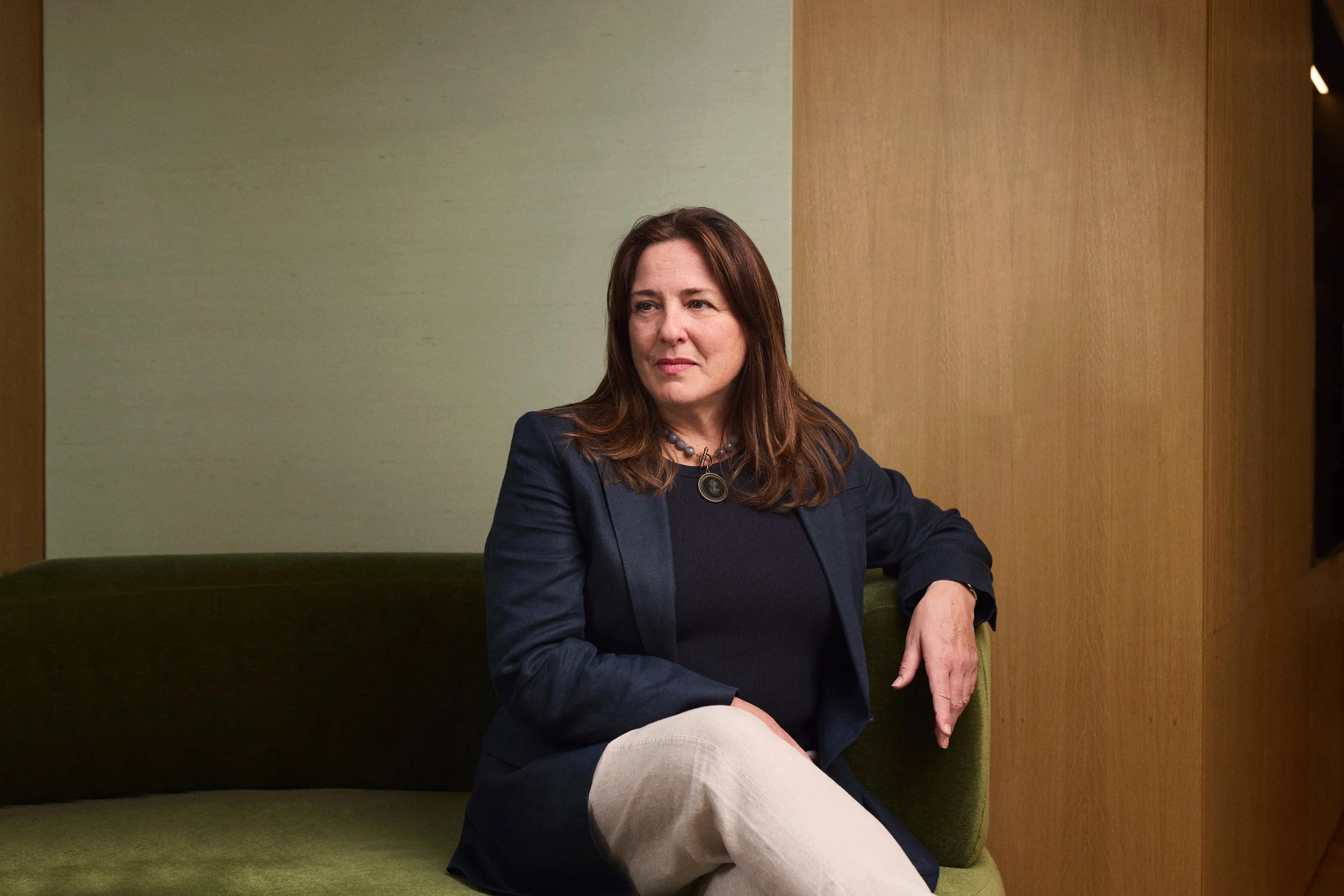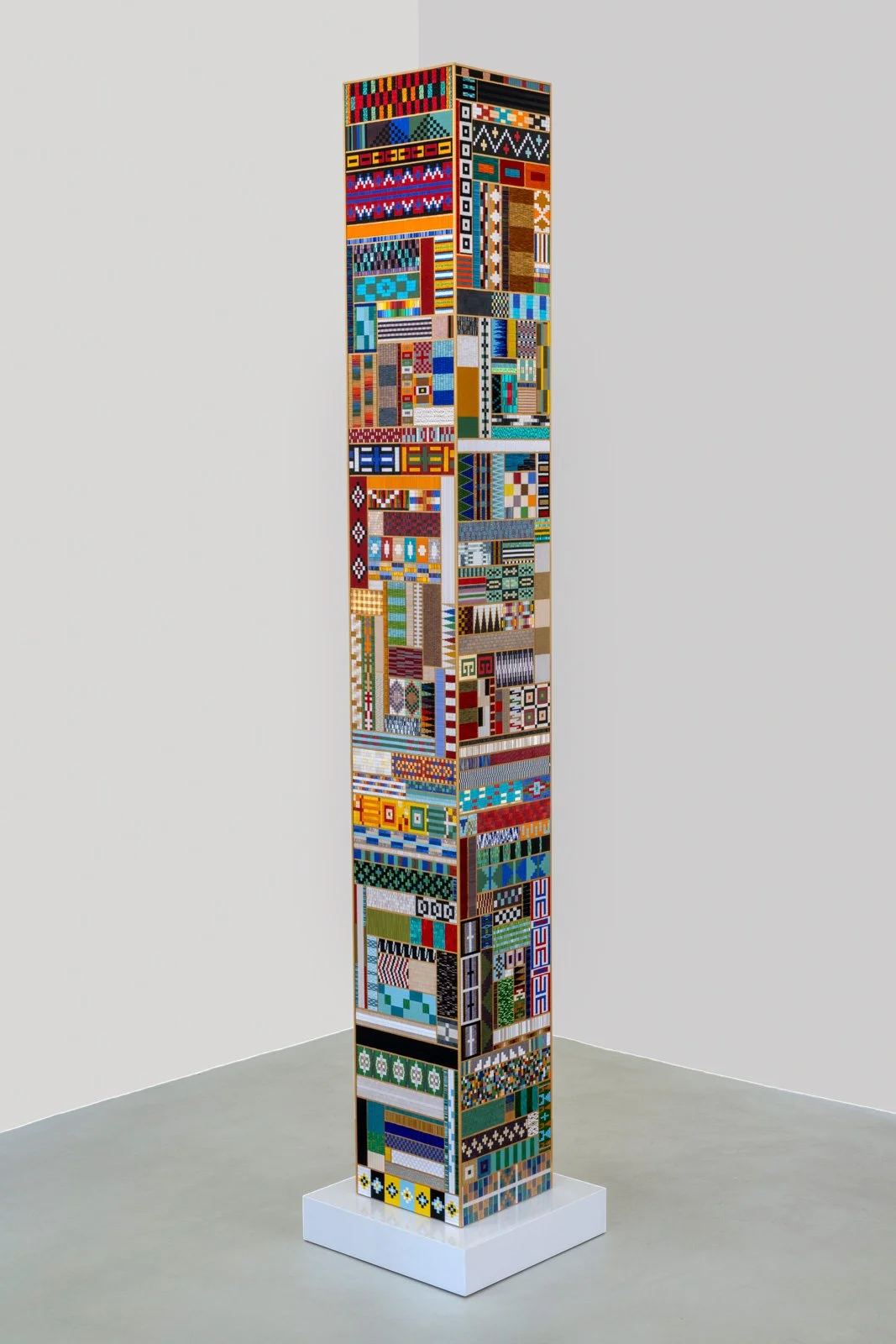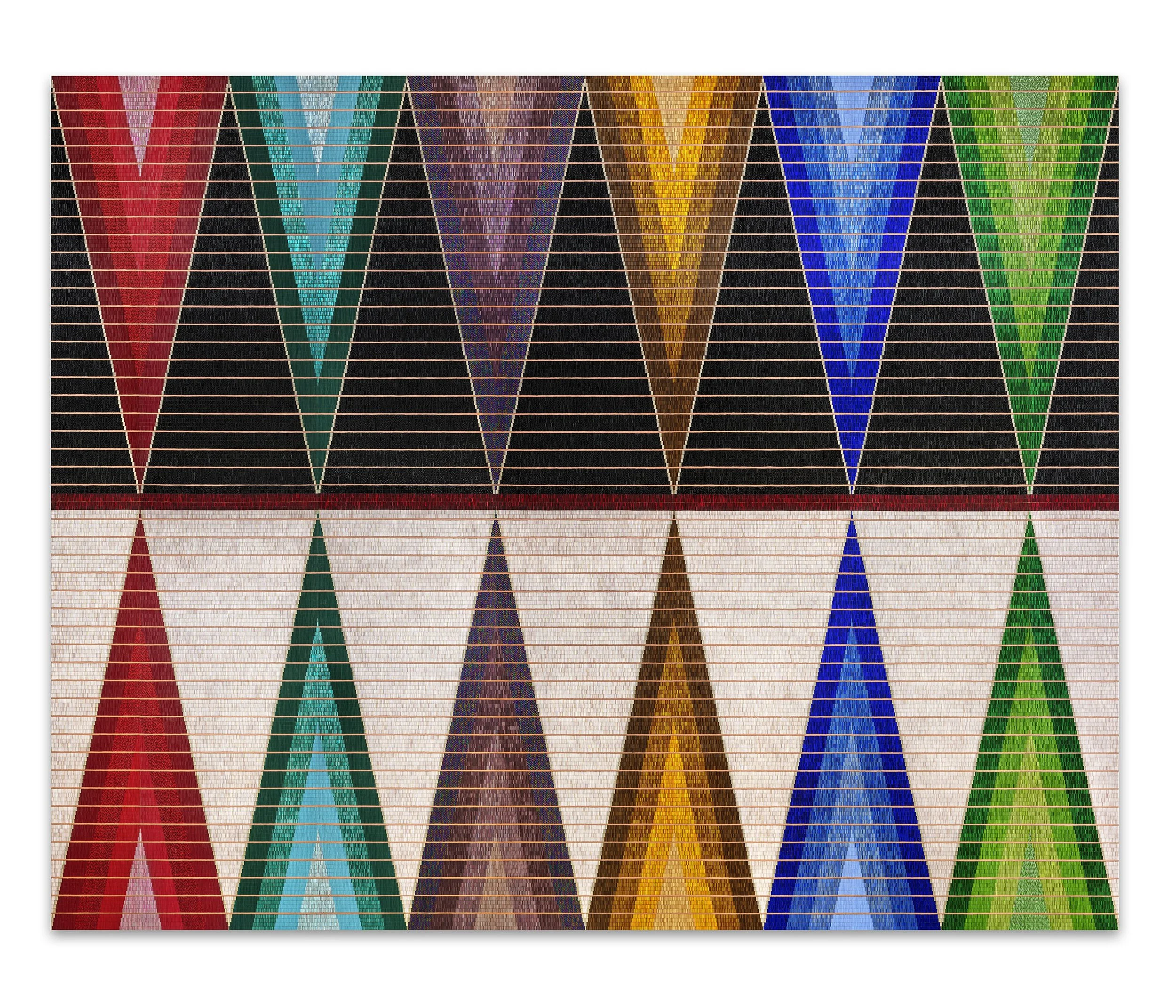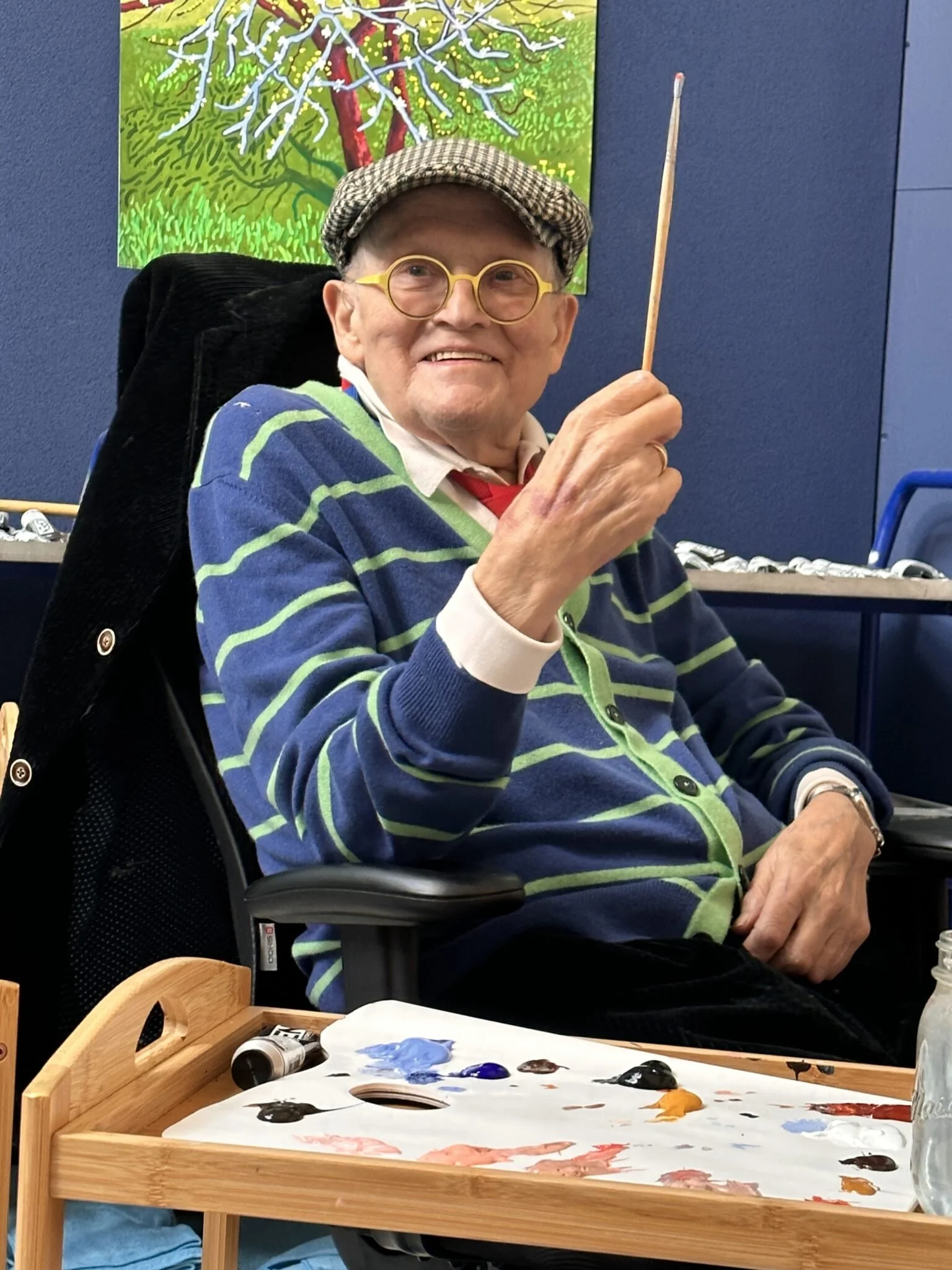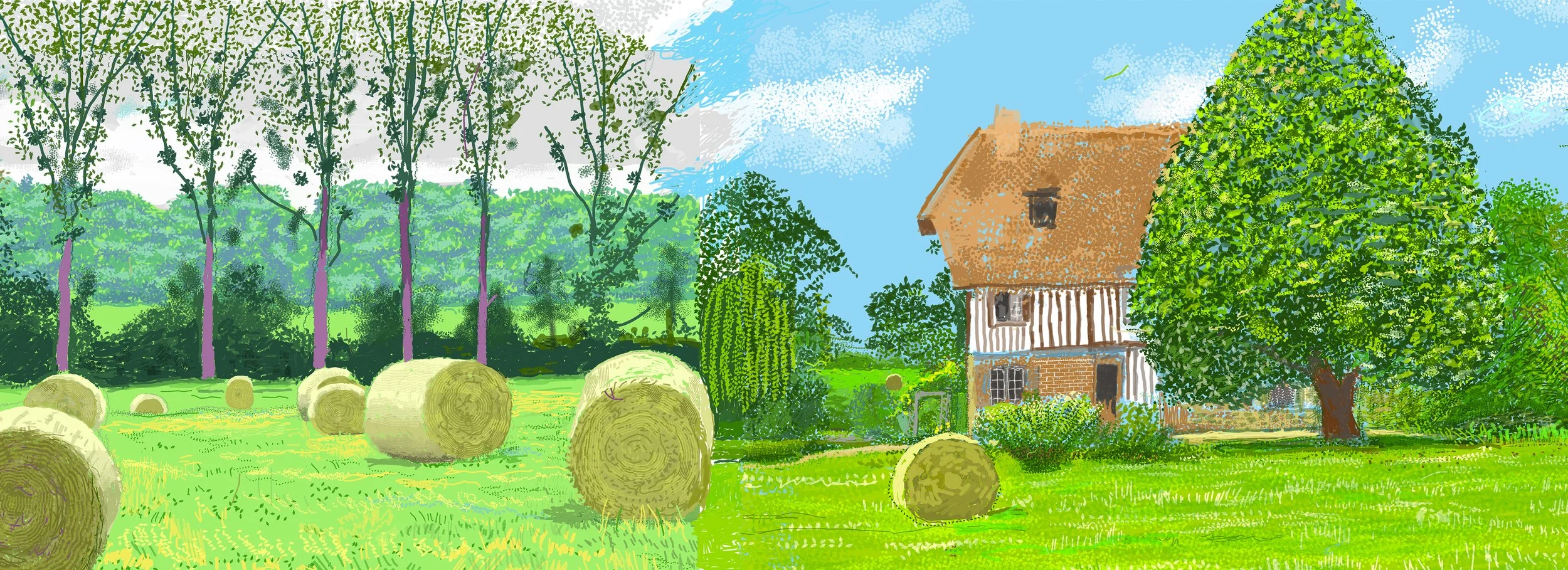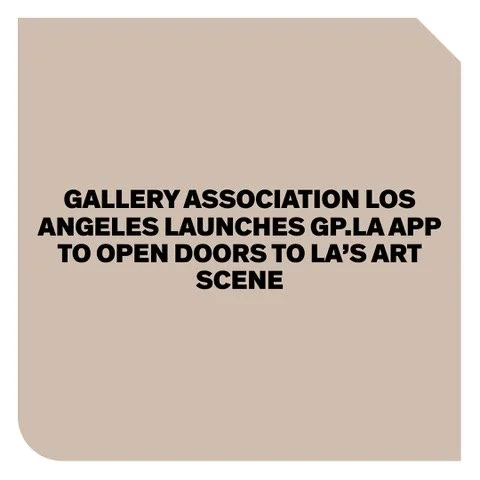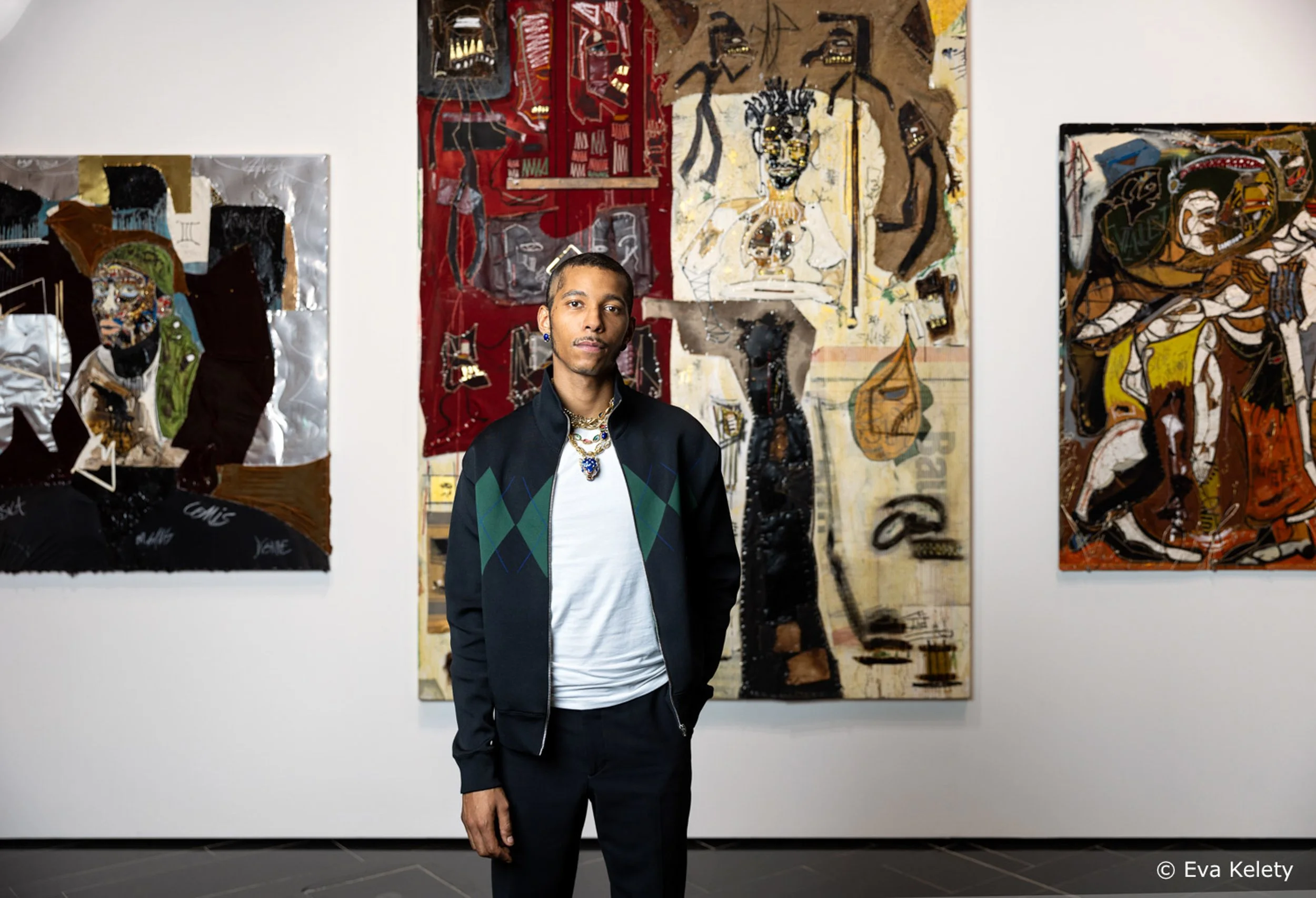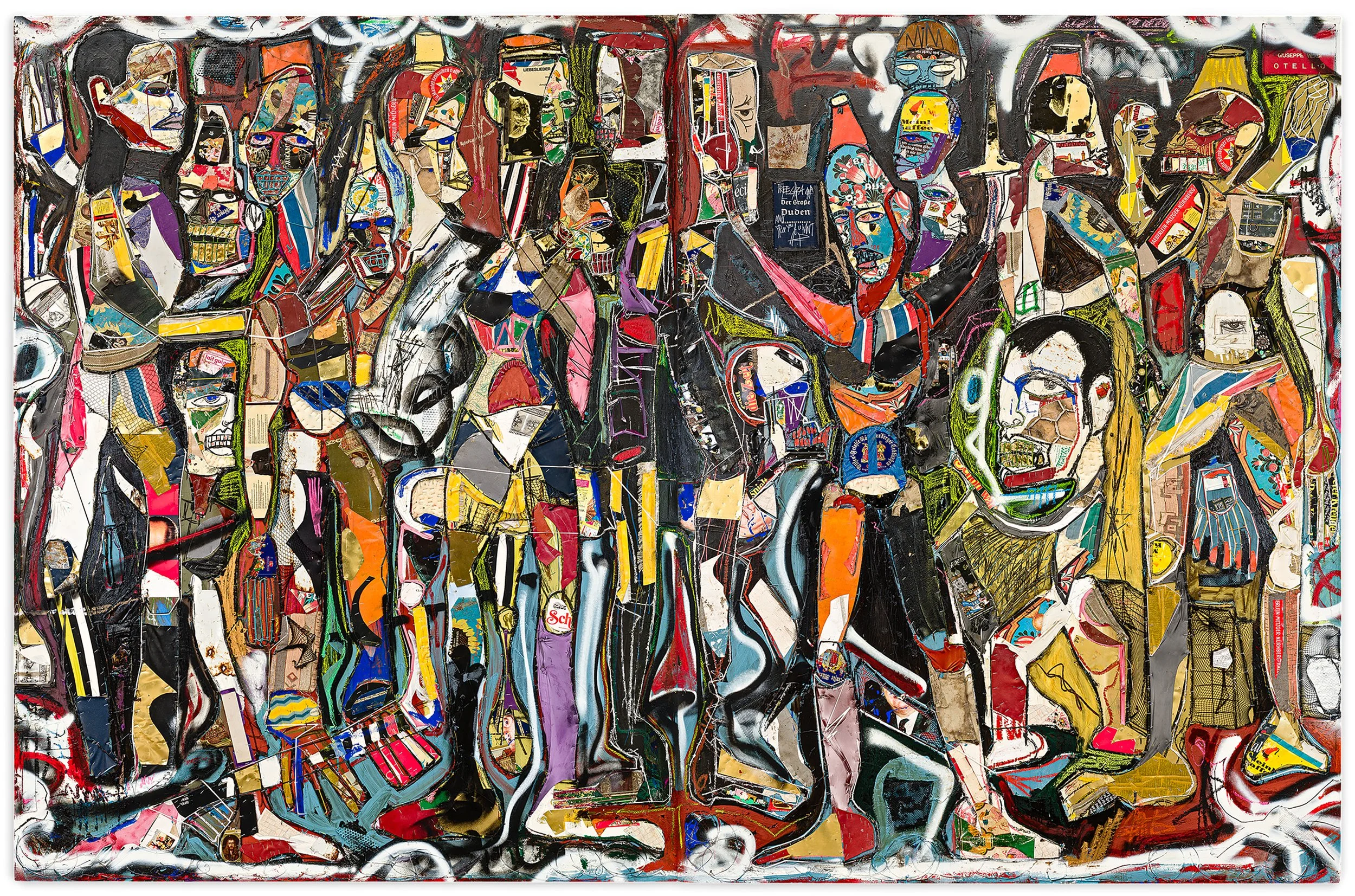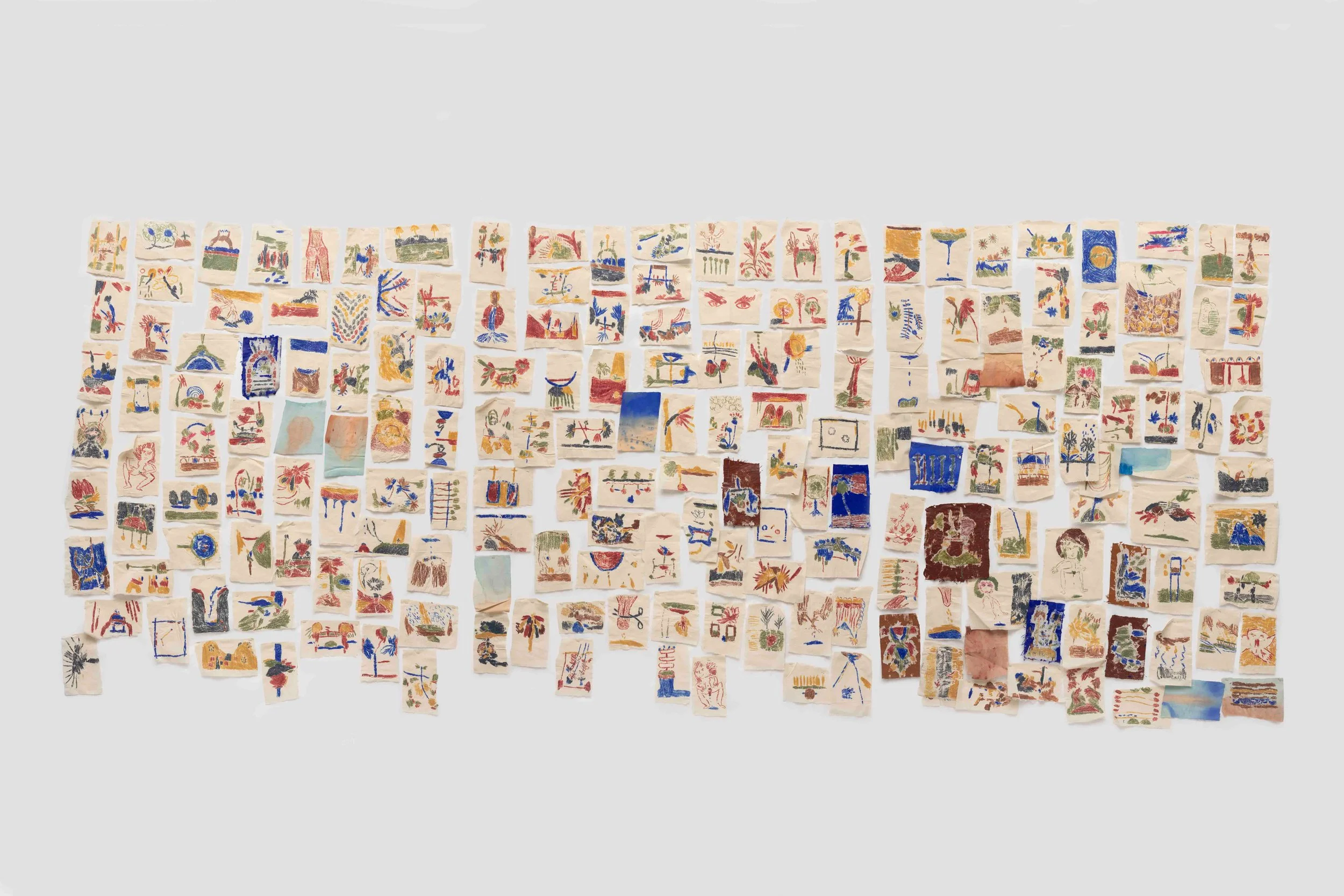Christie's appoints Bastienne Leuthe as International Director, Post-War and Contemporary Art
Bastienne Leuthe, newly appointed International Director, Post-War & Contemporary Art, Christie's, based in Germany.
Christie's is pleased to announce the appointment of Bastienne Leuthe as International Director, Post-War & Contemporary Art, based in Germany and reporting to Katharine Arnold, Vice Chairman 20/21.
Bastienne will work closely with Dirk Boll, Managing Director, Germany, Nina Kretzschmar, International Specialist, and regional representatives. She will lead and develop business getting for a portfolio of clients, bringing top objects and collections to market across global auctions and private sales.
Bastienne began her career at Sotheby's in Paris in 2005. She subsequently worked with the Contemporary Art Evening Sale team in London and was responsible for major single-owner auctions such as the Dürckheim, Lauffs, and Lenz collections. Most recently, she was Head of Contemporary Art for Sotheby's in Germany.
“We are delighted to welcome Bastienne Leuthe into this important new role for the region. Her appointment comes at a particularly meaningful moment for the art market, and her depth of expertise and long-standing success in bringing significant collections to market make her an excellent fit for our international team. As we continue to evolve and strengthen our 20/21 Department, we are confident that Bastienne’s leadership will bring fresh energy to the market and renewed momentum for our clients.”
About Christie’s
Founded in 1766, Christie’s is a world-leading art and luxury business with a physical presence in 46 countries throughout the Americas, Europe, Middle East, and Asia Pacific, and flagship international sales hubs in New York, London, Hong Kong, Paris and Geneva. Renowned and trusted for our expert live and online-only auctions, as well as bespoke Private Sales, Christie’s unparalleled network of specialists offers our clients a full portfolio of global services, including art appraisal, art financing, international real estate and education. Christie’s auctions span more than 80 art and luxury categories, at price points ranging from $500 to over $100 million. Christie’s has sold 7 of the 10 most important single-owner collections in history, achieved the world record price for an artwork at auction, launched the first fully on-chain auction platform dedicated to exceptional NFT art and manages an investment fund to support innovative startups in the art market. Christie’s is also committed to advancing responsible culture throughout its business and communities worldwide. To learn more, browse, bid, discover, and join us for the best of art and luxury at christies.com or by downloading Christie’s apps. The auction house can also be found on Facebook, Instagram, YouTube, and X.
Artist Shellyne Rodríguez Unveils “Phoenix Ladder: Monument to the People of the Bronx” at Grand Concourse & Morris Avenue
Photo by Andrés Rodríguez von Rabenau
Bronx, NY —A new permanent public sculpture, Phoenix Ladder: Monument to the People of the Bronx, commissioned by the city of New York’s Department of Cultural Affairs Percent for Art program will be unveiled to the community by artist Shellyne
Rodríguez this Saturday, November 8th from 12:00 – 3:00 PM on the corner of Grand Concourse & Morris Avenue. The work stands as a powerful tribute to the generations of Bronx residents who have endured, rebuilt, and thrived in the face of adversity. Constructed from brick, steel, and terracotta, Phoenix Ladder takes the form of a towering structure with a ladder ascending skyward—a potent metaphor for collective struggle, resilience, and renewal. Rising from the ground like a beacon, the monument evokes both the physical and spiritual rebuilding of the Bronx following the landlord fires of the 1970s and the continued fight against displacement and gentrification. “This sculpture is dedicated to all of us — the people of the Bronx, ” Rodríguez shares. “Those whose grandmothers fled Jim Crow, those who came from Puerto Rico, the Dominican Republic, Ghana, Yemen, Mexico, and beyond — all of us who now call this place home. I hope this sculpture serves as a space to gather, to plan, to study, to pray, and to fight back.
”
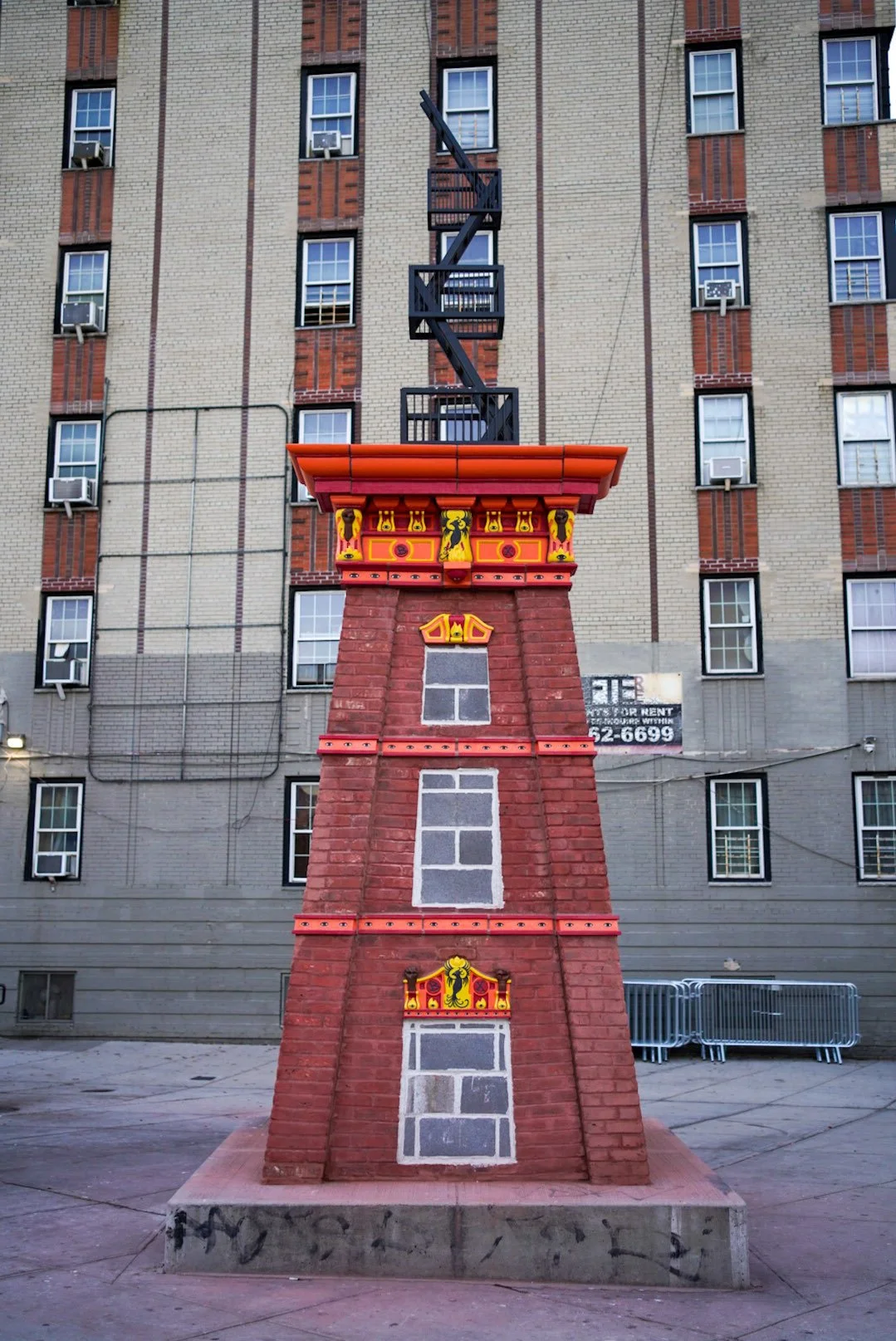
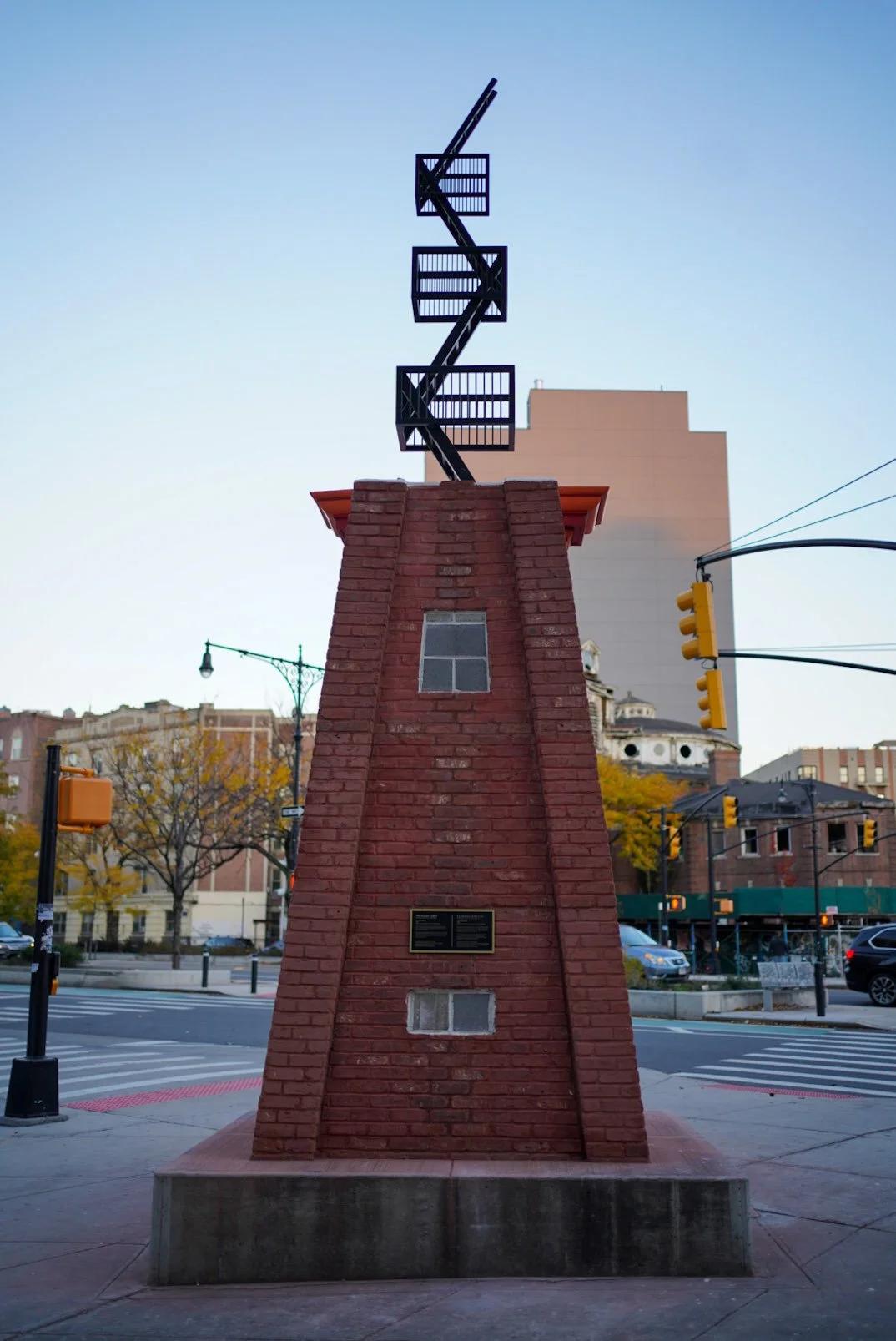




Photo by Andrés Rodríguez von Rabenau
Deeply rooted in the histories of migration, resistance, and solidarity, Rodríguez’s monument serves as both a testament and a call to action. The artist began conceptualizing Phoenix Ladder seven years ago, envisioning it as a communal landmark that reflects the Bronx’s interwoven pasts and futures — from its Black and Caribbean diasporic legacies to the diverse immigrant communities that define the borough today. Through its layered symbolism, the sculpture embodies Rodríguez’s commitment to public art as activism, merging aesthetics with a radical ethic of care. It reclaims the language of the monument — often reserved for colonial or patriarchal figures — and instead centers the people who make and sustain the Bronx. The unveiling will include a day of programming on Saturday, November 8, from 12:00–3:00 PM, with remarks by the artist, and local community members as well as participatory performances and activities that reflect the collective energy of the project. Phoenix Ladder will remain a permanent fixture in the Bronx, inviting future generations to see themselves within its bricks and steel — not as subjects of a monument, but as the community it represents.
About the Artist
Shellyne Rodriguez (b. 1977) is a Bronx-based artist, educator, historian, writer, and community organizer who works in a variety of media, including drawing, painting, collage, and sculpture. Rodriguez stewards the histories and stories of people that have shaped her lived experience, describing her practice as “the depiction and archiving of spaces and subjects engaged in strategies of survival against erasure and subjugation. ” Through her multidisciplinary practice, Rodriguez documents the ways in which the diverse social fabric of the South Bronx is rewoven as the people and cultures coexist. Rodriguez utilizes language as well as cultural and sociopolitical references to create unified portraits of individuals from various communities formed in what she describes as the “periphery of empire. ” Engaging with the legacy of the Ashcan School, who bore witness to the rise of the modern metropolis and depicted how the poor and working class in New York enclaves were transformed by this, Rodriguez views figures such as Alice Neel, Jane Dickson, and Martin Wong as an extension of this tradition and situates her practice alongside them. Rodriguez earned her MFA from Hunter College in studio art and her BFA in visual and critical studies from the School of Visual Arts. Her work has been shown at The Nathan Cummings Foundation, New York, NY; Cue Art Foundation, New York, NY; Casa Warmu, Quito, Ecuador; Queens Museum, New York, NY; and El Museo del Barrio, New York, NY, among others. Rodriguez has held residencies at Hunter College, New York, NY and the Shandaken Project, Catskills, NY. She is an Adjunct Professor at the Cooper Union and has been a teaching artist at the Bronx Museum and Museum of Modern Art. Works by Rodriguez have recently been featured in group exhibitions at the Museum of the City of New York, New York, NY; Virginia MoCA, Virginia Beach, VA; National Academy of Design, New York, NY; and Museo de Arte Contemporáneo de Puerto Rico, San Juan, Puerto Rico, among others. Third World Mixtapes: The Infrastructure of Feeling, Rodriguez’s first solo exhibition with the gallery, was on view in spring 2023. In Summer 2024, Rodriguez’s work was included in P·P·O·W’s group exhibition Airhead.
About The Department of Cultural Affairs Percent for Art
Since 1982, New York City's Percent for Art law has required that one percent of the budget for eligible City-funded construction projects be spent on public artwork. Managed by the City’s Department of Cultural Affairs, the Percent for Art program has commissioned hundreds of site-specific projects in variety of media—painting, new technologies, lighting, mosaic, glass, textiles, sculpture, and works that are integrated into infrastructure and architecture—by artists whose sensibilities reflect the diversity of New York City. Percent for Art seeks to commission works from the broadest range of artists from all backgrounds. The Percent for Art Program offers City agencies the opportunity to acquire, commission, or restore works of art specifically for City-owned buildings throughout the five boroughs. By bringing artists into the design process, the City's civic and community buildings are enriched.
This new permanent public sculpture honors resilience, solidarity, and the spirit of the Bronx community. For more information about this project, please visit the Department of Cultural Affairs Percent for Art’s website here.
Finnish Cultural Institute in New York and The Consulate General of Finland in New York Announce Partnership with the New Art Dealers Alliance (NADA)
Elina Vanio Hackeyed Dotted Lines, from the series Weak Tongue, 2023 Beeswax, found objects and materials, pine frames 3 x 23,6 x 28 cm Photo by Sauli Sirviö
Finnish Cultural Institute in New York and The Consulate General of Finland in New York are proud to announce a new partnership with the New Art Dealers Alliance (NADA). As part of the initiative, three New York–based galleries—Gaa Gallery, Margot Samel and Ulterior Gallery—traveled to cities across Finland to meet and engage with local artists, leading to forthcoming exhibitions of these artists in New York.
This collaboration, which is made possible with the support of a grant by Jane and Aatos Erkko Foundation, Finlandia Foundation National, and The Ministry of Education and Culture in Finland, underscores a shared commitment to fostering international dialogue between the contemporary art scenes of Finland and New York. By creating opportunities for New York galleries to connect directly with Finnish artists and institutions, the partnership aims to strengthen cross-cultural relationships, broaden visibility for Finnish artists abroad, and bring new voices into New York’s vibrant art community.
Eetu Sihvonen Constant of the Sacred Saline Dew Drops, 2024 Charred pinewood, 3D printed soy-based resin, linseed oil, dye, hardware 33 1/2 x 17 3/4 x 11 3/4 in | 85 x 45 x 30 cm
“Finland has always been at the forefront of contemporary design, but its visual arts community is equally dynamic and deserving of international attention,” said Heather Hubbs, Executive Director of NADA. “Through this partnership, we’re giving galleries the rare chance to travel to Finland, meet artists in their own environments, and do so with crucial financial support — a testament to NADA’s ongoing commitment to creating opportunities for galleries to grow and connect across borders.”
As part of this partnership, Gaa Gallery, which maintains spaces in Cologne and New York, will organize an all-Finnish group exhibition titled, Beyond Matter, featuring Kerttu Saali, Eetu Sihvonen, Teemu Salonen, Johanna Härkönen, Taru Happonen, Eeva Lietonen, Frans Nybacka, among others. The exhibition will run from November 14, 2025 – January 3, 2026, and is centered around the themes of nature and mysticism, exploring the intersection of material transformation, natural phenomena, and the unseen spiritual dimensions embedded in physical form.
Gallerist Margot Samel will present a group exhibition featuring the work of Finnish artist Man Yau alongside six other international artists November 21 – January 3, 2026. The show, titled Kuu Maa, explores the affective dimensions of distance—not simply as a measurement of space, but as an emotional and psychological condition between people, places, and
things.
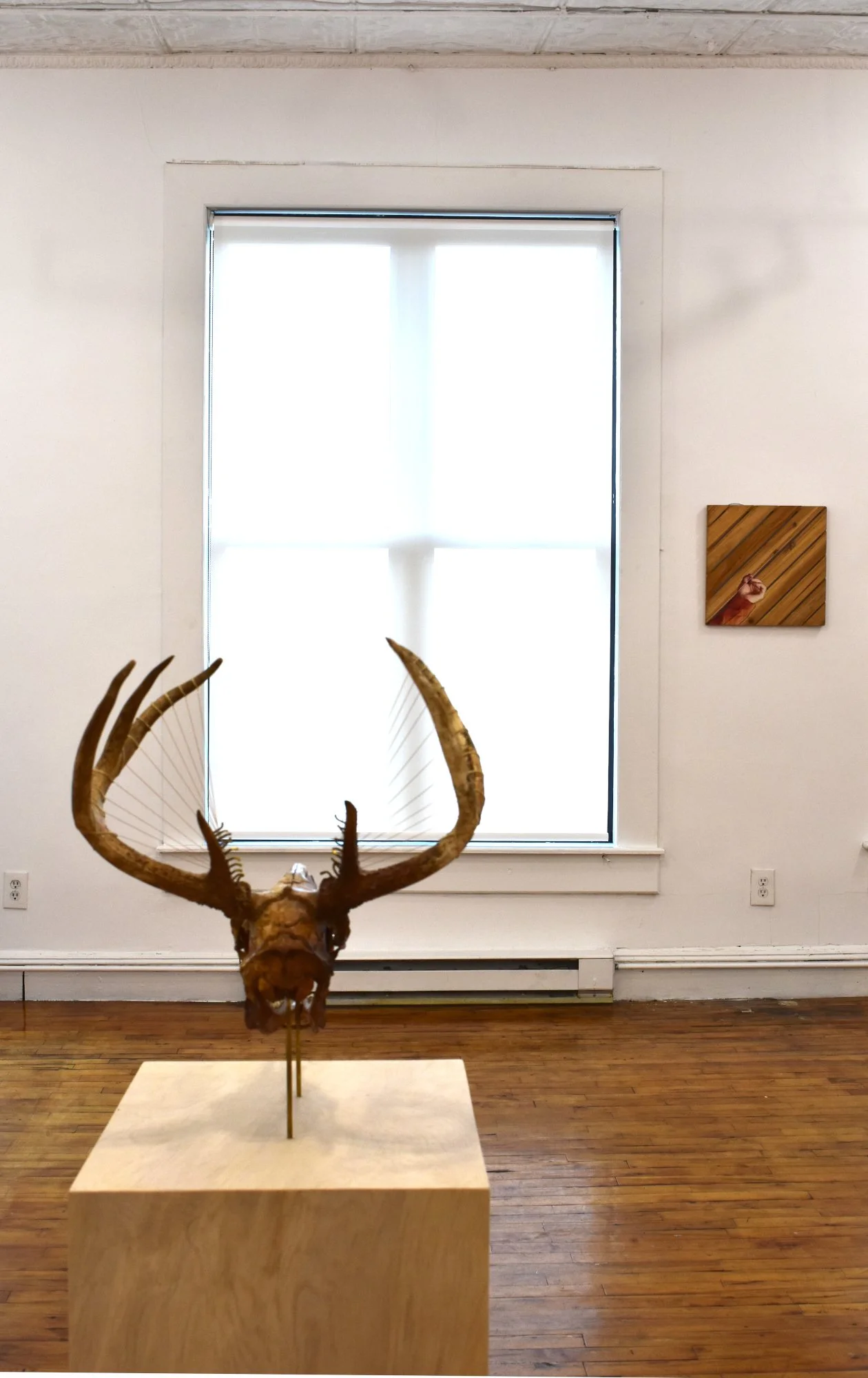
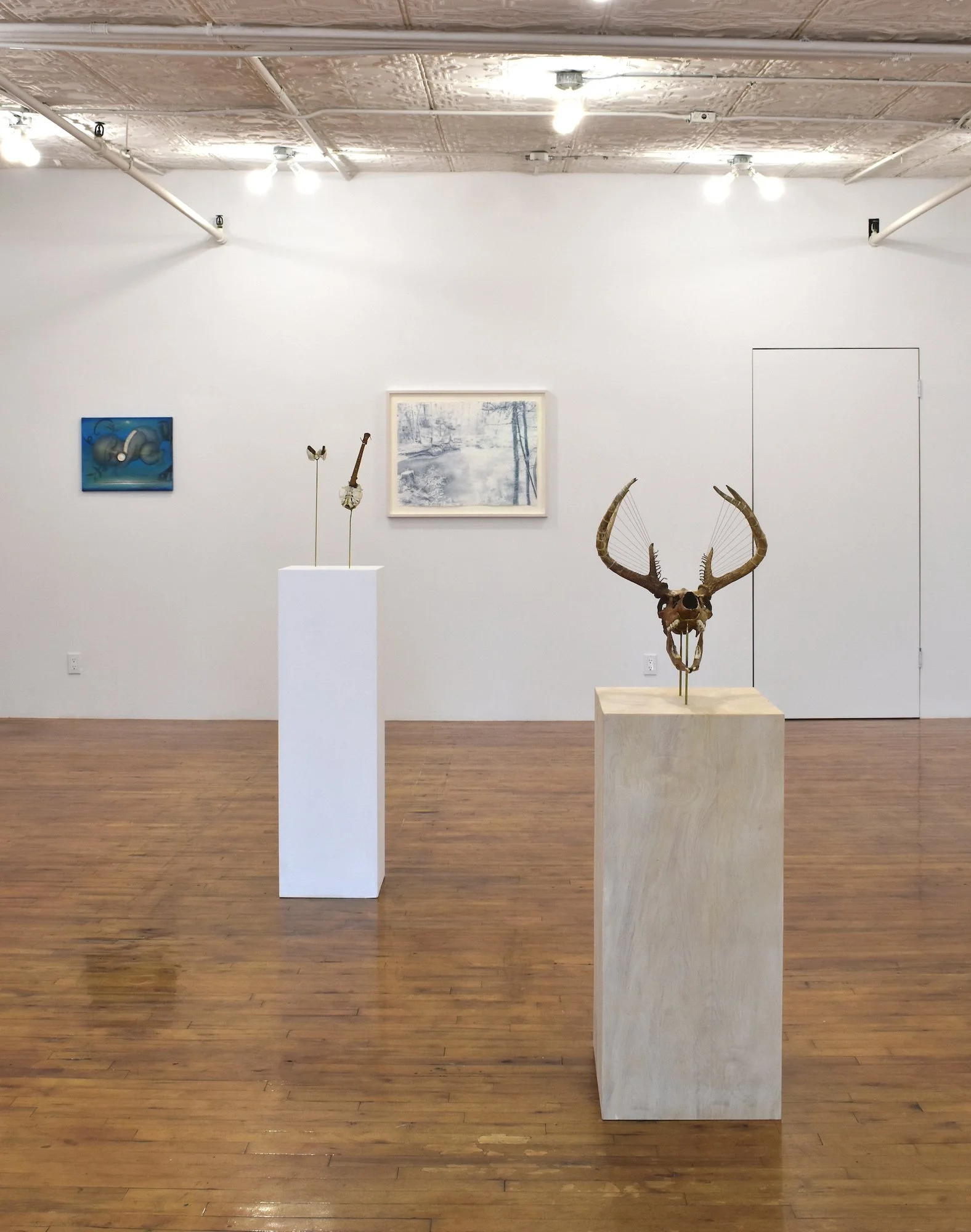
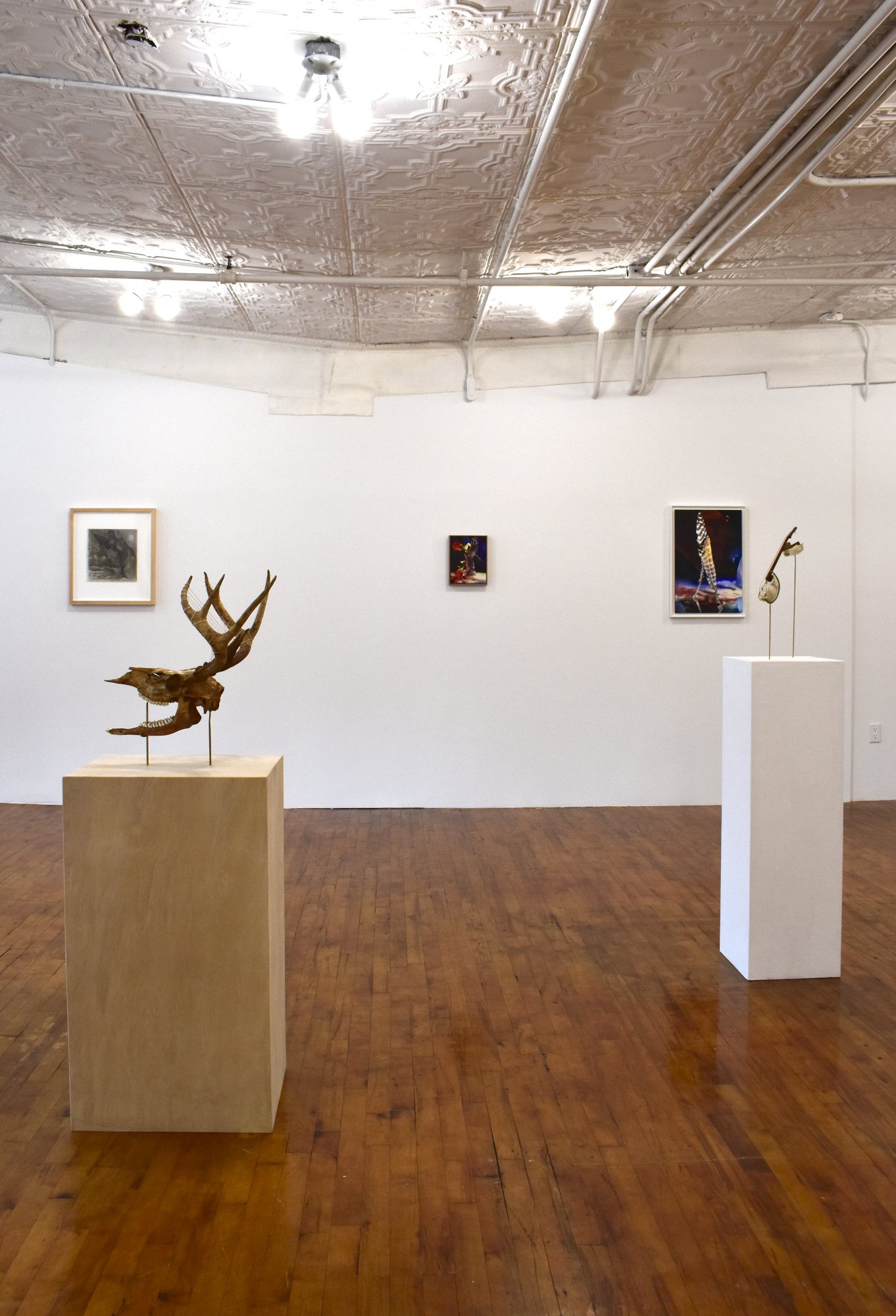
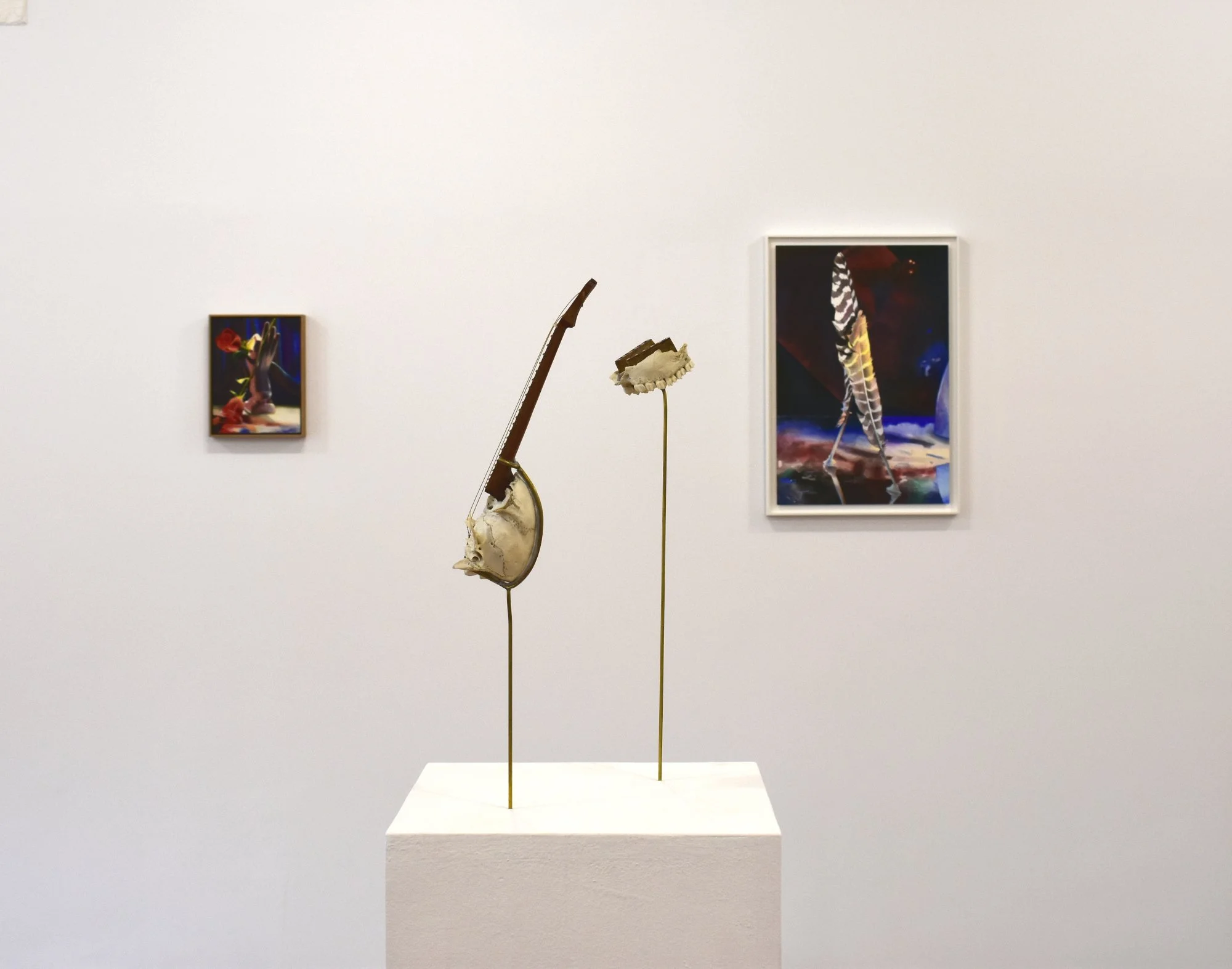
Installation views of a group exhibition Voyageat Ulterior Gallery, 2024. Works by E'wao Kagoshima, Kazumi Tanaka, and Mamie Tinkler. Photo courtesy of Ulterior Gallery, New York.
From January 16 – February 21, 2026, Ulterior Gallery will present a group exhibition featuring artists Päivi Takala, Elina Vainio, and Noora Schroderus, further expanding the visibility of Finnish contemporary artists in New York.
“This partnership reflects Finland’s commitment to fostering international cultural exchange and to supporting our artists on a global stage,” said Anssi Vallius, Special Adviser for Cultural Affairs and Creative Industries at the Consulate General of Finland in New York. “New York has long been a vital hub for contemporary art, and we are proud to see Finnish voices represented here through the collaboration with NADA and its member galleries.”
Päivi Takala Hello II, 2024 Oil on canvas 69 x 59 cm Photo courtesy of the artist and Galerie Anhava, Helsinki, Finland
In 2026 and beyond, the partnership will continue with additional NADA gallerists visiting Finland. More details will be announced in the near future.
The partnership comes during an especially exciting year for Finnish art in New York. Earlier in 2025, Dunkunsthallepresented Remix the Archive, a bold exhibition of generative art featuring artists including Agoston Nagy, Andreas Rau, Blas.v, Ilmo and Aarni Kapanen, Jeres, Nahuel Gerth, Newyellow, Roni Kaufman, Shaderism, and Tuomo Rainio. The exhibition, which remained on view from May 9 through June 21, brought together the Finnish National Gallery’sdigitized collection with creative coding techniques, creating an interactive dialogue between the past and the future.The exhibition was supported by the Jane and Aatos Erkko Foundation and Ministry of Education Finland,
Man Yau HARDENER 01, 2025 Cast bronze, patina, wax, porcelain, glaze, ceramic decals (on-glaze), towel Courtesy of the artist and Margot Samel, New York. Photographed by Sakari Tervo
In December, The Metropolitan Museum of Art will open Seeing Silence: The Paintings of Helene Schjerfbeck, the first major U.S. museum retrospective dedicated to the trailblazing Finnish painter. Featuring nearly 60 works—including important loans from the Finnish National Gallery / Ateneum Art Museum, other Finnish museums, and private collections across Finland and Sweden—the exhibition reaffirms Schjerfbeck’s rightful place in the story of modern art and highlights her enduring influence on modernist painting.
About the Finnish Cultural Institute in New York (FCINY)
The Finnish Cultural Institute in New York works across the fields of contemporary art, design and architecture, creating dialogue between Finnish and American professionals and audiences. The FCINY, founded in 1990, is a 501(c)(3) not-for-profit organization located in Dumbo, Brooklyn. We’ve grown from a residency program to commissioning large-scale projects and events that foster critical dialogue and work to build support for professionals in architecture, design, and contemporary art. We’re committed to advancing artist-led and customized projects across multiple disciplines and to creating free and accessible programming for diverse audiences. Instagram: @thefciny
About the Consulate General of Finland in New York
The Consulate General of Finland in New York promotes Finland’s commercial interests, works on improving the operational conditions for the Finnish cultural agents and strengthens Finland’s national brand through the means of public diplomacy. The Consulate General is also responsible for consular and entry services in New York as well as in other states, and special administrative areas that fall within the scope of the Consulate’s activity. The activity scope of the Consulate General of Finland in New York covers more than 30 states situated on the East Coast and in the Midwest, as well as two special administrative regions (Puerto Rico and U.S. Virgin Islands).
About New Arts Dealers Alliance
The New Art Dealers Alliance (NADA) is the definitive non-profit arts organization dedicated to the cultivation, support, and advancement of new voices in contemporary art. Founded in 2002, NADA’s membership comprises an international roster of leading contemporary art galleries and professionals. The organization hosts year-round programming, including art fairs and collaborative exhibitions in New York, Miami, Paris, and Warsaw, as well as at its exhibition space in the Lower East Side, LUNCH (Located Under NADA’s Central Headquarters).
For more information about the Consulate General of Finland in New York, please visit the site here. More information about the New Arts Dealers Alliance can be found here. Additional Information about the Finnish Cultural Institute in New York (FCINY) can be found here.
The Empty Circle Moves from Gowanus to Tribeca
The gallery’s new home will open on November 14th at 6 St. Johns Lane with a solo exhibition by Brooklyn-based Benjamin Staker.
The Empty Circle is pleased to announce the opening of its new permanent space in Tribeca on November 14th, located at 6 St. Johns Lane, 7th Floor. The Empty Circle’s new Tribeca space will inaugurate with a solo exhibition of new works by Brooklyn-based artist Benjamin Staker. For over 7 years, the gallery has been a staple of the ever-growing arts community in Gowanus, Brooklyn, and has garnered a reputation for giving emerging artists their first solo exhibitions, including Catherine Webb, Daniel Kukla, Olya Dubatova, and Olivia Gossett Cooper.
The Empty Circle will continue to function as a dynamic multi-purpose space, offering artists and independent curators an opportunity to realize site-specific installations, stage solo exhibitions, and host performances and activations. This innovative model breaks free from the traditional white cube brick and mortar space, and allows creatives to explore their full potential. In addition, the gallery will host a regular series of public programs to keep audiences engaged in the current practices and concerns of its artists.
Matt Nasser, director, shares: “Relocating to Tribeca gives us the chance to connect more deeply with the global art community and further elevate the artists we champion. This move marks a new chapter in the gallery’s evolution, with a dedicated space that allows for greater interaction with both emerging and established collectors, curators, and the broader public.”
The Empty Circle’s new Tribeca space will inaugurate with “The Moon is a Mirror,” a solo exhibition of new paintings by Brooklyn-based artist Benjamin Staker. A 2025 Chubb New York Academy of Art Fellow, Staker translates the rhythms of walking, seeing, and feeling into painterly gestures that oscillate between raw vulnerability and luminous transcendence. His canvases echo the intensity of his manifesto—where the act of painting becomes a confrontation with silence, desire, pain, and the search for connection. In this debut presentation with The Empty Circle, Staker unveils a body of work that transforms deeply personal states of longing and healing into vibrant visual form, offering viewers an immersive encounter with art as both confession and salvation.
The gallery will be located in the landmarked 6 St. Johns Lane, known as the American Thread Building, originally constructed in 1896 as a wool exchange and converted into a live-work cooperative in 1980. The space is within walking distance of the Academy of Fine Arts, and a vibrant cluster of contemporary art galleries, including Marian Goodman Gallery, Almine Rech, Jane Lombard, and GRIMM, among others.
Over the past 7 years, The Empty Circle has become a known space for artists across generations and media to stage their debut exhibitions. Some highlights from over the years include shows with The Big Art Group, Bryson Rand, Ernesto Renda, Janie Korn, Mur, Leonard Sussman and dance collective Welcome to Campfire, as well as the late artist Ingo Swann’s solo presentation at Miami Beach Art Week in 2018.
About The Empty Circle
The Empty Circle is a place for creation. Our programs encourage experimentation in both process and presentation, moving beyond traditional exhibition formats to spark meaningful exchanges between artists and audiences. We present work across diverse mediums, fostering connections between disciplines, cultures, and generations. Based in New York City, we provide vital platforms and public exhibition opportunities for artists from around the world.
Portrait of Matt Nasser, 2025. Photo by Weng Yee Mooi
About Matt Nasser
Director of La MaMa Galleria from 2009 to 2018, Matt Nasser has worked with hundreds of artists and curators from all over the world. He has created exhibitions in partnership with institutions such as The New Museum, The New York Public Library, NYU, Yale, The Cooper Union and Visual Aids. Although Matt has worked with artists at all stages of their careers, his focus is curating exhibitions that showcase underrepresented emerging artists. Matt is also an accomplished performer and stage director. He has worked in the downtown theatre and performance art community since graduating from Boston University's College of Fine Arts. Matt is a member of the Great Jones Repertory at La MaMa as well as the Big Art Group. He has collaborated with artists such as John Kelly, Justin Vivian Bond, Alan Cumming and The Bruce High Quality Foundation, always striving to bridge the gap between visual art and performance.
For more information about The Empty Circle please visit their site here.
Announcing Representation of Reginald Madison
Photo Credit: Pete Mauney
Reginald Madison-Chicago-Art & Soul-Third Place Prize-1968-PhotoCredit: Ann Zelle
Uffner & Liu is pleased to announce the representation Hudson-based artist Reginald Madison (b. 1941, Chicago, IL) following the artist's debut solo exhibition in New York at the gallery last year.
Born in 1941 in Chicago, Madison came to prominence in the emergent art scene of the Black Arts Movement (1965 – 1975). His story is one of self-determination and relentless passion, and at 84 years old is still clear-eyed and zealous about what’s to come. He is fully self-taught, having discovered a discarded box of paints as a teenager and started putting them to use. He later worked at the US Steel Southworks, taking on extra shifts to save up money to take his young family to Europe for a year, where he visited the museums of Paris, Munich, and Madrid.
In 1968 he had his first public showing of his artwork, at "Art & Soul" in Chicago, where he won third place in a competition juried by artist Richard Hunt and curator Jan van der Marck, founding director of the Museum of Contemporary Art Chicago. This formative exhibition experience gave him the confidence to further pursue his artmaking, and he traveled east to New York City and then western Massachusetts, before finally being drawn to Hudson, where he currently lives and works.
Reginald Madison River Blue, 2006-2024 oil on canvas 90 3/4 x 77 1/2 x 2 1/2 in (230.5 x 196.8 x 6.3 cm)
Madison's paintings are vibrant and improvisational, just like the free form jazz that he grew up listening to and that his method is so deeply rooted in. He has perfected a palette that embraces bold color (lime greens, salmon pinks, bright blues), toned down to an earthy—and always matte, he abhors sheen—hue. Texture is achieved through an assortment of mark-making materials, from rags to the palms of his hands to his collection of brushes. He mixes his colors directly on the walls of his studio. In a 2011 interview, he quips: “If you say ‘what’s your ancestry?’, I say – Charlie Parker. That’s my ancestor.”
Reginald Madison Black Magic, 2024 oil and tar on panel 24 x 24 in (61 x 61 cm)
Reginald Madison (b. 1941, Chicago, IL) is a self taught painter and sculptor who emerged from the Black Arts Movement in Chicago (1965 -1975). He studied independently in Paris, Venice, and Copenhagen in the 60’s. After moving to Western Massachusetts in the 70’s, Madison was represented by Phyllis Kind Gallery. After decades of working in relative obscurity, Madison held a solo exhibition at SEPTEMBER Gallery in Hudson, NY in 2021, shortly followed by his first New York solo exhibition at Rachel Uffner Gallery in 2024. His work has been included in group exhibitions at Rachel Uffner Gallery, New York, NY (2025, 2022); False Flag Gallery, Long Island City, NY (2021); SEPTEMBER Gallery, Hudson, NY (2021); The Smart Museum of Art, Chicago, IL (2018); and Shelnutt Gallery, Troy, NY (2018) and the historic pop up exhibition, Art and Soul, juried by Richard Hunt (1970). Madison’s work is in the Baltimore Museum of Art, Baltimore, MD; Beth Rudin DeWoody Collection, Miami, FL; and the University of Santa Barbara Art, Design & Architecture Museum, Santa Barbara, CA. His work has been reviewed in The New York Times, and has been included in “Art for People’s Sake: Artists and Community in Black Chicago, 1965-1975”, Duke University Press, and “The Time Is Now! Art World’s of Chicago’s South Side, 1960-1980”, The University of Chicago Press. Madison lives and works in Hudson, NY.
For more information about this announcement and others at Uffner & Liu, please visit their site here. Information about this artist and other artists, along with past, current, and future exhibitions, can be found on the website. The gallery can be found on Facebook, Instagram, YouTube, and X.
Alexander Gray Associates announces representation of Kamrooz Aram
Courtesy of Alexander Gray Associates and Kamrooz Aram
Alexander Gray Associates announces representation of Kamrooz Aram (b. 1978). In February 2026, the Gallery will present a solo exhibition of Aram’s work. Aram has built his practice on dismantling the divide between ornament and fine art, renegotiating the art historical hierarchies that privilege Western forms of abstraction above others. His paintings and sculptures do not simply cross categories; they probe the structures that enforce them. Born in Shiraz, Iran, Aram emigrated to the United States in the 1980s, where he found himself forced to come to terms with a multitude of identities imposed upon him. These experiences left a lasting mark. Categories, he discovered, do not merely describe identity—they invent it. This recognition drives his work, which asserts that non-Western ornamental traditions carry the same intellectual weight and conceptual rigor Western art history has long reserved for itself.
“Kamrooz’s practice opens a critical dialog for reconsidering how we define cross-cultural histories,” shares John Kunemund, Partner at Alexander Gray Associates. “At a time when the space for nuance has become increasingly important, his work demonstrates how patterns, forms, and histories reflect hierarchies and shape identities. By confronting these structures with rigor, poetry, and beauty, Kamrooz not only expands the field of abstraction but also reminds us that the very terms we use to categorize art and culture reflect charged sites of power. We are honored to support his vision.”
Aram, Roman Token, 2023
Aram’s paintings are acts of translation. Intricate geometries slip into fields of color, while brushstrokes accumulate in thin layers, revealing glimpses of what lies beneath. Aram speaks of pursuing contemporary art’s “taboo subjects” like emotion and spiritual presence, and in his work, they appear not as sentiment, but as structure. Calligraphic forms reverberate against the cool authority of Minimalist grids; floral arabesque patterns breathe new life into Color Field painting. These juxtapositions are not acts of fusion, so much as acts of recognition, acknowledging what has always been visible.
Aram’s influences are as diverse as his artistic strategies. Henri Matisse’s embrace of pattern, Ellsworth Kelly’s geometric clarity, and Cy Twombly’s gestural abandon all resonate in his practice. Most revealing is Le Corbusier—modernism’s supposed ascetic—whose architecture, despite its rhetoric of purity, cannot entirely suppress its embrace of ornament. For Aram, this contradiction lays bare how words like “decorative” are never neutral; they are instruments of hierarchy.
Untitled (Arabesque Composition) 2023
Aram’s sculptures extend this critique into three dimensions, arranging ceramic objects on painted plinths that echo museum displays. These installations engage with institutions from within, showing how context confers the status of “art” and revealing the fragile systems behind such designations. As Aram explains, “I hope to renegotiate the terms in which art history has been written—the Eurocentric hierarchy that places certain types of painting in the category of fine art while others are relegated to the minor arts.”
At the center of Aram’s practice lies a paradox he captures with poetic clarity in his writing: “It occurs to me that I am Arabesque. It occurs to me that there is no such thing as the Arabesque.” His work inhabits the charged space between being and non-being, tradition and invention, visibility and erasure. Rather than resolving these contradictions, Aram leaves them; it is in their friction—in the failure of old certainties—that new ways of seeing begin to emerge.
About Artist
Aram’s work has been the subject of numerous solo exhibitions, including Kamrooz Aram: Privacy, An Exhibition, The Arts Club of Chicago, IL (2022); Lives of Forms: Kamrooz Aram and Iman Issa at Z33 House for Contemporary Art, Design & Architecture, Hasselt, Belgium (2021); FOCUS: Kamrooz Aram, Modern Art Museum of Fort Worth, TX (2018);Kamrooz Aram: Ancient Blue Ornament, Atlanta Contemporary, GA (2018); and Kamrooz Aram: Ornament for Indifferent Architecture, Museum Dhondt Dhaenens, Sint-Martens-Latem, Belgium (2017). His work has been featured in significant group exhibitions, including Paraventi: Folding Screens from the 17th to 21st Centuries at Fondazione Prada, Milan, Italy (2023-2024) and Desorientalismos at Centro Andaluz de Arte Contemporáneo, Seville, Spain (2020). Aram's work is in the collections of The Metropolitan Museum of Art, New York, NY; M+ Museum, Hong Kong, China; Art Gallery of New South Wales, Sydney, Australia; Modern Art Museum of Fort Worth, TX; Cincinnati Art Museum, OH; Portland Museum of Art, ME; and Sharjah Art Foundation, United Arab Emirates, among others. He is the recipient of multiple prestigious awards, including the Guggenheim Fellowship (2025); the Carla Fendi Rome Prize from the American Academy in Rome (2024); and the Abraaj Group Art Prize (2014). He is also represented by Green Art Gallery, Dubai, United Arab Emirates. Aram lives and works in Brooklyn, NY.
Emily Harter Joins HESSE FLATOW
Courtesy of artist and HESSE FLATOW
HESSE FLATOW, New York, announces the representation of San Francisco-based artist Emily Harter. In October, Harter will have her second solo exhibition with HESSE FLATOW, and will be featured in a solo booth at Minor Attractions art fair in London, UK.
Emily Harter (b. 1997) Winter, 2025 Gouache and pencil on prepared paper 23 1/2 x 32 inches 59 x 81 cm 32 1/2 x 41 inches (framed) 82 x 104 cm (framed)
“At HESSE FLATOW, we’ve made it our mission to stand behind artists early in their journeys and to nurture their long-term growth, ” says founder Karen Hesse Flatow. “Emily embodies the spirit of that commitment, and we are thrilled to accompany her as she enters this next chapter of her career. Her work not only draws upon centuries of painting history but also expands the possibilities of what the medium can be.
"
Emily Harter (b.1997) Allegorical Figure of Winter, 2025 Oil on canvas 17 x 13 inches 43.18 x 33.02 cm
Working across painting, drawing, ceramics, and printmaking, Harter develops scenes where chaos and humor collide. Her work is inspired by Netherlandish genre painting, the satirical prints of Hogarth and Daumier, and the Golden Age of American cartoons. She creates narrative scenes packed with a shifting cast of caricaturized figures. These characters, each caught in their own actions and desires, embody tropes pulled from art history, literature, comic strips, and current crises.
Emily Harter (b. 1997) Fall, 2025 Gouache and pencil on prepared paper 23 1/2 x 32 inches 59 x 81 cm 32 1/2 x 41 inches (framed) 82 x 104 cm (framed)
This October, Harter's exhibition at HESSE FLATOW, titled Split the Rolling Year, will center on the four seasons as sites of collective affect and experience. The drawings on view will depict crowded scenes of catastrophe, floods, storms, fires, and melting ice, that speak to the anxieties of the changing seasons and the natural disasters that follow. In contrast, the paintings present solitary figures whose bodily states follow the framework of the Four Humors, aligning the cycles of weather with human moods, temperaments, and fluids. Together, the works explore how the rhythm of the seasons resonates with human experience, from collective upheaval to individual disposition.
About the Artist
Emily Harter received her BA from Oberlin College and her MFA in Art Practice from Stanford University. Her work has been exhibited throughout the United States, including solo exhibitions at HESSE FLATOW (New York), OCHI Projects OVR (Los Angeles) and Cleaner Gallery (Chicago). She was the recipient of the AAF/Seebacher Prize for the Fine Arts, The Headlands Graduate Fellowship, and the 2020 MAPC Travel Grant and has been a resident artist at The Lighthouse Works (Fishers Island, NY), Arts, Letters, and Numbers (Averill Park, NY), and After 1920 (San Diego). She is a co-founder of Pigeon Hole Press in Chicago, IL, which produces and publishes fine art intaglio prints.
For more information about this announcement and HESSE FLATOW, please visit their site here. The gallery can also be found on Instagram here. For more information about Emily Harter, their website can be found here, and they can also be found on Instagram.
P·P·O·W to Represent Owen Fu
Owen Fu My Father's Back, 2024 oil on canvas60 x 84 ins.152.4 x 213.4 cm Courtesy of Owen Fu and P·P·O·W, New York Photo: Ian Edquist
P·P·O·W is pleased to announce the co-representation of Chinese artist Owen Fu with Antenna Space, Shanghai. In his paintings, often depicting surreal domestic scenes cast in a nocturnal glow, ghostly figures and inanimate objects merge as the distinctions between reality, dreams, and memory disintegrate. Drawing from centuries-old traditions of ink wash painting, Fu’s works expose the mysterious emotional landscape residing beneath the surface of ordinary life.
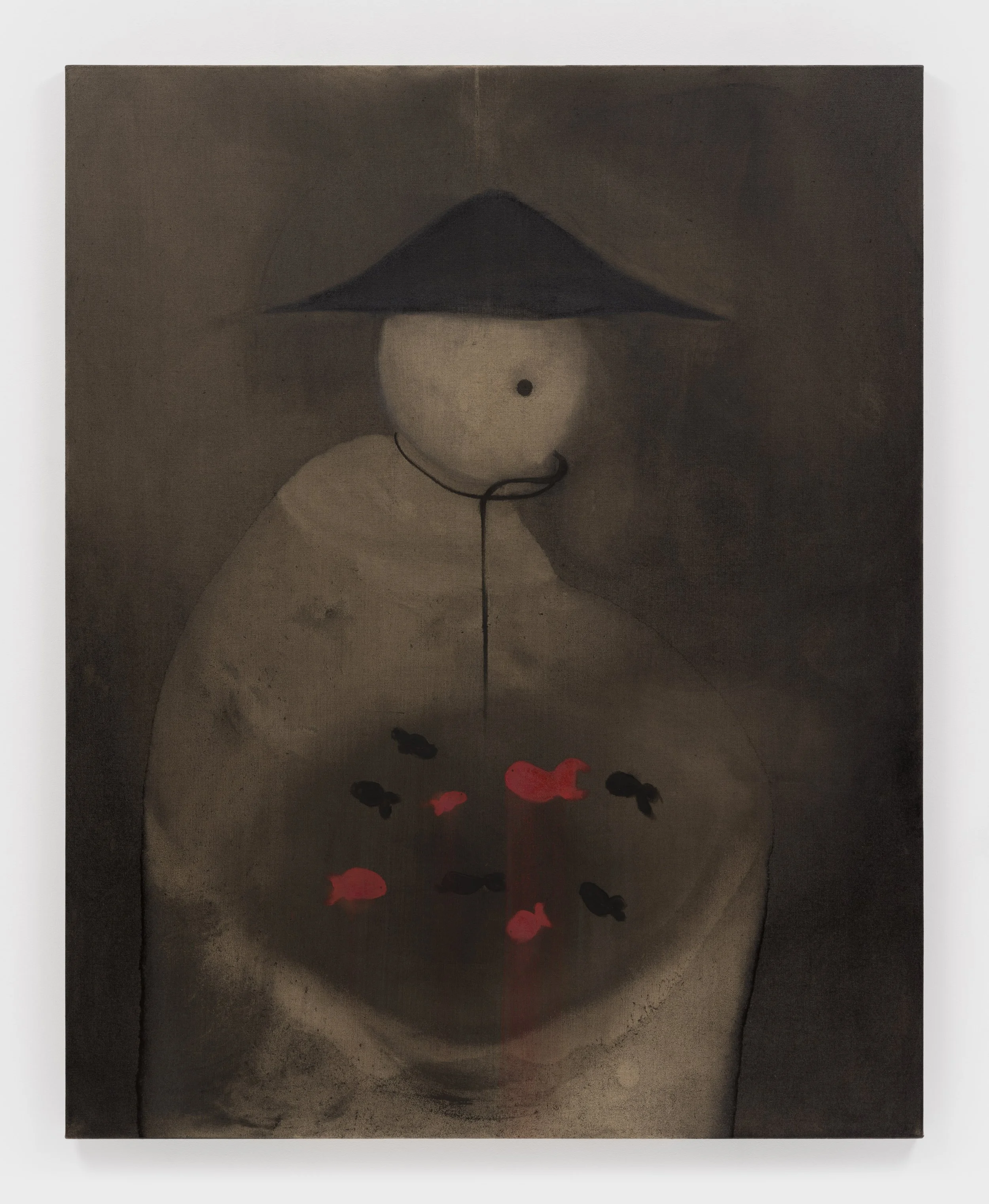
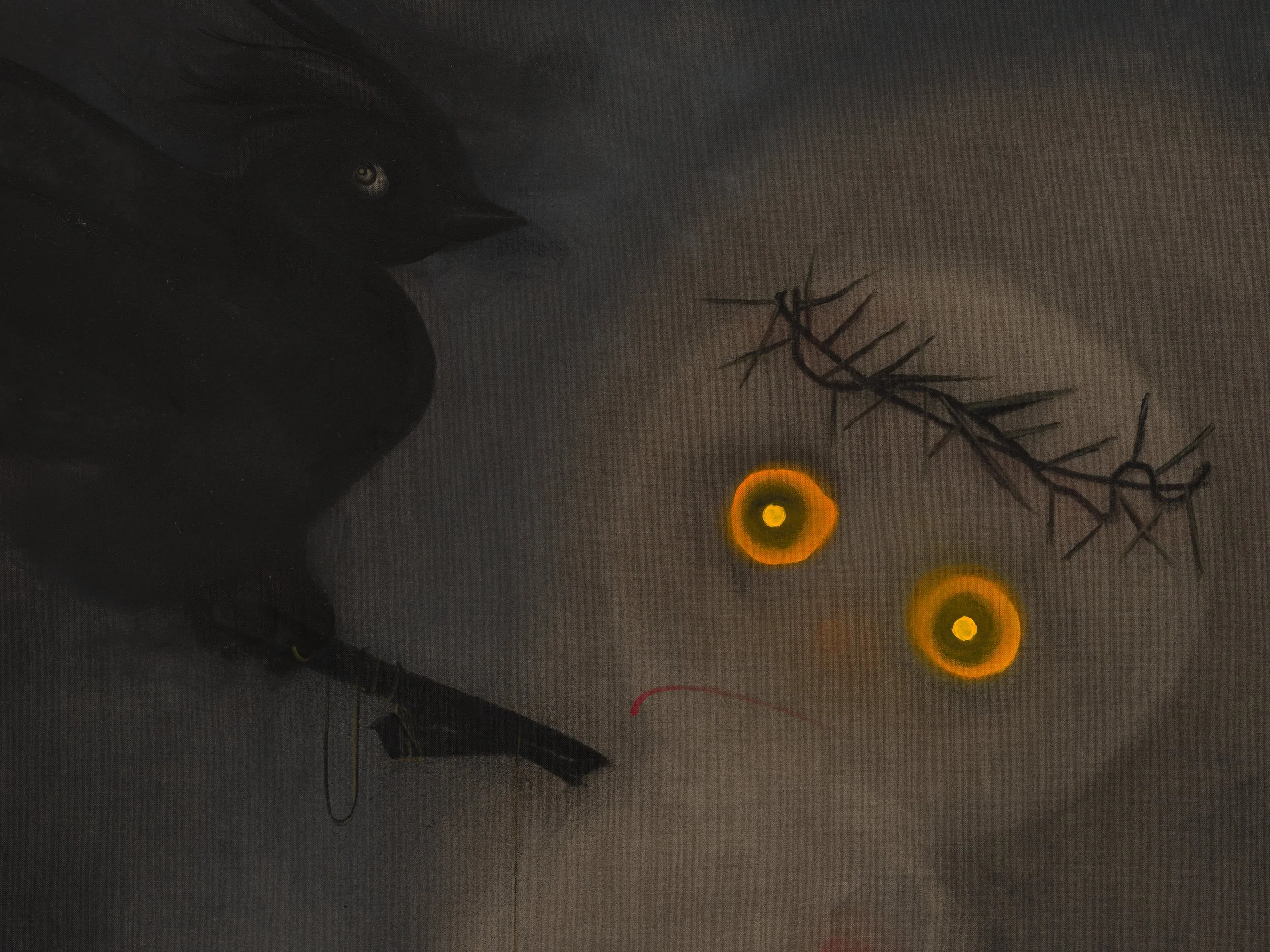
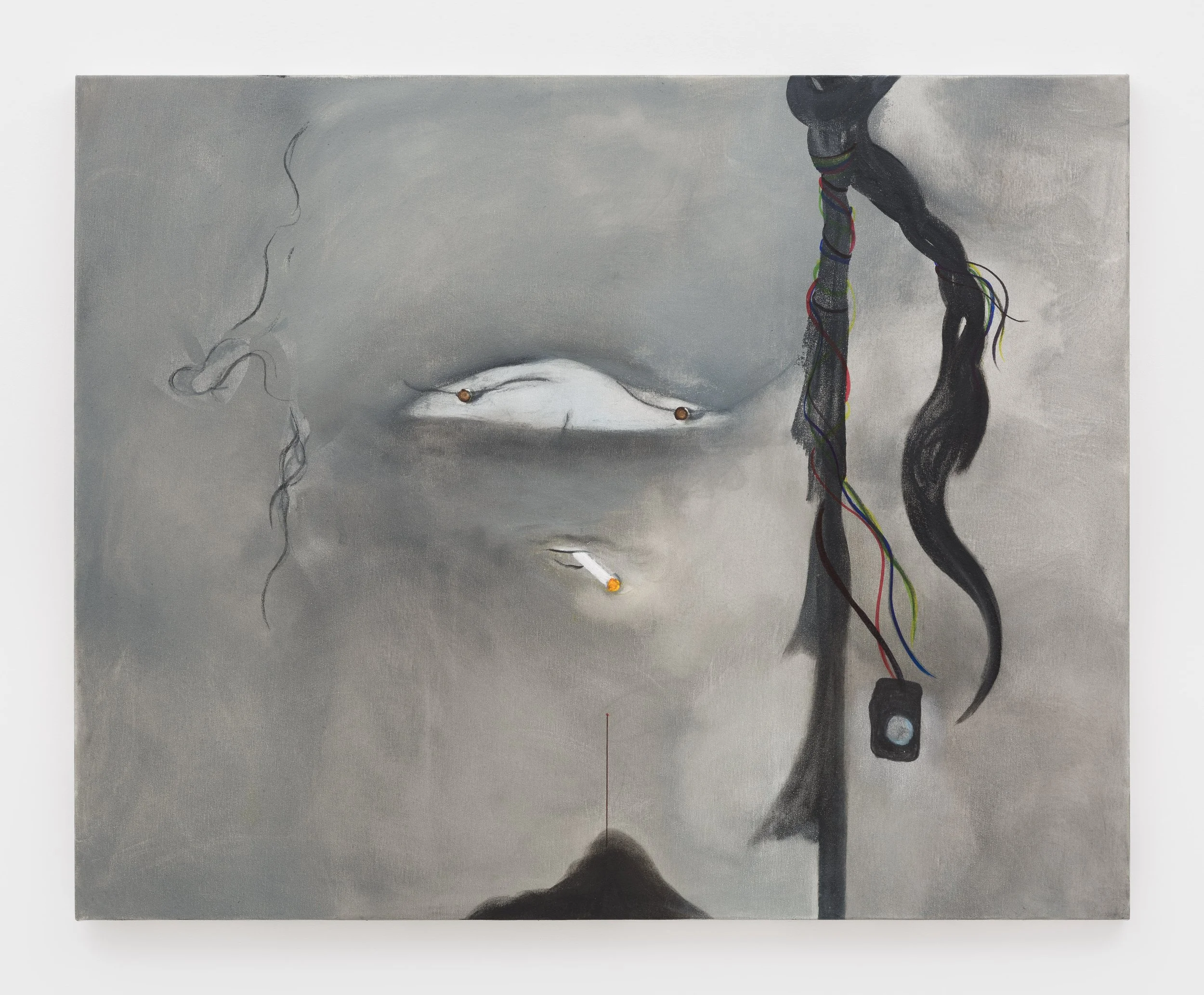
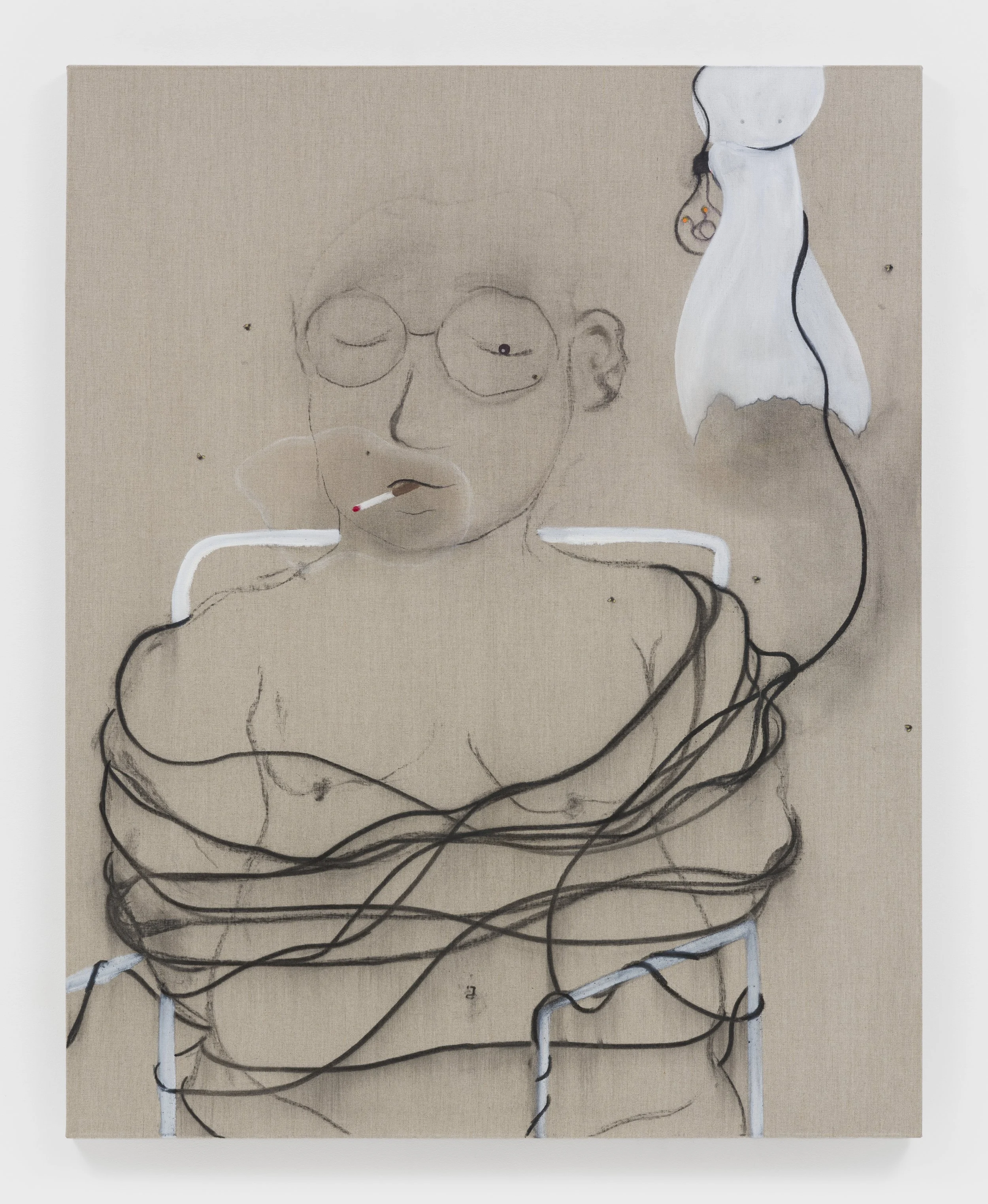
From Left to Right: Owen Fu you are not the fish 子非 鱼 , 2024 oil on linen 60 x 48 ins. 152.4 x 121.9 cm Courtesy of Owen Fu and P·P·O·W, New York Photo: Ian Edquist, Owen Fu The Bird, the Shadow, and the Thorns , 2024 oil on linen 67 x 58 ins. 170.2 x 147.3 cm Courtesy of Owen Fu and P·P·O·W, New York Photo: JSP Art Photography, Owen Fu Untitled (never let me go) , 2024 oil on canvas 40 x 50 ins. 101.6 x 127 cm Courtesy of Owen Fu and P·P·O·W, New York Photo: Ian Edquist, Owen Fu Untitled (so proud) , 2024 oil on linen 60 x 46 ins. 152.4 x 116.8 cm Courtesy of Owen Fu and P·P·O·W, New York Photo: Ian Edquist
Fu constructs his scenes through thin veils of oil paint on raw linen and canvas, creating works that read like memories suspended between consciousness and subconsciousness, narration and abstraction. Through soft, yet deliberate mark making, Fu navigates feelings of loss, desire, and memory while evoking a sense of intense longing and personal exploration. Interweaving literary, philosophical, and other cultural references with his own experiences of migration from China to the United States, Fu combines Eastern and Western painting traditions with art historical tropes to reveal unseen passageways in which amorphous figures drift between places seeking connection, solace, and sanctuary. Offering viewers a glimpse into the margins of society, Fu conducts introspective investigations shaped by a queer sensibility, exploring intimacy, desire, and otherness alongside the perpetual unfolding of time.
Owen Fu Untitled (Holy Matcha) , 2024 oil on linen 60 x 48 ins. 152.4 x 121.9 cm Courtesy of Owen Fu and P·P·O·W, New York Photo: Paul Salveson
Fu presented his first solo exhibition with P·P·O·W, Own Alone , earlier this year. His work is currently included in Surface Streets , a group exhibition curated by Russell Ferguson at Marian Goodman Gallery, Los Angeles, CA, through October 18, and in Owen Fu: Wang Lai , his second solo exhibition with Antenna Space, on view through October 26.
Courtesy of Owen Fu, P·P·O·W, New York, and Antenna Space, Shanghai
Owen Fu (b. 1988) was born in Guilin, China. Fu completed his MFA in 2018 at the ArtCenter College of Design, Pasadena, CA, preceded by a BA in Philosophy from the Stony Brook University, New York, NY, and a BA in Fine Art from the School of the Art Institute of Chicago, IL. He has presented solo exhibitions at Balice Hertling, Paris, France; Antenna Space, Shanghai, China; O-Town House, Los Angeles, CA; Gallery Platform LA, Los Angeles, CA; Mine Project, Hong Kong, China; Art Center Main Gallery, Los Angeles, CA; and New York Art Expo, New York, NY; among others. He has been featured in group exhibitions at Marian Goodman Gallery, Los Angeles, CA; Antenna Space, Shanghai, China; Hammer Museum, Los Angeles, CA; Gagosian Hong Kong, China; and Balice Hertling, Paris, France; among others. His work was included in the 2022 Beijing Biennial, Magic Square: Art and Literature in Mirror Image at Friendship Art Community, Beijing, China. His works belong to the collections of numerous international institutions including the Los Angeles County Museum of Art, Los Angeles, CA; Hammer Museum, Los Angeles, CA; Domus Collection, New York, NY; K11 Art Foundation, Hong Kong, China; START Museum, Shanghai, China; George Economou Collection, Athens, Greece; Aïshti Foundation, Beirut, Lebanon; G Museum, Nanjing, China; and the Juan and Patricia Vergez Collection, Buenos Aires, Argentina; among others.
For more information about this news, other announcements, and exhibitions, please visit the P·P·O·W gallery’s website. Also, the gallery can be found on Instagram and Artsy. Srijon’s interview with the magazine can be found here.
BONHAMS ANNOUNCES FIRST-EVER INITIATIVE IN SAUDI ARABIA WITH JUDHOOR / ROOTS: THE ORIGINS OF SAUDI MODERNISM
Left: Riyadh’s JAX District, where the exhibition is taking place Right: Abdulrahman Al Soliman (Saudi Arabia, born 1954) Mountain Amongst the Palms. Estimate: £40,000 - 60,000.
Bonhams is delighted to announce its first-ever initiative in the Kingdom of Saudi Arabia: Judhoor / Roots: The Origins of Saudi Modernism, an exhibition and associated programme of events opening at the newly renovated LIFT Gallery in Riyadh’s JAX District from 8–10 October 2025. The gallery is owned by HRH Princess Nouf bint Abdulaziz Al Saud and is situated in the heart of the capital’s new vibrant creative hub.
Safeya Binzagr (Saudi Arabia, 1940-2024) Traditional Attire Estimates_30,000 - 50,000
Judhoor / Roots traces the emergence and transformation of Saudi Arabia’s modern art scene, from the pioneering contributions of artists such as Abdulrahman Al Soliman, Safeya Binzagr, and Mohamed Al Saleem, through to the ambitious voices of the 1980s and beyond. Nima Sagharchi, Group Head of Middle Eastern Art, comments: “This is the first auction-house curated exhibition of local modern art in the Kingdom, highlighting the deep roots of Saudi modernism and uncovering a largely overlooked history, one that foregrounds the narratives that predate today’s flourishing cultural moment.”
Abdullah Al Shaikh (Saudi Arabia, born 1936) The Awakening Estimates_40,000 - 60,000
The exhibition brings together seminal works of Saudi modernism alongside important documentary and archival material. Among the highlights is a horizon painting by Mohammed Al Saleem from the 1980s, inspired by his abstraction of the Riyadh skyline viewed from the desert. Also on view is one of Abdulrahman Al Soliman’s most intimate works, a 1981 painting of Al-Ahsa oasis, created with desert soil he collected on childhood visits. Archival material from Dar Al-Fnoon, Saudi Arabia’s first modern art space, founded by Al Saleem, adds crucial context to the story.
Significantly, Judhoor also features several leading female voices in the Saudi Art scene. The exhibition marks the first time an auction house has presented the work of Safeya Binzagr, a graduate of Central Saint Martins in the 1960s and the first female artist to hold a solo exhibition in Saudi Arabia. Her celebrated 31-work cycle documenting traditional attire is a landmark in the visual preservation of Saudi cultural identity. Other highlights include Bakr Sheikhoun’s Portrait of a Woman, a powerful early expression from an artist who would later become the Kingdom’s first conceptual practitioner.
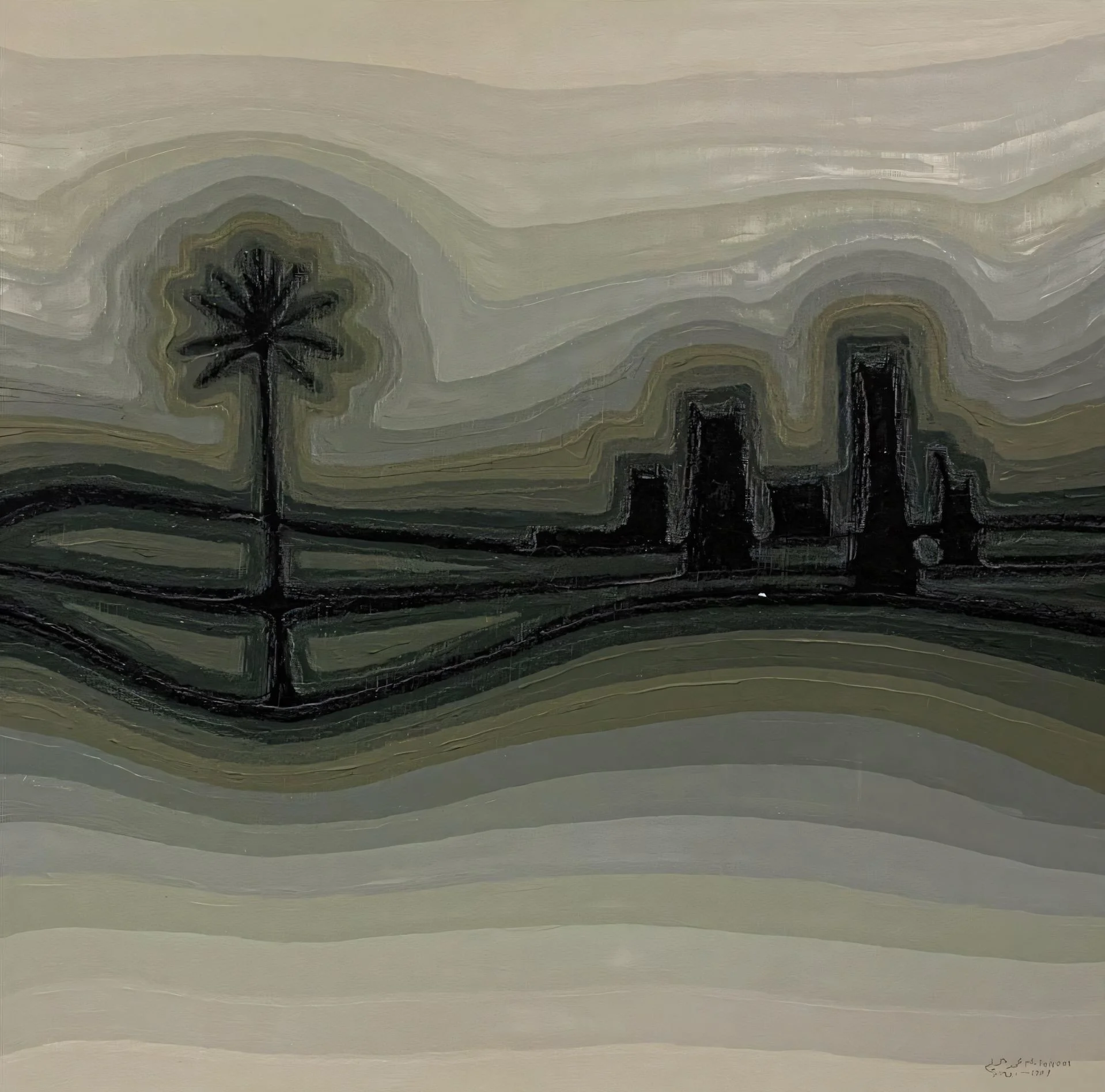
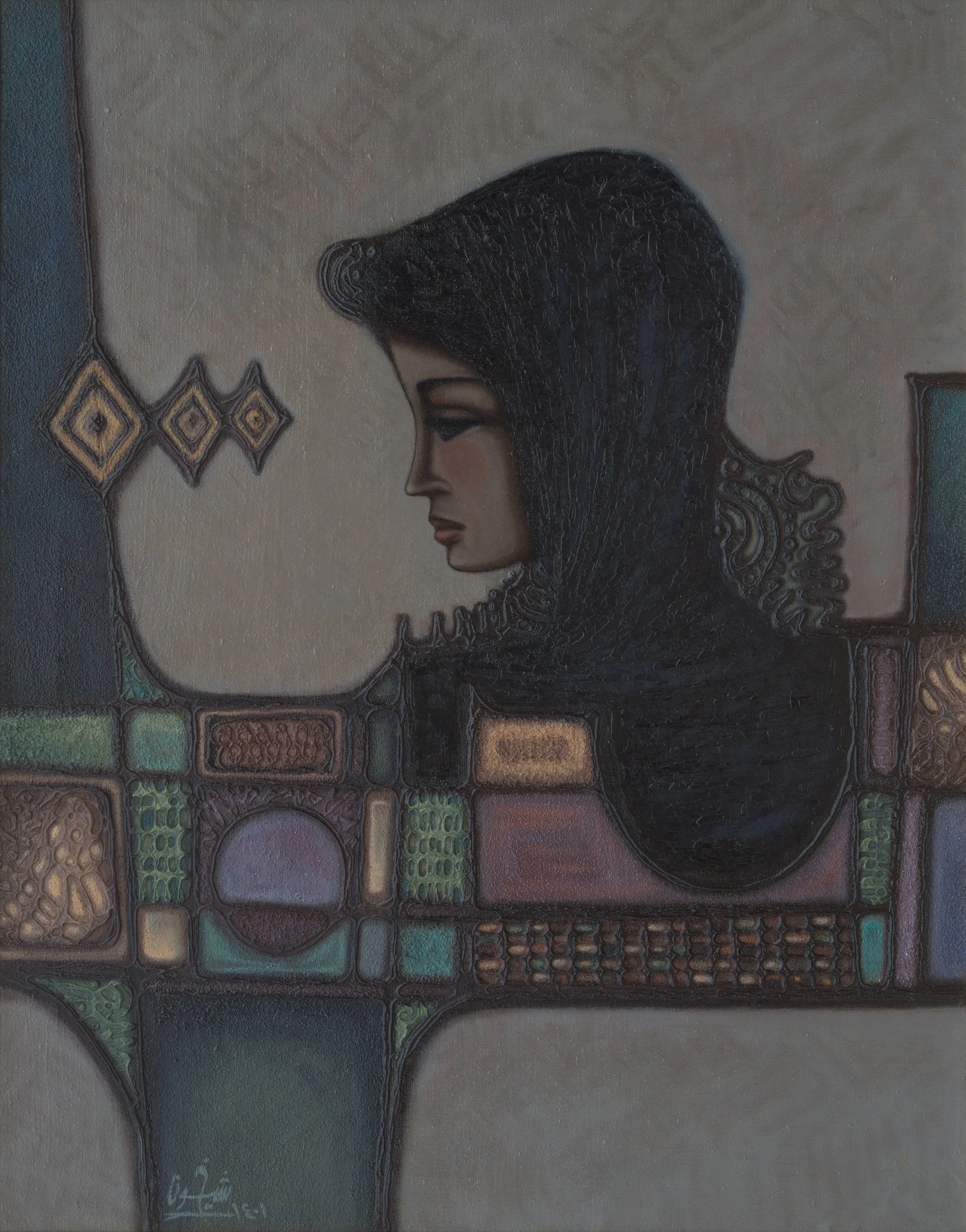
Left: Mohammed Al Saleem (Saudi Arabia, 1939-1997) Untitled (From the Horizon Series). Right: Bakr Sheikhoun (Saudi Arabia, born 1946) Head of a Woman.
Works featured in Judhoor / Roots will subsequently appear in Bonhams’ 25 November auction in London.
Building on the exhibition, a panel discussion will be held at Maison Assouline, located near the historical district of Diriyah, a UNESCO World Heritage Site. The event will be co-hosted by collectors Taha Al Kuwaiz and Muneera Al Touq. The panel will include Najla Al Saleem, artist and daughter of Mohamed Al Saleem; Abdulrahman Al Soliman, one of Saudi Arabia’s most renowned modern artists; Lulwah AlHomoud, an award winning Saudi artist and curator; academic Nada Al Rakaf; and will be moderated by Arab art specialist Fadia Antar.
Participating artists: Abdulhalim Radwi, Abdulrahman Al Soliman, Abdullah Al Shaikh, Bakr Sheikhoun, Ibrahim Al Fassam, Khalid Al Owais, Mohammed Al Saleem, Najla Al Saleem, Ola Hejazi, Safeya Binzagr, Saud Al Qahtani, Taha Al Sabban, and Wedad Alahmadi.
Exhibition dates: 8–10 October 2025
Location: LIFT Gallery, JAX District, Riyadh
The announcement comes after the appointment of Suzy Sikorski as Business Development Director in The Middle East. Read more HERE.
About The Bonhams Network
Bonhams is a global network of auction houses, with the largest number of international salerooms, offering the widest range of collecting categories and selling at all price points. Bonhams is recognised for its bespoke service, and a dedication to local market relationships, enhanced by a global platform. With 14 salerooms, Bonhams presents over 1,000 sales annually, across more than 60 specialist categories, including fine art, collectables, luxury, wine & spirits, and collector cars.
Founded in 1793, Bonhams has representatives in more than 30 countries and operates flagship salerooms in London, New York, Paris, Los Angeles, and Hong Kong. In 2022, Bonhams added four international auction houses to its network: Bukowskis, Stockholm; Bruun Rasmussen, Copenhagen; Cornette de Saint Cyr, Paris and Brussels; and Skinner, Massachusetts. The success of Bonhams’ global strategy is a result of recognising the shift in growing intercontinental buying and increased digital engagement.
In 2023, Bonhams achieved 14% growth with $1.14 billion in turnover. Recent important auctions and landmark single-owner collections, include the white glove sales of Sir Michael Caine: The Personal Collection, Alain Delon: Sixty Years of Passion; Sir Roger Moore: The Personal Collection; Personal Property of Justice Ruth Bader Ginsburg and The Robert & Jean-Pierre Rousset Collection of Asian Art: A Century of Collecting. Other notable single-owner sales included The Estate of Barbara Walters: American Icon; The Alan and Simone Hartman Collection; The Crown Auction: Props and Costumes and The Claude de Marteau Collection.
Top lots for 2023 include 1967 Ferrari 412P Berlinetta, Sold at Quail Lodge, US for US$30,255,000. Tipu Sultan’s Bedchamber Sword (sold in London for £14m – a world record for both an Islamic and an Indian object); Paul Signac (1863-1935), Sisteron, 1902. Sold for US$8,580,000 (estimate US$4-6 million), and Claude Monet (1840-1926), La Seine près de Giverny, 1888. Sold for US$6,352,500 (estimate US$4-6m), both from the Alan and Simone Hartman Collection; A Gilt Copper Alloy figure of Virupaksha, Central Tibet, Densatil Monastery, Early 15th century. Sold for HK$37.9m (£4,060,326) in Hong Kong. Yoshitomo Nara (born 1959) Three Stars. Sold for HK$36,754,000 (£3,930,914), also in Hong Kong.
For more information about these auctions and others featured By Bonhams, please visit their site. Bonhams can also be found on Instagram, Facebook, X, YouTube, and Pinterest.
BONHAMS APPOINTS THERESA MCCULLOUGH AS SENIOR SPECIALIST OF INDIAN, HIMALAYAN & SOUTHEAST ASIAN ART
Theresa McCullough, Senior Specialist, Indian, Himalayan & Southeast Asian Art
London – Bonhams has appointed Theresa McCullough as Senior Specialist in Indian, Himalayan, and Southeast Asian Art in London. She will also be responsible for valuations across Europe.
Theresa brings thirty years of experience in the field, combining deep subject knowledge with commercial expertise, and a proven record of leadership across the auction, museum, and academic sectors.
Before joining Bonhams, Theresa began her career at Spink, London where she established herself as a respected dealer in Indian and Southeast Asian art.
She held senior roles at Sotheby’s New York, achieving record-breaking sales in Indian sculpture; and as Principal Curator at the Asian Civilisations Museum in Singapore, where she led major exhibitions, museum publications, and international collaborations—including with the Musée national des arts asiatiques – Guimet in Paris and Yale University Art Gallery in New Haven. She has long been a trusted advisor to private collectors, museums, and institutions worldwide, with a focus on connoisseurship and strategic collecting.
She holds a Master’s degree in the History of Art and Archaeology from the School of Oriental and African Studies (SOAS), University of London.
“I am thrilled to be joining the Bonhams team and to contribute to its long-standing reputation for excellence and integrity in the field of Indian, Himalayan, and Southeast Asian art. It is a privilege to be part of such a globally respected, specialist-led house at an exciting time of growth.”
About The Bonhams Network
Bonhams is a global network of auction houses, with the largest number of international salerooms, offering the widest range of collecting categories and selling at all price points. Bonhams is recognised for its bespoke service, and a dedication to local market relationships, enhanced by a global platform. With 14 salerooms, Bonhams presents over 1,000 sales annually, across more than 60 specialist categories, including fine art, collectables, luxury, wine & spirits, and collector cars.
Founded in 1793, Bonhams has representatives in more than 30 countries and operates flagship salerooms in London, New York, Paris, Los Angeles, and Hong Kong. In 2022, Bonhams added four international auction houses to its network: Bukowskis, Stockholm; Bruun Rasmussen, Copenhagen; Cornette de Saint Cyr, Paris and Brussels; and Skinner, Massachusetts. The success of Bonhams’ global strategy is a result of recognising the shift in growing intercontinental buying and increased digital engagement.
In 2023, Bonhams achieved 14% growth with $1.14 billion in turnover. Recent important auctions and landmark single-owner collections, include the white glove sales of Sir Michael Caine: The Personal Collection, Alain Delon: Sixty Years of Passion; Sir Roger Moore: The Personal Collection; Personal Property of Justice Ruth Bader Ginsburg and The Robert & Jean-Pierre Rousset Collection of Asian Art: A Century of Collecting. Other notable single-owner sales included The Estate of Barbara Walters: American Icon; The Alan and Simone Hartman Collection; The Crown Auction: Props and Costumes and The Claude de Marteau Collection.
Top lots for 2023 include 1967 Ferrari 412P Berlinetta, Sold at Quail Lodge, US for US$30,255,000. Tipu Sultan’s Bedchamber Sword (sold in London for £14m – a world record for both an Islamic and an Indian object); Paul Signac (1863-1935), Sisteron, 1902. Sold for US$8,580,000 (estimate US$4-6 million), and Claude Monet (1840-1926), La Seine près de Giverny, 1888. Sold for US$6,352,500 (estimate US$4-6m), both from the Alan and Simone Hartman Collection; A Gilt Copper Alloy figure of Virupaksha, Central Tibet, Densatil Monastery, Early 15th century. Sold for HK$37.9m (£4,060,326) in Hong Kong. Yoshitomo Nara (born 1959) Three Stars. Sold for HK$36,754,000 (£3,930,914), also in Hong Kong.
For more information about these auctions and others featured By Bonhams, please visit their site. Bonhams can also be found on Instagram, Facebook, X, YouTube, and Pinterest.
Alexander Gray Associates and Bockley Gallery announce co-representation of Dyani White Hawk
Portrait of Dyani White Hawk, 2022. Photo by Jaida Grey Eagle; Dyani White Hawk, "Wókağe | Create," 2019. Screenprint, copper foil on paper. Collection of the Walker Art Center. Edition of 18. Courtesy Highpoint Center for Printmaking, Minneapolis; Alexander Gray Associates, New York; Bockley Gallery, Minneapolis. © 2025 Dyani White Hawk. Photo by David Kern
Alexander Gray Associates announces co-representation of Minneapolis-based artist Dyani White Hawk (b. 1976) in partnership with Bockley Gallery, Minneapolis. This October, White Hawk's career continues to gain significant institutional recognition with the survey exhibition Love Language opening at the Walker Art Center, Minneapolis. Her first solo exhibition with Alexander Gray Associates is scheduled for fall 2026.
Dyani White Hawk Visiting, 2024 Acrylic, glass beads, thread, and synthetic sinew on aluminum panel, quartz base Column: 120 x 15.5 x 15.5 in (304.8 x 39.4 x 39.4 cm) Base: 5 x 24 x 24 in (12.7 x 70 x 70 cm) Collection of Denver Art Museum Courtesy Alexander Gray Associates, New York; Bockley Gallery, Minneapolis © 2025 Dyani White Hawk Photo: Rik Sferra
“We are delighted to be in collaboration with our colleague Todd [Bockley], who has represented Dyani for over a decade,” shared Alexander Gray. “With authentic and rigorous commitment, Bockley Gallery has been a critical advocate for Indigenous artists’ development and legacies since its founding in the 1980s in Minneapolis. From this context, Todd and his team have strategically advanced Dyani’s artistic ambitions and carefully shepherded her work with institutions, commissions, and exhibitions, including her forthcoming survey at the Walker Art Center. We are honored to be invited by Bockley Gallery to join this rich legacy, as we expand Dyani’s platform, including her first solo gallery exhibition in New York, in fall 2026."
White Hawk turns a critical eye toward the construction of American art history. She lays bare the exclusionary hierarchies that have long governed cultural legitimacy, authority, value, and visibility. Her paintings, sculptures, and installations ask viewers to consider how such structures shape not only aesthetic judgment and cultural memory, but also the terms of community itself. In this light, White Hawk reframes Indigenous art and Western abstraction as inseparable practices—linked by a shared history that dominant narratives have labored to separate and obscure.
Dyani White Hawk Carry IV, 2024 Buckskin, synthetic sinew and thread, glass beads, brass sequins, copper vessel, copper ladle, acrylic paint 122 x 12 x 10 in (309.9 x 30.5 x 25.4 cm) Collection of the Baltimore Museum of Art Courtesy Alexander Gray Associates, New York; Bockley Gallery, Minneapolis © 2025 Dyani White Hawk Photo: Rik Sferra
White Hawk brings together Lakota and Western artistic techniques and practices of abstraction with deliberate fluency. Drawing on her Sičáŋǧu Lakota and Euro-American heritage, she describes her methods as deepening her “… understanding of the intricacies of self and culture, correlations between personal and national history, and Indigenous and mainstream art histories.” Her paintings translate and extend the meditative labor and artistic strength of Lakota practices into fields of saturated color and lines of measured brushwork, each mark imbued with the concentrated attention long sustained by Native women in their work. The effect is immediate and visceral; surfaces that register in the body before the intellect—works whose presence unsettles the categories of Eurocentric art history. By highlighting and forging connections between Indigenous practices and movements such as Color Field painting and Minimalism, White Hawk produces canvases that pulse with geometric clarity and chromatic intensity. As she notes, they honor “the importance of the contributions of Lakota women and Indigenous artists to our national artistic history … as well as the ways in which Indigenous artists helped shape the evolution of the practices of Western artists who were inspired by their work.”
This approach situates White Hawk within a lineage of Native artists who navigated and complicated the terrain of modernism. George Morrison, for instance, brought Ojibwe landscape sensibilities to Abstract Expressionism, while Jaune Quick-to-See Smith's flag paintings share symbolic ground with Jasper Johns’s work to probe questions of American history and identity. White Hawk extends this tradition while clarifying its stakes. The innovations of Native women—whether in color or composition—did not follow Western abstraction, but rather preceded, shaped, and existed alongside it.
Installation view: I Am Your Relative (2020) in Sharing the Same Breath, John Michael Kohler Arts Center, Sheboygan, WI, 2023. Courtesy of John Michael Kohler Arts Center
White Hawk’s practice also moves decisively beyond the canvas through installations such as her ongoing LISTEN series. This multi-channel video work presents Native women speaking their Indigenous languages on tribal homelands without subtitles. The series asserts belonging, sharing, and presence on self-determined terms while also illustrating the profound and lasting effects of colonization. Collaboration is central to White Hawk’s project. Family members, friends, and community partners work together in the studio to create beaded sculptures and mixed media paintings using glass beads, sinew, and buckskin. These pieces insist on the conceptual sophistication of Indigenous making while celebrating the collective modes of creation that Native women have practiced for generations. White Hawk's public commissions, created through collaborations with glass and ceramic studios, extend this ethos into civic space, ensuring Indigenous communities see themselves—and their artistic histories—centered where they have long been marginalized.
At its core, White Hawk's practice is sustained by ancestral respect and guided by value systems that center relationality and care for all life. By addressing inequities affecting Native communities, she creates opportunities for cross-cultural connection and prompts a critical examination of how artistic and national histories have been constructed. Her work invites viewers to evaluate current societal value systems and their capacity to support equitable futures.
Dyani White Hawk Wopila | Lineage II, 2023 Acrylic, glass beads, synthetic sinew, and thread on aluminum panel 96 x 120 in (243.8 x 304.8 cm) Collection of Gochman Family Collection Courtesy Alexander Gray Associates, New York; Bockley Gallery, Minneapolis © 2025 Dyani White Hawk Photo: Rik Sferra
This approach manifests in paintings and sculptures that serve as both aesthetic explorations and strategic interventions, illuminating the reciprocal influences that bind Indigenous and broader American art histories. Attentive to how artistic representation mirrors larger social structures, White Hawk’s work addresses omissions that have perpetuated exclusion and erasure. What emerges is art that joins formal rigor with political consciousness, advocating for a more honest and holistic American cultural narrative—one in which Indigenous art is recognized as a foundational and lasting force.“As we, Bockley Gallery, assisted Dyani in finding the right co-representing gallery in NYC, we sought a gallery whose people and legacy understand the many benefits of working together in a strategic alliance to advance artists' careers,” Todd Bockley, founder of Bockley Gallery, shares. “In Alexander's distinct program and thoughtful team, we found a partner that listens attentively and shares our endless excitement about Dyani White Hawk, her values, and rigorous practice. Alexander Gray Associates is poised to extend Dyani's vision and we look forward to many celebrations in the future.”
White Hawk’s work has been the subject of numerous solo exhibitions including Dyani White Hawk: Love Language, Walker Art Center, Minneapolis, MN (2025), traveled to Remai Modern, Saskatoon, SK, Canada (2026); Dyani White Hawk: Bodies of Water, Baltimore Museum of Art, MD (2024); Dyani White Hawk: Speaking to Relatives, Kemper Museum of Contemporary Art, Kansas City, MO (2021), traveled to Museum of Contemporary Art Denver, CO (2024), among others. Her work has been included in many group exhibitions, including Radical Stitch, MacKenzie Art Gallery, Regina, SK, Canada (2022), traveled to Art Gallery of Hamilton, ON, Thunder Bay Art Gallery, ON, Canada (both 2023), National Gallery of Canada, Ottawa, ON, and Beaverbrook Art Gallery, Fredericton, NB, Canada (both 2024); Whitney Biennial 2022: Quiet as It’s Kept, Whitney Museum of American Art, New York, NY (2022); and Creation.Story, Aktá Lakota Museum and Cultural Center, Chamberlain, SD (2021), among others. White Hawk’s work is featured in the collections of the Aktá Lakota Museum and Cultural Center, Chamberlain, SD; Autry Museum of the American West, Los Angeles, CA; Baltimore Museum of Art, MD; Brooklyn Museum, NY; Crystal Bridges Museum of American Art, Bentonville, AR; Eiteljorg Museum of American Indians and Western Art, Indianapolis, IN; Hirshhorn Museum and Sculpture Garden, Smithsonian Institution, Washington, D.C.; IAIA Museum of Contemporary Native Arts, Santa Fe, NM; Minneapolis Institute of Art, MN; The John and Mable Ringling Museum of Art, Sarasota, FL; Museum of Contemporary Art, Los Angeles, CA; Museum of Fine Arts Boston, MA; National Museum of the American Indian, Smithsonian Institution, Washington, D.C.; San Francisco Museum of Modern Art, CA; Solomon R. Guggenheim Museum, New York, NY; Walker Art Center, Minneapolis, MN; and the Whitney Museum of American Art, New York, NY, among others. She is the recipient of numerous awards and fellowships, including the Guggenheim Fellowship (2024); MacArthur Fellowship (2023); and the Anonymous Was a Woman Award (2021). In 2024, she received an honorary doctorate from the Institute of American Indian Arts, Santa Fe, NM. White Hawk is also represented by Bockley Gallery, Minneapolis, MN.
For more information about Alexander Gray Associates and this announcement, artists, and exhibitions, please visit their site here. The gallery can also be found on Instagram here.
Galerie Templon is pleased to announce the representation of Martial Raysse, one of the most important artists on the contemporary art scene.
Martial Raysse, 2023 © Tous droits réservés
A self-taught painter with a passion for literature, Martial Raysse, born in 1936, began his career by assembling brightly colored plastic objects in boxes and Plexiglas columns. In response to a consumer society with its new mythologies, he developed what he called a “hygiene of vision,” borrowing from the most trivial aspects of everyday life and adapting the language of grand painting to a “new, sanitized world.” Swimming pools, beaches, signs, quotidian objects, and female faces and bodies populated his work relentlessly. In 1962, his exhibition Raysse Beach demonstrated that he was the only member of the Nouveau Réalisme movement who could legitimately claim the label of “Pop,” alongside his American counterparts -Andy Warhol, Roy Lichtenstein, and Tom Wesselmann.
MARTIAL RAYSSE La Paix, 2023 Acrylique sur toile | Acrylic on canvas 300 × 500 cm — 118 × 196 3/4 in Courtoisie de l'artiste et Templon, Paris – Bruxelles - New York | Courtesy of the artist and Templon, Paris – Brussels - New York Photo © Artist's studio
Raysse’s move to the United States in 1963 reaffirmed his taste for the détournement of objects, the integration of neon lights and advertising imagery, as well as a playful yet irreverent revisiting of great paintings from the past. Experimenting with video and cinema, working tirelessly in sculpture and drawing, Raysse fused high culture with a childlike approach to art. His uncompromising independence, which he never relinquished, eventually distanced him from Pop Art in the wake of the events of May ’68: “Now, international good taste is within reach of every petty rentier of painting, just as was the case with Art Informel. Best to avoid it.”
MARTIAL RAYSSE Now, 2017 Acrylique sur toile | Acrylic on canvas 209 × 175.5 cm — 82 1/4 × 69 in Courtoisie de l'artiste et Templon, Paris – Bruxelles - New York | Courtesy of the artist and Templon, Paris – Brussels - New York Photo © Artist's studio
In the 1970s, the artist turned toward grand painting - a shift that was not a retreat but an act of absolute courage, far removed from the official art of the time. His aversion to dogma and his taste for going against the grain marked his return to France - first to the Paris region, then to Dordogne, where he still lives and works today. His vast and profuse compositions now reveal the farce, if not the chaos, of humanity in motion. Created beyond trends and dictates, his joyful apocalypses attest to the way in which Martial Raysse - who never ceases to observe, experiment, and reinvent his practice - remains one of the greatest modern artists.
MARTIAL RAYSSE La Reine du Monde, 2018 Huile sur toile | Oil on canvas 200 × 165 × 3 cm — 78 3/4 × 65 × 1 1/4 in Courtoisie de l'artiste et Templon, Paris – Bruxelles - New York | Courtesy of the artist and Templon, Paris – Brussels - New York Photo © Artist's studio
Few French artists have attained such international recognition or occupied such a commanding place in art history. His works are housed in the world’s most prestigious museums. Exhibited as early as 1960 at MoMA in New York and in 1965 at the Stedelijk Museum in Amsterdam, he represented France at the 1966 Venice Biennale and was the subject of retrospectives at the Munich Museum of Modern Art in 1971, the Galerie nationale du Jeu de Paume in 1992, and the Centre Pompidou in 2014, the year he received the Praemium Imperiale in Japan. In 2015, Palazzo Grassi hosted his first major monographic exhibition in Italy. His works were more recently presented in a solo exhibition at the Musée Paul Valéry in Sète, in 2023.
From Left to Right: MARTIAL RAYSSE Le grand Jury, 2022 Acrylique sur toile | Acrylic on canvas 300 × 500 cm — 118 × 196 3/4 in Courtoisie de l'artiste et Templon, Paris – Bruxelles – New York | Courtesy of the artist and Templon, Paris – Brussels - New York Photo © Artist's studio, MARTIAL RAYSSE, La Peur, 2023 Acrylique sur toile | Acrylic on canvas 300 × 400 cm — 118 × 157 1/2 in Courtoisie de l'artiste et Templon, Paris – Bruxelles – New York | Courtesy of the artist and Templon, Paris – Brussels - New York Photo © Artist's studio
In January 2026, Galerie Templon will present his first exhibition of recent works. For more information about the exhibit and these other announcements, please visit Templon’s site.
David Hockney At Serpentine North
A Year in Normandie (detail), 2020-2021, composite iPad painting © David Hockney
Serpentine is honoured to announce an exhibition of recent works by David Hockney. Presented at Serpentine Northrom 12th March to 23rd August 2026, the exhibition will showcase seminal works, shown in the UK for the first time. Ad- mission will be free to the exhibition which is the artist’s first at Serpentine.
“I’m excited to present an exhibition at Serpentine in 2026.”
A Year in Normandie (detail), 2020-2021, composite iPad painting © David Hockney
“We are thrilled that David Hockney has accepted our invitation to present new works at Serpentine North in 2026. As a highlight of our Spring/Summer season, the exhibition promises to be a landmark cultural moment. Serpentine is free and open to all, and we look forward to welcoming audiences from near and far.”
David Hockney, London, 2023 © David Hockney Photo Credit: Jean-Pierre Gonçalves de Lima
While the world came in the Spring of 2020, Hockney produced over a hundred images on his iPad within just a few weeks. Working digitally lets him capture the essence of each scene quickly and precisely. Much like the Impressionists, Hockney skilfully records changes in light and weather, but uses a vivid, radiant palette. His compositions combine flat areas of bold colour with playful pop-like touches. As the days pass, lockdown lifts, and spring transitions into summer, then autumn and winter. Hockney didn’t stop at painting spring, he captured the whole cycle of the year. The exhibition will include Hockney’s recent works: the celebrated Moon Room which reflects his lifelong interest in the cycle of light and time passing. It will also feature digital paintings from his Sunrise body of work.
A Year in Normandy, a ninety-metre-long frieze, inspired by the Bayeux Tapestry, showing the change of seasons at the artist’s former studio in Normandy, will also feature in the show. David Hockney is interested in how art and technology can come together in new ways. Recommending that people slow down and notice the beauty of the world around them, he believes that simple, everyday beauty, like a sunrise, is worth celebrating.
David Hockney
David Hockney (b. 1937 in Bradford, Yorkshire) has been at the forefront of the international art world for more than six decades. He emerged as one of the exceptional talents in the new generation of British artists in the early 1960s. Throughout his extraordinarily prolific career, he remains endlessly inventive and committed to celebrating the world around him.
Hockney is fascinated by the language of representation in a variety of forms. He explores the conventions of Chinese and Japanese painting as well as the traditions of European art. He experimented with abstraction; however, he steadfastly remains a figurative artist. Constantly questioning the world around him, he draws and paints from life, from memory, and from imagination.
Across his career he has created many bodies of works and numerous individual paintings which are now viewed as iconic. His experimental paintings in the early sixties announced the arrival of a new artistic voice. These were followed by a celebrated series of Hollywood swimming pools where the young Hockney arrived in 1964, documenting the city’s seductive charm and ambience from the position of an outsider. Often poetically titled, works such as A Bigger Splash and Beverly Hills Housewife have become celebrated paintings and part of the modern vernacular.
A deep fascination with perspective and a desire to investigate how we see and represent the world initiated a long and complicated relationship with the camera and lens. Hockney’s photographic collages in the 1980’s, with their cubist language and reliance on the fundamental concepts of drawing, challenged the limitations of the lens. Never afraid to push against the accepted doctrines of art history, his focus on past masters’ reliance on the lens as a painting device resulted in an in-depth study of the subject in both a book and BBC documentary, Secret Knowledge, published in 2001.
Hockney’s use of new technology is an extension of his interest in different modes of capturing an
image. From his polaroid composites to fax machine drawings and, in recent years, his iPad paintings, he seeks to exploit the potential of each technology in the creation of art. His life-long fascination with the possibilities of new media was recently given vibrant expression in Hockney’s ground-breaking multimedia show at Lightroom, first in London and now touring worldwide, which takes audiences on a personal journey through sixty years of Hockney’s life and charts the path of his artistic achievement throughout his career.
Hockney’s opera designs are a significant but lesser-known part of his oeuvre. Concentrating intensely on each commission, often for more than a year at a time, many of these designs, such as
The Rake’s Progress from 1975 and Puccini’s Turandot from 1990, continue to be performed decades after their debut.
From painting, drawing, printmaking, set design, and photography to media ranging from fax machines to iPads, Hockney demonstrates his deep understanding of art history coupled with his interest in modern technology to create new ways of seeing and presenting. David Hockney's rich and enduring body of work reveals his passion for contemporary life and curiosity about the world, epitomised by his signature phrase, “Love Life.”
A major exhibition of more than 400 of the artist’s works from 1955 to 2025 was recently presented at the Fondation Louis Vuitton in Paris featuring international, institutional, and private collections’ works, as well as paintings from the artist’s own studio. The exhibition – curated at David Hockney’s request by Sir Norman Rosenthal, the former Exhibitions Secretary of London’s Royal Academy of Arts, in close collaboration with Suzanne Pagé, Artistic Director of Fondation Louis Vuitton, and her team brought together works in a variety of media including oil and acrylic painting, ink, pencil and charcoal drawing, digital art (iPhone, iPad, and computer drawings), immer- sive video installation and photographic drawing. Spanning seven decades of groundbreaking creativity, David Hockney 25 highlighted not only Hockney’s iconic early works but also places a special focus on the past 25 years, the early part of the 21st century, which has inspired the event's title.
About Serpentine
Building new connections between artists and audiences, Serpentine presents pioneering contemporary art exhibitions and cultural events with a legacy that stretches back over half a century, from a wide range of emerging practitioners to the most internationally recognised artists, writers, scientists, thinkers, and cultural thought leaders of our time.
Situated in London’s Kensington Gardens, across two sites, Serpentine North and Serpentine South, Serpentine features a year-round, free programme of exhibitions, architectural showcases, education, live events and technological activations, in the park and beyond the gallery walls. The Serpentine Pavilion is a yearly pioneering commission, which began in 2000 with Dame Zaha Hadid. It features the first UK structures by some of the biggest names in international architecture.
Public art has emerged as a central strand of Serpentine’s programme. Major presentations in- clude a collection of Eduardo Paolozzi’s sculptures (1987), Anish Kapoor’s Turning the World Upside Down (2010), Lee Ufan’s Relatum – Stage (2018-19), Christo and Jeanne-Claude’s London Mastaba in the Serpentine Lake (2018), I LOVE YOU EARTH by Yoko Ono (2021), Dominique Gonzalez-Foer- ster’s In remembrance of the coming alien (Alienor) (2022), Atta Kwami's DzidzƆ kple amenuveve (Joy and Grace) (2021-22), Gerhard Richter’s STRIP-TOWER (2023), Yayoi Kusama’s Pumpkin (2024) and Esther Mahlangu’s mural Umuntu ngumuntu ngabantu (2024). Proud to maintain free access for all visitors, Serpentine also reaches an exceptionally broad au- dience and maintains a profound connection with its local community
For more information about this exhibition and others, please visit Serpentine’s website. Please also visit and follow Serpentine on Instagram, Facebook, and YouTube, along with TikTok.
Gallery Association Los Angeles Launches GP.LA App to Open Doors to LA’s Art Scene
Courtsey of Gallery Association Los Angeles
East West Bank is lead sponsor of GP.LA and Gallery Association’s annual initiatives, reinforcing its commitment to the arts
Los Angeles, September 10, 2025 — Gallery Association Los Angeles (GALA) today announced the launch of the Gallery Platform mobile app GP.LA, giving audiences around the world a new way to experience Los Angeles’ contemporary art scene.
GalleryPlatform is already a prominent digital showcase for contemporary art, and the GP.LA app marks a significant step forward in the platform’s evolution. Through the app, users can explore exhibitions, discover artists, access interviews, bookmark favorite works, and stay updated on upcoming shows—all from their phones. To install, tap the install banner and follow the on-screen instructions to add Gallery Platform to your home screen.
Push notifications are off by default—users are prompted to opt in once they open the app.
The app’s debut comes at a time when Los Angeles is recognized as one of the world’s most dynamic art centers. The county is home to more than 800 galleries and museums, giving LA more museums per capita than any other U.S. city. GP.LA offers audiences a way to navigate and personalize their experience across the city’s vibrant cultural landscape.
"We are thrilled to welcome East West Bank as the Lead Sponsor of our new mobile app and annual initiatives,” said Allyson Spellacy, President of Gallery Association Los Angeles. "East West's generous support will enable us to connect more people with the rich artistic talent that Los Angeles has to offer, and we are excited about the opportunities this partnership will create.”
East West will collaborate with GALA on year-round programming, including exhibitions, artist talks and other community-focused events. Following the 2025 wildfires, the bank also partnered with GALA to launch Project Phoenix, a working group that brought together art professionals, business leaders and nonprofits to provide relief through fundraising, webinars and tailored resources.
East West’s commitment to the arts and creative communities is reflected in its Art Program and Collection, which harness the power of art to foster cultural exchange and understanding.
“The art community has always been close to my heart, and I’ve seen how much it shapes the spirit of Los Angeles,” said Agnes Lew, head of private banking at East West Bank. “As we mark the 20th anniversary of our Art Program, we’re delighted to partner with GALA to reach new audiences, support recovery after the wildfires and ensure that creative voices continue to thrive.”
About Gallery Association Los Angeles
Gallery Association Los Angeles is a leading cultural organization dedicated to promoting and supporting the visual arts in Los Angeles. Through partnerships, sponsorships, and community engagement, the Association plays a pivotal role in enriching the city’s vibrant cultural landscape.
About East West Bank
East West Bank provides financial services that help customers reach further and connect to new opportunities. East West Bancorp, Inc. is a public company (NASDAQ: EWBC) with over $78 billion in assets as of June 30, 2025. The company’s wholly owned subsidiary, East West Bank, is the largest publicly traded bank headquartered in Southern California, with more than 100 locations across the United States and Asia. The Bank’s markets in the United States include California, Georgia, Illinois, Massachusetts, Nevada, New York, Texas, and Washington.
For more information about GP.LA, please visit here. For more information on East West, visit here. For more information about the Gallery Association Los Angeles, please visit here.
Stephen Friedman Gallery announces representation of Alexandre Diop
Portrait of Alexandre Diop. Courtesy the artist and Stephen Friedman Gallery, London and New York. Photo by Eva Kelety.
Stephen Friedman Gallery is delighted to announce representation of Vienna-based, Franco-Senegalese artist Alexandre Diop (b. 1995, Paris, France). Diop’s practice—rooted in assemblage, painting, and sculpture—confronts questions of history, memory, and identity through the raw materiality of found objects. His works repurpose everyday detritus such as nails, rusted metal, and discarded textiles, transforming them into densely layered compositions that bridge personal narrative and collective memory.
Alexandre Diop, Der grosse Duden, 2025. Mixed media on two wood panels. Two panels, each: 230 x 175cm (90 1/2 x 68 7/8in). Overall: 230 x 350cm (90 1/2 x 137 3/4in). Copyright Alexandre Diop. Courtesy the artist and Stephen Friedman Gallery, London and New York. Photo by Jorit Aust.
“Alexandre is one of the most urgent and compelling voices of his generation,” shares Stephen Friedman. “His practice embodies both resilience and reinvention—taking fragments of the past and reconfiguring them into new forms of meaning. His ability to hold beauty and brutality in the same gesture is extraordinary, and I am thrilled to see how his practice will continue to evolve in the years to come.”
On 19 September, Stephen Friedman Gallery will open Run For Your Life !, Diop’s debut exhibition in London, and his first with the gallery. The exhibition presents a major new body of mixed-media paintings that grapple with themes of history, metaphorical archaeology, and socio-political change. In this series, Diop examines the relationship between movement and time—embodied through dance, migration, and resistance. The exhibition’s title is both a rallying cry and an invitation: to stand for change, to embrace tolerance, and to remain alert to crises shaping our world
Portrait of Alexandre Diop, 2022. Courtesy the artist and Stephen Friedman Gallery, London and New York. Photo by Jorit Aust
About Alexandre Diop
Alexandre Diop is a Franco-Senegalese artist whose powerful, mixed-media works interrogate themes of ancestry, beauty, violence and social transformation. Drawing upon his experience as a dancer, musician, and visual artist, Diop brings a multidisciplinary lens to his practice, crafting works that are deeply visceral and formally innovative. Alexandre Diop was born in Paris, France in 1995. He lives and works in Vienna, Austria.
His rigorous approach to art making—what he terms object-images—employs found and recycled materials such as scrap metal, wood, paper, leather, plastic and textile remnants. These are sourced from scrapyards, urban streets and derelict buildings, then transformed through an intensive process of layering, burning, tearing, stapling and collaging onto wood panels. The resulting works exist at the intersection of painting, sculpture and relief. Elaborating on his choice of materials Diop says, “I always see the beauty in discarded things…these collected materials are my colour palette so to speak.”
Diop’s works also reveal a rigorous drawing practice which combine calligraphic lines, symbols and images that are painted, drawn and sprayed. Figures—often human or animal—emerge in theatrical, textured compositions, where remnants of packaging, colour or branding allude to histories of consumption, displacement and resistance. His material language, while firmly rooted in personal and political narrative, also engages with broader art-historical lineages. His work draws from movements such as Dada, Art Brut, Expressionism and the Viennese Secession, while maintaining a strong dialogue with both West African aesthetic traditions and the visual codes of contemporary urban culture.
Diop has garnered significant international attention through a string of major institutional exhibitions. In 2023, Diop’s work was imaginatively contextualised with 18th-century anatomical wax models of bodies and body parts in Anatomie at Josphinum Medical Museum, Vienna, Austria. His residency at the Rubell Museum in Miami culminated in a touring exhibition, ‘Jooba Jubba, l’Art du Défi, the Art of Challenge’, shown in Miami (2022) and Washington DC (2023). In 2022, Diop exhibited alongside Kehinde Wiley in ‘La Prochaine Fois, Le Feu’, presented by Reiffers Art Initiatives in Paris.
Notable group exhibitions include ‘Les Apparitions’, Reiffers Art Initiatives, Paris, France (2025); ‘De Sculptura’, Albertina Klosterneuburg, Austria (2025); ‘The Beauty of Diversity’, Albertina Modern, Vienna, Austria (2024); ‘Being Mortal’, Dom Museum, Vienna, Austria (2023); ‘The New African Portraiture’, Shariat Collections, Kunsthalle Krems, Krems an der Donau, Austria (2022); and ‘Le Mouton Noir’, Gesso Art Space, Vienna, Austria (2021).
Diop’s works can be found in the collections of Albertina Museum, Vienna, Austria; AMA Venezia, Venice, Italy; AMOCA, Cardiff, Wales, UK; Espacio Tacuarí, Buenos Aires, Argentina; Josephinum Medical Museum, Vienna, Austria; Kunsthalle Krems, Krems an der Donau, Austria; National Museum of African American History and Culture, Washington DC, USA; MB Collection, Germany; Reiffers Art Initiatives, Paris, France; Rubell Museum, Miami, Florida and Washington DC, USA; Ståhl Collection, Norrköping, Sweden; Stora Wäsby Public Collection, Stockholm, Sweden and The Bunker Artspace, West Palm Beach, Florida, USA.
Stephen Friedman Gallery
Stephen Friedman Gallery is a contemporary art gallery that was founded in 1995 with a focus on representing exceptional artists from around the world. Since its inauguration, the gallery has been based in Mayfair, London. In October 2023, the gallery expanded and relocated from its sites on Old Burlington Street to 5-6 Cork Street. In November 2023, the gallery opened at 54 Franklin Street in Tribeca, New York. The gallery represents almost forty artists with areas of interest that include conceptual and South American art, and abstraction, minimalism and figuration in painting, sculpture, video and installation. Its international programme has overseen the rise of multiple high-profile artists, including Leilah Babirye, Andreas Eriksson, Tom Friedman, Kendell Geers, Hulda Guzmán, Jim Hodges, Rivane Neuenschwander, David Shrigley, Yinka Shonibare CBE RA, Kehinde Wiley and Luiz Zerbiniamongst others. The gallery recently announced representation of Sky Glabush, Pam Glick and Yooyun Yang.
Also working directly with estates, including those of Manuel Espinosa and Jiro Takamatsu, the gallery enhances its focus on contemporary art with historical presentations of twentieth-century masters.
Stephen Friedman Gallery is committed to making equality and inclusion central to its mission and daily goals. We believe encompassing varied perspectives helps generate new dialogues and ideas to navigate our changing world.
Since its inauguration, the gallery has been based in Mayfair, London. In October 2023, the gallery expanded and relocated from its sites on Old Burlington Street to 5-6 Cork Street. In November 2023, the gallery opened at 54 Franklin Street in Tribeca, New York.
For more information about Stephen Friedman Gallery, please visit their website here. The gallery can also be found on Facebook, Instagram, and Artsy.
FORMULA 1 PIRELLI GRAN PREMIO D’ITALIA 2025 trophy designed by artist Nico Vascellari: Chimera
FORMULA 1 PIRELLI GRAN PREMIO D’ITALIA 2025 trophy designed by Nico Vascellari: Chimera, 2025. Commissioned by Pirelli in collaboration with Pirelli HangarBicocca. Courtesy Studio Nico Vascellari. Photo: A. Osio.
Formula 1 is bringing contemporary art to the track: artist Nico Vascellari designed the trophies for first, second, and third place for the FORMULA 1 PIRELLI GRAN PREMIO D’ITALIA 2025 in Monza.
Entitled "Chimera," the trophy is a hybrid creature combining the three fastest animals in the air (the peregrine falcon), water (the sailfish), and on land (the cheetah). Together, they represent the most extreme forms of movement and speed, to which human beings aspire.
Now in its 5th edition, the project is a collaboration between Pirelli —which is celebrating its presence in the 500th F1 Grand Prix race this year— and the Pirelli HangarBicocca contemporary art museum, creating a concrete link between the language of art and the world of sports.
The prize for the winners of the FORMULA 1 PIRELLI GRAN PREMIO D’ITALIA 2025 in Monza on Sunday, September 7, is a Chimera: a mythological creature formed from different animals, symbolizing utopia and the pursuit of the impossible. Yet, it will be tangible on the podium in Monza, where it will be raised to celebrate victory.
"Chimera" is the name of the trophy, designed by Italian artist Nico Vascellari for the 5th edition of the project conceived by Pirelli and Pirelli HangarBicocca, curated by Giovanna Amadasi. Since 2021, an Italian artist has been commissioned every year to design the trophy, bringing contemporary artistic expression from traditional art circuits to Formula 1. Alice Ronchi was the first artist to receive the commission, followed by Patrick Tuttofuoco in 2022, Ruth Beraha in 2023, and Andrea Sala in 2024. This year also marks Pirelli's participation in its 500th Grand Prix race.
Vascellari's enigmatic sculpture represents a stylized idea of movement inspired by the fastest animals in the air, water, and on land. Their aerodynamic features —the peregrine falcon's wings and talons, the cheetah's tail, and the sailfish's fins— are fused into an imaginary species that evokes evolution, metamorphosis, and change. The trophies are the product of sophisticated technological processes and are made of aluminum, a lightweight material commonly used in automotive engineering. The production process begins with a two-dimensional design, which is then transposed using organic modeling and 3D resin printing. The piece is then finished using the lost wax casting technique, one of the oldest sculpting methods, thereby combining craftsmanship with highly innovative skills.
As Nico Vascellari explains, "The reference to the animal world in this trophy stems from human beings' natural fascination with it. It is an instinctive projection that strives to expand one's limits of speed, flight, and endurance. Animals are an inexhaustible source of inspiration. When designing the trophy, I envisioned the moment it is raised above the driver's head, a symbolic gesture to elevate the animal world and nature above us in an attempt to restore balance. It is also a celebration of nature's power as a source of inspiration."
Nico Vascellari was born in Vittorio Veneto in 1976 and currently lives and works in Rome and Vittorio Veneto. An eclectic figure, he has made a name for himself in the contemporary art world by working at the intersection of different artistic forms, including sculpture, video, installation, and performance art. He started out as a musician in the 1990s underground scene before moving on to visual art, using his own body as the subject of performative interventions. Some of these were extreme, such as his 2020 performance in which he flew in a helicopter while in a state of total unconsciousness.
Vascellari's extensive research encompasses anthropological and ancestral themes as well as ethical issues stemming from the relationship between living beings, the natural world, and technological evolution. His interest in the relationship between the organic and the mechanical, and between rationality and instinct, is central to his practice. His work mainly takes the form of sculptures of various scales, ranging from imposing to fragile and detailed.
He has participated in events such as the Venice Biennale (2007), Manifesta 7 (2008), the Rome Quadriennale (2008), the Biennale di Architettura (2010), the Lyon Biennale (2019), the October Salon in Belgrade (2021), and the Mercosul Biennial (2022).
His most recent solo exhibitions have been held at Palazzo Reale, Milan (2025), Haus der Kunst, Munich (2024), Forte Belvedere, Florence (2023), MAXXI, Rome (2018), Palais de Tokyo, Paris (2017), Whitworth Art Gallery, Manchester (2016), and French Academy–Villa Medici, Rome (2016).
His work is included in major private and museum collections, including the MAXXI in Rome, the Museion in Bolzano, and the Museo del '900 in Milan.
Pirelli HangarBicocca
Pirelli HangarBicocca is a non-profit foundation dedicated to producing and promoting contemporary art. It was conceived and is supported by Pirelli. Established in 2004, Pirelli HangarBicocca has become a benchmark institution for the international art community, local public and region. It is a museum that is free of charge, accessible and open, and a place for experimentation, research and dissemination, where art is a point of reflection on the most topical themes of contemporary culture and society.
It caters to a broad and diverse public with a programme of major solo exhibitions by both Italian and international artists, a multi-disciplinary program of accompanying events and in-depth discussions, theoretical and informational publications, and educational courses. A team of museum facilitators is on hand at all times to help the public connect with the art. Vicente Todolí has been the foundation’s artistic director since 2012.
Situated in a former industrial building, once a locomotive manufacturing facility, Pirelli HangarBicocca occupies 15,000 square metres, making it one of the largest single-level exhibition spaces in Europe. This vast area comprises the Shed and Navate spaces, which are used for temporary exhibitions, and the permanent display of Anselm Kiefer’s The Seven Heavenly Palaces 2004-2015. This monumental installation with seven reinforced concrete towers has become one of the most iconic works in Milan. While since 2010 La Sequenza (1971-1981), a work by sculptor Fausto Melotti, has been located in the outdoor garden at the entrance of Pirelli HangarBicocca.
The building also houses a number of services for the public: a spacious entrance with reception area, facilities for educational activities, space for conferences and meetings, bookshop and bistro with a charming outdoor area.
For more information about this exhibition and others at Pirelli HangarBicocca please visit their site here. Pirelli can also be found on Facebook, Instagram, YouTube, Spotify, and Pinterest.
Max Hooper Schneider: Scavenger New Solo Exhibition at 125 NEWBURY
Max Hooper Schneider, Anode Garden, 2025. Courtesy the artist, Maureen Paley and Francois Ghebaly. Photo by Paul Salveson.
New York, NY – September 2, 2025 – Behind the anonymous storefront of a dispossessed upholstery shop near the Inglewood Oil Fields, a scientist-scavenger works frenetically amid glowing uranium glass mushrooms, electric aquarium specimens, mangled dollhouses and transmuted bonsai. 125 Newbury is proud to present his findings in Max Hooper Schneider: Scavenger, the artist’s first solo exhibition in New York. Based in Los Angeles, Hooper Schneider cultivates a polyvalent practice, fusing a poetics of sculptural assemblage and material technology with a critical examination of ecological, philosophical and social systems. Trained in both art and science, Hooper Schneider fashions intricate sculptural habitats, weaving together scientific principles and facets of everyday culture to explore dynamics of transformation, hybridity, decay, and succession. The exhibition opens at 125 Newbury in Tribeca on Friday, September 12th and runs through October 25th, 2025.
Treating the studio as a laboratory, Hooper Schneider orchestrates synthetic ecosystems and novel, unborn ecologies at both monumental and intimate scale. He constructs dense microcosms teeming with coral, teeth, crystals, plasma gas, craft store detritus, and fictive life forms—all contained within vitrines or made habitable in outdoor environments. At 125 Newbury, a giant Oreo cookie oozes oil into an archipelago of cadaverous, copper-plated stuffed animals. Nearby, an agglomerated mass of barnacles and dollhouse furniture is embedded with miniature LED screens playing videos of burning sculptures. A nocturnal forest of bricolaged waste is populated by glowing, lantern-like opioid capsules, while burned and mutilated aquaria are reborn as fossilized reefs of coruscating copper dendrites. These works evoke natural history displays altered by speculative fiction and post-human aesthetics, challenging traditional boundaries between the natural and the artificial.
The artist describes his exhibition at 125 Newbury as a “set of conditions without a plot, or an anthropology museum set in the distant future.” Recombining new and pre-existing works, the exhibition is a means for investigating loss, the passage of time, and the artist’s signatory procedures of material evolution and preservation. For Hooper Schneider, art functions as a space for breaking down binaries between nature and culture, between the living and the dead. Operating in multiple registers simultaneously, from absurdity to melancholia, from environmental breakdown to ethereal regrowth, Hooper Schneider leads us on a “guided misinterpretation” of our present moment, interrogating how imaginary artefacts produce a fantasy of a bygone Anthropocene.
At its core, Hooper Schneider’s practice challenges the dualistic thinking that underlies the conventional categories in which we classify artworks. His works operate in liminal and interstitial zones, the in- betweens where life and death, nature and culture, order and entropy intersect. There stands Max Hooper Schneider. Empathically undidactic, the artist describes his work as “a living, phantasmatic landscape” composed “of niche material technologies and the aleatory structures of wastelands and destroyed environments.” At 125 Newbury, Hooper Schneider immerses viewers in these unsettling, otherworldly biotopes and vistas of endless seeing, speculating on questions of resilience, mutation, and the futures of ecological and cultural systems in an age of planetary collapse.
Max Hooper Schneider is also included in the 12th SITE SANTA FE International, “Once Within a Time,” curated by Cecilia Alemani and on view through January 12, 2026.
Max Hooper Schneider (b. 1982, Los Angeles, CA) received his Master’s degree in Landscape Architecture from Harvard Graduate School of Design and his Bachelor’s degrees in Urban Design and Biology from New York University, with additional studies in Marine Biology and Entomology at the University of Hawaiʻi at Mānoa and Santa Monica College. He has shown in solo exhibitions at prominentmuseums and institutions internationally, including UCCA Center for Contemporary Art, MO.CO Montpellier Museée Contemporain, and the Hammer Museum. His museum group exhibitions include Centre Pompidou-Metz, Schinkel Pavillon, Leeum Museum of Art, Kistefos Museum, and Musée d’art moderne de Paris. Hooper Schneider has been included in a number of international biennial exhibitions, including the 15th Gwangju Biennale, 16th Istanbul Biennial, 13th Baltic Triennial, and the Mongolia Land Art Biennial.
Hooper Schneider’s works are held in major public and private collections, including the Hammer Museum, Museum of Contemporary Art Los Angeles, Musée d’art moderne Paris, Rubell Museum, Fondation Lafayette, and Fonds d’art contemporain de la Ville de Genève, among others. He was awarded the BMW Art Journey Prize in 2017 and the Schmidt Ocean Institute Prize in 2023. He lives and works in Los Angeles.
ABOUT 125 NEWBURY
125 Newbury is a project space in New York City helmed by Arne Glimcher, Founder and Chairman of Pace Gallery. Named for the original location of Pace, which Glimcher opened at 125 Newbury Street in Boston in 1960, the venture is located at 395 Broadway in Manhattan’s Tribeca neighborhood, at the corner of Walker Street. Occupying a 3,900-square-foot ground-floor space in a landmark building with 17-foot ceilings, the interior of 125 Newbury has been fully renovated by Enrico Bonetti and Dominic Kozerski of Bonetti/Kozerski Architecture.
Guided by Glimcher’s six decades of pioneering exhibition-making and steadfast commitment to close collaboration with artists, 125 Newbury presents up to five exhibitions per year, with a focus on both thematic group shows as well as solo exhibitions by emerging, established, and historical artists. The 125 Newbury team is led by directors Arne Glimcher, Kathleen McDonnell, Talia Rosen, and Oliver Shultz, who work together to develop cutting-edge and thought-provoking exhibitions that reflect a global, cross- generational perspective.
For more information about this exhibition or others at 125 Newbury, please visit their site here. The gallery can also be found on Instagram.
Stephen Friedman Gallery, Fortes D’Aloia & Gabriel, and Quadra, announce co-representation of Ana Cláudia Almeida
Ana Cláudia Almeida, 'Umidade', 2023. Oil pastel, pigment and resin on cotton fabric, Triptych, each: 339 x 236cm (133 1/2 x 92 7/8in) Overall: 339 x 719cm (133 1/2 x 283 1/8in). Copyright Ana Cláudia Almeida. Courtesy the artist; Fortes D’Aloia & Gabriel, São Paulo and Rio de Janeiro; Quadra, São Paulo and Rio de Janeiro; and Stephen Friedman Gallery, London and New York. Photo by Gabriel Araújo.
Stephen Friedman Gallery (London and New York), Fortes D’Aloia & Gabriel (São Paulo and Rio de Janeiro), and Quadra (São Paulo and Rio de Janeiro) are pleased to announce co-representation of Brooklyn-based, Brazilian artist Ana Cláudia Almeida. This partnership underscores a shared commitment to nurturing the artist’s practice, expanding her exhibition history and broadening her global presence.
“For Ana Cláudia, identity is both the medium and the message,” shares Stephen Friedman. “She weaves together personal histories, social structures, and materiality to question established narratives and spark dialogue about how we see and understand ourselves—and each other—through art. In many ways, she’s an alchemist—transforming lived experience into powerful, abstract form. I am excited to see how she continues to evolve her unique blend of abstraction and materiality, expanding the ways we think about representation in art.”
Ana Cláudia Almeida, 'Diário', 2024. Oil pastel and acrylic medium on cotton fabric, Dimensions variable. Copyright Ana Cláudia Almeida. Courtesy the artist; Fortes D’Aloia & Gabriel, São Paulo and Rio de Janeiro; Quadra, São Paulo and Rio de Janeiro; and Stephen Friedman Gallery, London and New York. Photo by Eduardo Ortega.
Opening 5 September, Stephen Friedman Gallery will present Get out of my face, Almeida's first solo exhibition in New York. The presentation brings together a site-specific installation, new fabric works and large-scale paintings. Moving across paper, oil, plastic, fabric and space, Almeida builds what she calls “an ecosystem of pieces” where each medium leaks into the next—a monotype that wants to be a drawing, a drawing that wants to be a painting, plastic remnants that refuse to be cast off. These processes coexist and collide, shifting perception and opening portals to disruption but also reinvention. The work asserts an urgent need to break patterns that no longer serve us in mind, body and daily life.
Courtesy of Stephen Friedman Gallery, Ana Cláudia Almeida, Quadra and Fortes D’Aloia & Gabriel
Marcela Setton, director of Quadra and who has represented the artist since 2020 comments: "This co-representation model is a positive response to the innovation models we practice at Quadra. It empowers artists to realize their full potential by connecting important global art centers." Setton continues, "With Fortes D’Aloia & Gabriel and Stephen Friedman Gallery, both of which are established leaders in artist representation, we can collectively offer Ana Cláudia unparalleled support. Together, we’re able to leverage our combined resources and networks, bringing her work to the forefront on a global stage."
"Collaboration has always been at the heart of our activities in the art world," says Márcia Fortes, co-founder of Fortes D’Aloia & Gabriel. “In a rapidly changing landscape, the spirit of camaraderie—across galleries, cultures, and practices—keeps things moving forward. This co-representation allows us to build connections not just for Ana Cláudia, but for a more collaborative art world, where unity and mutual support open up new possibilities for both artists and institutions.”
Looking ahead, Stephen Friedman Gallery will present Almeida’s work at Art Basel Miami Beach 2025. Recent exhibitions include: Ana Cláudia Almeida & Tadáskía a dialogue-exhibition between the two artists held simultaneously at Fortes D'Aloia & Gabriel and Quadra spaces in São Paulo (2024); Tadáskía and Ana Cláudia Almeida: A Joyner/Giuffrida Visiting Artists Program at the Nevada Museum of Art, Nevada, United States (2024);
Guandu Paraguaçu Piraquaraat Carpintaria, Fortes D'Aloia & Gabriel's venue in Rio de Janeiro (2023); andSubmersiva Ato II(with Carla Santana) at Quadra, Rio de Janeiro. Almeida’s works are part of the permanent collections of the Museu de Arte do Rio, Brazil; Instituto Inhotim, Brazil; and Sesc Rio de Janeiro, Brazil, among others.
For more information about Fortes D'Aloia & Gabriel please visit their site here. The gallery can also be found on Facebook and Instagram. For more information about Stephen Friedman Gallery please visit their website here. The gallery can also be found on Facebook, Instagram, and Artsy.
Louvre Abu Dhabi Reveals Jury and Shortlisted Artists for Art Here 2025 and the Richard Mille Art Prize
Photo (from top left to right): Ryoichi Kurokawa, Jumairy and Ahmed Al-Aqra. (from bottom left to right): Rintaro Fuse, YOKOMAE et BOUAYAD and Hamra Abbas.
Abu Dhabi, UAE: Louvre Abu Dhabi and Swiss watchmaking brand Richard Mille return for the fifth edition of their groundbreaking annual exhibition and competition, Art Here and the Richard Mille Art Prize, deepening their shared commitment to showcasing contemporary art from the region and beyond within the global creative landscape.
Set to open under Louvre Abu Dhabi’s iconic dome on 11 October and running until 28 December, Art Here 2025, conceptualized by guest curator Sophie Mayuko Arni, invited artists to respond to the theme 'Shadows', a concept exploring the interplay between light and absence, visibility and concealment, and the layered dimensions of memory, identity, and transformation. Reflecting the richness of regional creativity, this year’s edition welcomed over 400 proposals from artists based in the GCC and Japan, along with artists from the MENA region with a GCC connection.
The jury of Art Here 2025 consists of a distinguished panel of members. It includes H.H. Sheikh Zayed bin Sultan bin Khalifa Al Nahyan, Advisor to the Ministry of Foreign Affairs, Founder of UAE Unlimited, and a board member of the British Museum and Centre Pompidou, as well as a prominent patron and collector of arts who has been instrumental in supporting the UAE's emerging artists. Also on the jury are Dr. Guilhem André, Director of the Scientific, Curatorial, and Collections Management at Louvre Abu Dhabi and a seasoned art historian, and Maya Allison, founding Executive Director of the Art Galleries and Chief Curator at New York University Abu Dhabi.
Joining them for this edition are acclaimed international curators Yuko Hasegawa, Visiting Professor at Graduate School of Management at Kyoto University and former Director of 21st Century Museum of Contemporary Art, Kanazawa, and Sophie Mayuko Arni, a Swiss Japanese curator and founding editor of Global Art Daily, known for fostering cultural exchange between the Gulf and Japan through her innovative curatorial work.
“Now in its fifth edition, Art Here continues to grow as a platform for dialogue and discovery, bringing together emerging artistic voices from across the region and, for the first time, Japan. With the support of our valued partner Richard Mille and our esteemed jury, we are proud to share that the calibre and number of proposals received this year reflect the region’s growing creative momentum and the expanding reach of the initiative. This announcement reaffirms Louvre Abu Dhabi’s commitment to championing contemporary art and fostering creative exchange across borders, rooted within the dynamic cultural landscape of Saadiyat Cultural District.”
“ Art Here and the Richard Mille Art Prize have become a key part of our ongoing support for contemporary art. The expansion into Japan reflects our shared vision with Louvre Abu Dhabi and the Department of Culture and Tourism – Abu Dhabi to build meaningful connections between artists and audiences across different contexts. The quality and thoughtfulness of this year’s proposals show a growing maturity in the regional and global art scene and a strong appetite for dialogue through art.”
Six proposals by seven exceptional artists, each bringing a unique cultural perspective and creative approach, have been selected to be showcased under the museum’s dome. The artists are Ahmed Al-Aqra, a Palestinian architect, artist, and researcher known for his work investigating spatial practices, often using a multidisciplinary approach combining art, philosophy, and architecture. Jumairy, an Emirati artist and musician, creates digital performances that explore inner emotions and blur the line between what is real and virtual. The work of Japanese artist Ryoichi Kurokawa sits at the intersection of art and technology, combining sound and visuals in highly detailed, immersive installations. Pakistan-born and currently residing in the UAE, Hamra Abbas brings a contemporary perspective to traditional Islamic art, exploring ideas around faith, gender, and memory shaped by her experience across different cultures. Japanese artist Rintaro Fuse uses painting, film, and poetry to reflect on modern urban life in his thoughtful work capturing feelings of isolation and disconnection in today’s digital world. Lastly, the architectural duo Takuma Yokomae from Japan and Dr. Ghali Bouayad from Morocco, who go by the name YOKOMAE et BOUAYAD, collaborate on projects that blend design traditions from Tokyo and Marrakesh, experimenting with form, pattern, and technology. Together, this group of artists offers more than just creative work; they share deeply personal perspectives on identity, culture, and the world we live in.
“The evolution of Art Here over its five editions has seen it become a flagship exhibition for Louvre Abu Dhabi, one that embraces diversity and nurtures emerging talents. This year’s expansion into Japan marks a deliberate curatorial shift that deepens cross-cultural dialogue between the Gulf and East Asia, broadening the scope of artistic engagement, and reaffirming our role as a hub for both regional and international creativity. As we continue to support and elevate emerging voices from the UAE and the region, we are equally committed to cultivating new creative bridges across continents, reflecting our sustained belief that contemporary art is a powerful lens through which we can understand our shared humanity and experiences.”
“I am deeply honoured to curate this year’s edition of Art Here and thrilled to see such positive response from artists across the region and Japan. The theme of Shadows allowed for wide interpretations of outdoor installations, and the sheer number of proposals received speaks volumes about the relevance of Art Here and the Richard Mille Art Prize at Louvre Abu Dhabi. Expanding the geographical reach of the Prize may come with challenges, but fostering cross-cultural understanding sits at the heart of the museum’s mission and provides artists with new horizons to dream and imagine. From many strong submissions, shortlisting the six commissioned artworks was a very difficult task. I would like to thank the stellar jury for a joint effort to reach the final selection.”
The announcement of this year’s jury and shortlisted artists signals the next phase of a growing curatorial dialogue that spans the Gulf, Japan, and the wider region. As the artists begin developing their works, Art Here 2025 continues to push the boundaries of regional collaboration and artistic expression, inviting new interpretations of shadow, space, and cultural resonance within the evolving universal narrative of Louvre Abu Dhabi.
For more details on Art Here and the Richard Mille Art Prize, please visit here. For more information about this event and other, ongoing news, please visit here. The museum can also be found on YouTube, X, Instagram, and Facebook.
New Artistic Dialogues Unfold at Louvre Abu Dhabi with the Arrival of New Masterpieces
Courtsey of Louvre Abu Dhabi
There is always something new to discover at Louvre Abu Dhabi. Whether it is a first visit or a return for further exploration, the museum’s ever-evolving galleries promise hours of inspiration and wonder. This year, a new display brings together remarkable acquisitions and prestigious international loans. From a 1st-century imperial cameo and a 3rd-century Christian sarcophagus to an outstanding selection of paintings and modern works by Kandinsky, Giacometti and Tàpies, the artworks now on display span centuries, cultures and artistic movements. Together, they invite visitors to experience the museum’s universal narrative through the lens of creativity, connection and the enduring power of art.
“By continuously enriching Louvre Abu Dhabi’s collection through carefully curated acquisitions, we ensure that the museum remains a dynamic space that resonates with art enthusiasts, families and curious minds alike,” said Dr. Guilhem André, Director of Scientific, Curatorial and Collections Management at Louvre Abu Dhabi. “We are also thrilled to bring to our visitors loaned masterworks that are considered priceless treasures in their respective museums, and we are grateful for the generosity of our partners. This ongoing renewal strengthens Louvre Abu Dhabi’s role not only as a cultural anchor in the Saadiyat Cultural District, but also as a place where diverse stories and shared human experiences come together.”
Courtsey of Louvre Abu Dhabi
The curatorial team at Louvre Abu Dhabi, particularly Amna Al Zaabi, Fakhera Alkindi, Aisha Al Ahmadi, Mariam Al Dhaheri, and Rawdha AlAbdouli, played a key role in developing the new displays, working closely with partner institutions on everything from research to securing loans and acquisitions. Their contributions reflect the museum’s commitment to empowering local talent and fostering cross-cultural exchange on a global scale.
New Acquisitions: Enriching the Museum’s Permanent Collection
Louvre Abu Dhabi continues to expand its world-class collection through the addition of exceptional artworks that reflect the museum’s universal narrative. The new acquisitions include significant paintings, sculptures and finely crafted objects that are now on display in the museum’s permanent galleries.
· A Kota Reliquary Figure from Gabon (end of 19th or beginning of 20th century) attributed to the Sébé River Master of the Skull Head resonates with global traditions of ancestor veneration and spiritual guardianship.
· A Roman Cameo possibly depicting Agrippa Postumus (c. 37-41 CE) is displayed alongside other masterpieces of precious gold jewelry from the museum’s collection.
Head of an ephebe (youth) Cyprus, Kition (present-day Larnaca) 5th century BCE Limestone Louvre Abu Dhabi
· A limestone Head of an Ephebe (5th century BCE), from Cyprus is shown alongside other busts representing diverse cultures and civilisations.
Casket Kingdom of Kotte, Ceylon Ca. 1543 Kotte Royal Court Workshop Ivory, gold, ruby, sapphire, rock crystal Louvre Abu Dhabi
· A Casket from the Kingdom of Kotte, Ceylon (ca. 1543) showcases hybrid aesthetics and reflects the global reach of South Asian courtly art.
· A collection of outstanding paintings including The Rialto Bridge from the South (c. 1720) by Giovanni Antonio Canal, capturing a serene, precise Venetian cityscape; The Farewell of Telemachus and Eucharis(1800), a rare Neoclassical painting by Charles Meynier exploring themes of duty, love and moral virtue; and a Portrait of Kosa Pan (1686) by Antoine Benoist, portraying the first ambassador from Siam to the French court of Louis XIV.
White Oval Wassily Kandinsky (Moscow, 1866 – Neuilly-sur-Seine, 1944) Russia 1921 Oil on canvas Louvre Abu Dhabi
· Wassily Kandinsky’s White Oval (1921), a vibrant composition of colours and forms reflecting the artist’s strong belief in the power of colour, form and composition to evoke emotion, rhythm and unity.
New Loans: Masterpieces from International Partners
In addition to the newly unveiled acquisitions, unique masterpieces on loan from Musée du Louvre, Centre Pompidou and the National Museum of the Philippines bring fresh depth and global perspective to Louvre Abu Dhabi’s galleries. Highlights include:
Sarcophagus of Livia Primitiva Roman Empire Rome, Italy About 250 CE Marble Musée du Louvre This sarcophagus, found in the Basilica of Saint Peter, is one of the oldest Christian sarcophagi. It features a depiction of the good shepherd, an anchor and a fish evoking Christ. The inscription honours Livia Primitiva, who commissioned the sarcophagus for her sister, Livia Nicarus.
· Sarcophagus of Livia Primitiva (c. 250 CE), a sculpture on loan from the Musée du Louvre, and one of the earliest known examples of Christian funerary art.
· Portrait of the Artist (1825) by French painter Antoinette Cécile Hortense Haudebourt-Lescot, on loan from the Musée du Louvre. In this painting, Haudebourt-Lescot presents herself firmly as a professional artist and emphasises her identity as a portraitist.
· Una Bulaqueña (1895), painted by Juan Luna, one of the most celebrated Filipino artists, is on loan from the National Museum of the Philippines. Leaving its home country for the first time, this painting was declared a National Cultural Treasure in 2008. It is celebrated not only for its technical excellence, but also for the sense of cultural pride it embodies, representing an idealised Filipina woman that radiates strength and dignity.
· Two bronze figures, introducing the theme of reimagining the human figure, are on loan from Centre Pompidou: Femme de Venise V (Woman of Venice V, 1956) by Alberto Giacometti is an elongated, fragile figure that captures the paradox of presence and vulnerability; and L’Orage (The Storm, 1947 – 1948) by Germaine Richier portrays a monumental male figure embodying resilience in the face of elemental forces.
· Grand blanc horizontal (1962), a monumental mixed-media work by Antoni Tàpies, is on loan from Centre Pompidou. The work adds a contemporary dimension to the museum’s narrative of material experimentation and abstraction.
Each new display at Louvre Abu Dhabi is curated to foster dialogue between civilisations, across time and through universal stories. Through thematic juxtapositions and cross-cultural comparisons, the museum continues to offer a dynamic and inclusive space for discovery for both first-time and returning visitors.
ABOUT LOUVRE ABU DHABI
Created by an exceptional agreement between the governments of Abu Dhabi and France, Louvre Abu Dhabi was designed by Jean Nouvel and opened on Saadiyat Island in November 2017. The museum is inspired by traditional Islamic architecture and its monumental dome creates a rain of light effect and a unique social space that brings people together.
Louvre Abu Dhabi celebrates the universal creativity of mankind and invites audiences to see humanity in a new light. Through its innovative curatorial approach, the museum focuses on building understanding across cultures: through stories of human creativity that transcend civilisations, geographies, and times.
The museum’s growing collection is unparalleled in the region and spans thousands of years of human history, including prehistoric tools, artefacts, religious texts, iconic paintings, and contemporary artworks. The permanent collection is supplemented by rotating loans from 19 French partner institutions, regional and international museums.
Louvre Abu Dhabi is a testing ground for new ideas in a globalised world and champions new generations of cultural leaders. Its international exhibitions, programming and Children’s Museum are inclusive platforms that connect communities and offer enjoyment for all.
ABOUT MUSÉE DU LOUVRE
Open to all since 1793, the Musée du Louvre was the first museum to open to the general public in France. Born of the French Revolution and heir to the great royal collections, this former palace of the kings of France has always lived and evolved alongside national – and global – history.
Today, the Louvre is one of the leading players on the international museum scene, with its 30,000 works of art displayed across 70,000 square metres, including masterpieces like the Mona Lisa, the Winged Victory of Samothrace, the Seated Scribe and the Venus de Milo. It holds collections that tell a history of the world that has always been built on exchanges and connections, spanning from antiquity to the 19th century, from Asia to the Americas. The Louvre is a museum with a universal mission, a place where cultures and civilisations come together, where past and present interact. It is the place where all kinds of arts and all forms of expression manifest in today’s world – a place to better grasp the very aspirations of humanity.
ABOUT CENTRE POMPIDOU
Since 1977, the Centre Pompidou has remained a hub of vibrant and engaged culture—a multidisciplinary center deeply rooted in the city and open to the world. In 2025, the Centre Pompidou is starting a metamorphosis and will stay in motion during the renovation of the building, due to reopen in 2030. A rich programme will take place in the historic building until September 2025. From January 2025 onwards, the “Constellation” will reveal itself in Paris, France and internationally – while the Centre Pompidou Francilien–fabrique de l’art is in the works (opening in 2026).
ABOUT THE DEPARTMENT OF CULTURE AND TOURISM – ABU DHABI
The Department of Culture and Tourism – Abu Dhabi (DCT Abu Dhabi) drives the sustainable growth of Abu Dhabi’s culture and tourism sectors and its creative industries, fuels economic progress and helps achieve Abu Dhabi’s wider global ambitions. By working in partnership with the organisations that define the emirate’s position as a leading international destination, DCT Abu Dhabi strives to unite the ecosystem around a shared vision of the emirate’s potential, coordinate effort and investment, deliver innovative solutions, and use the best tools, policies, and systems to support the culture and tourism industries.
DCT Abu Dhabi’s vision is defined by the emirate’s people, heritage, and landscape. We work to enhance Abu Dhabi’s status as a place of authenticity, innovation, and unparalleled experiences, represented by its living traditions of hospitality, pioneering initiatives, and creative thought.
ABOUT SAADIYAT CULTURAL DISTRICT
Home to Louvre Abu Dhabi, Berklee Abu Dhabi, Manarat Al Saadiyat, Abrahamic Family House and the soon-to-open Zayed National Museum, teamLab Phenomena Abu Dhabi, Guggenheim Abu Dhabi and Natural History Museum Abu Dhabi, Saadiyat Cultural District is one of the greatest concentrations of cultural institutions.
Saadiyat Cultural District is a global platform, emanating from a rich cultural heritage, celebrating traditions, and advancing equitable culture. It is an embodiment of empowerment, showcasing museums, collections, and narratives that supports the region’s heritage while promoting a diverse global cultural landscape.
Saadiyat Cultural District is a testament to Abu Dhabi's commitment to preserving heritage while embracing a forward-looking vision. The District invites the world to engage with diverse cultures, fostering dialogue exchange, and offers a global cultural space that supports the region and the global South.
Louvre Abu Dhabi is open Tuesday – Sunday from 10 am – 6:30 pm; closed on Mondays. Pre-purchased tickets are required to visit the museum. E-tickets can be reserved via the museum’s website. More information, about the galleries and to book tickets, please visit here. For more information about the exhibitions, ongoing news and more, please visit here. The museum can also be found on YouTube, X, Instagram, and Facebook.

